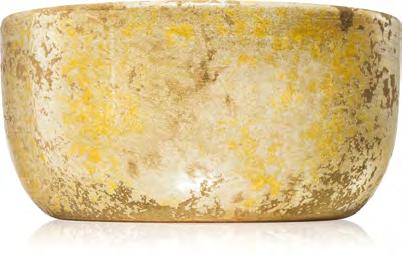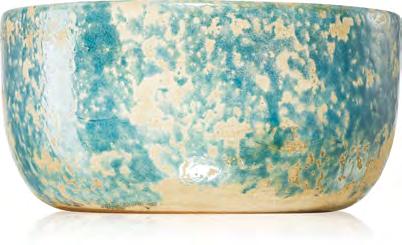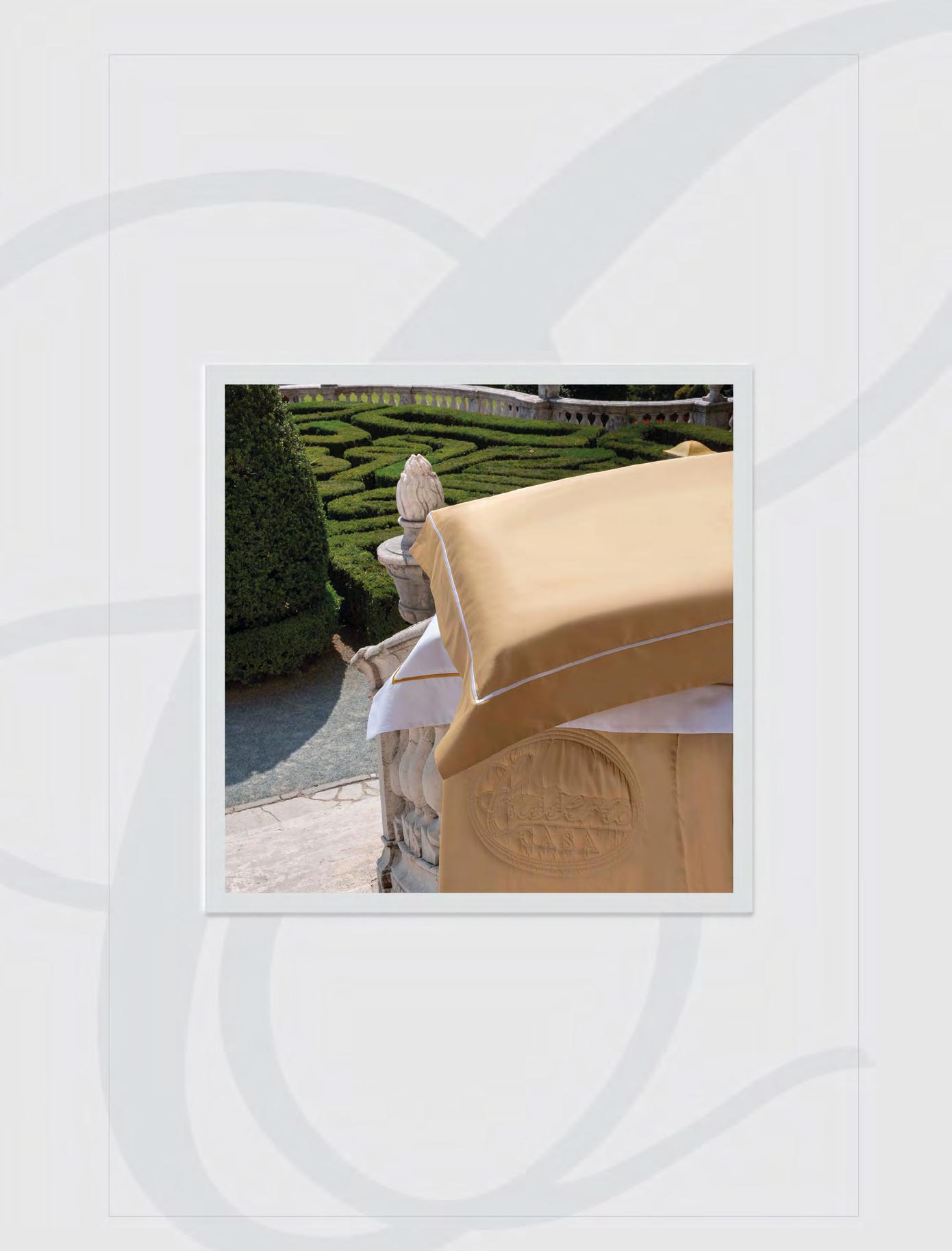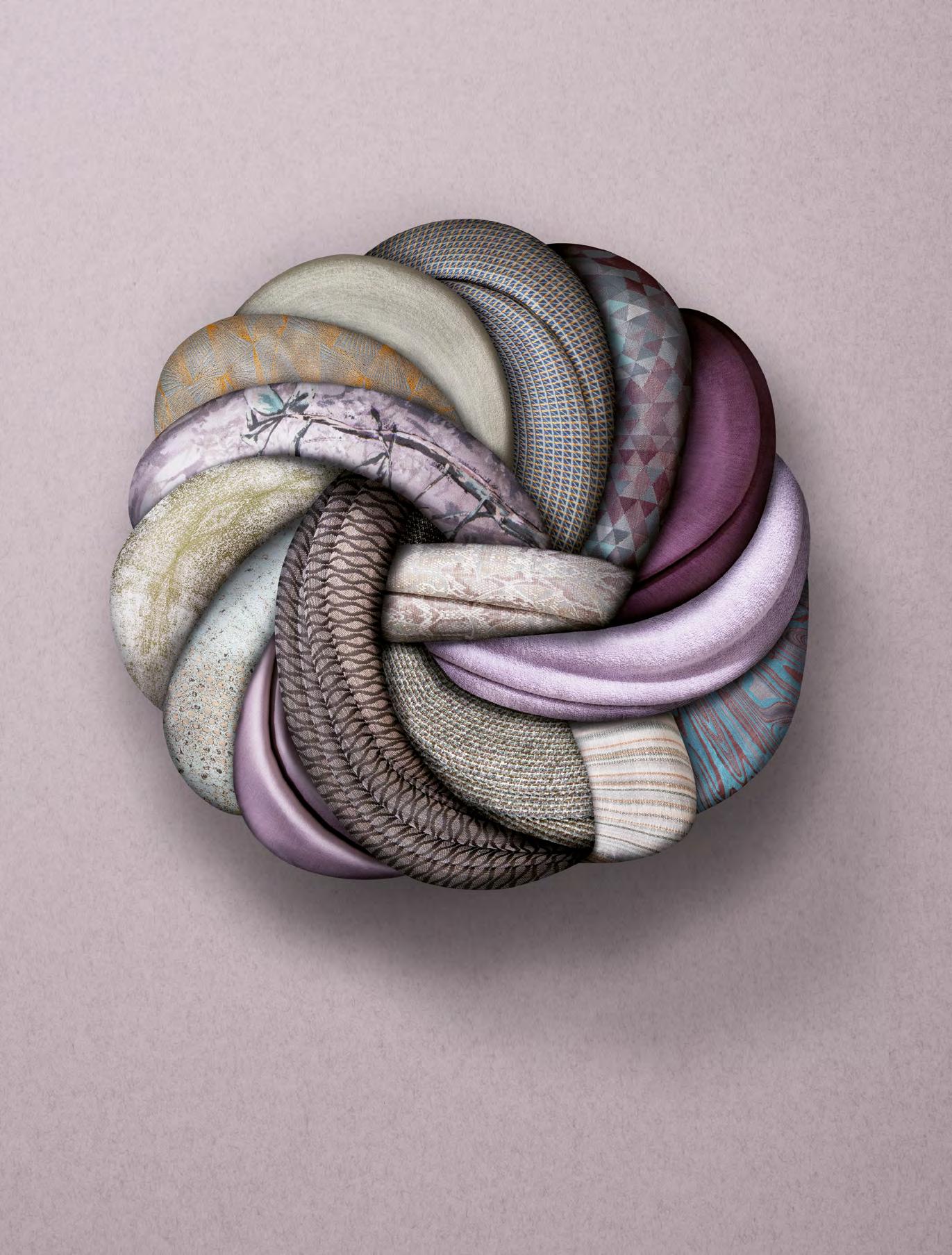L’arredo
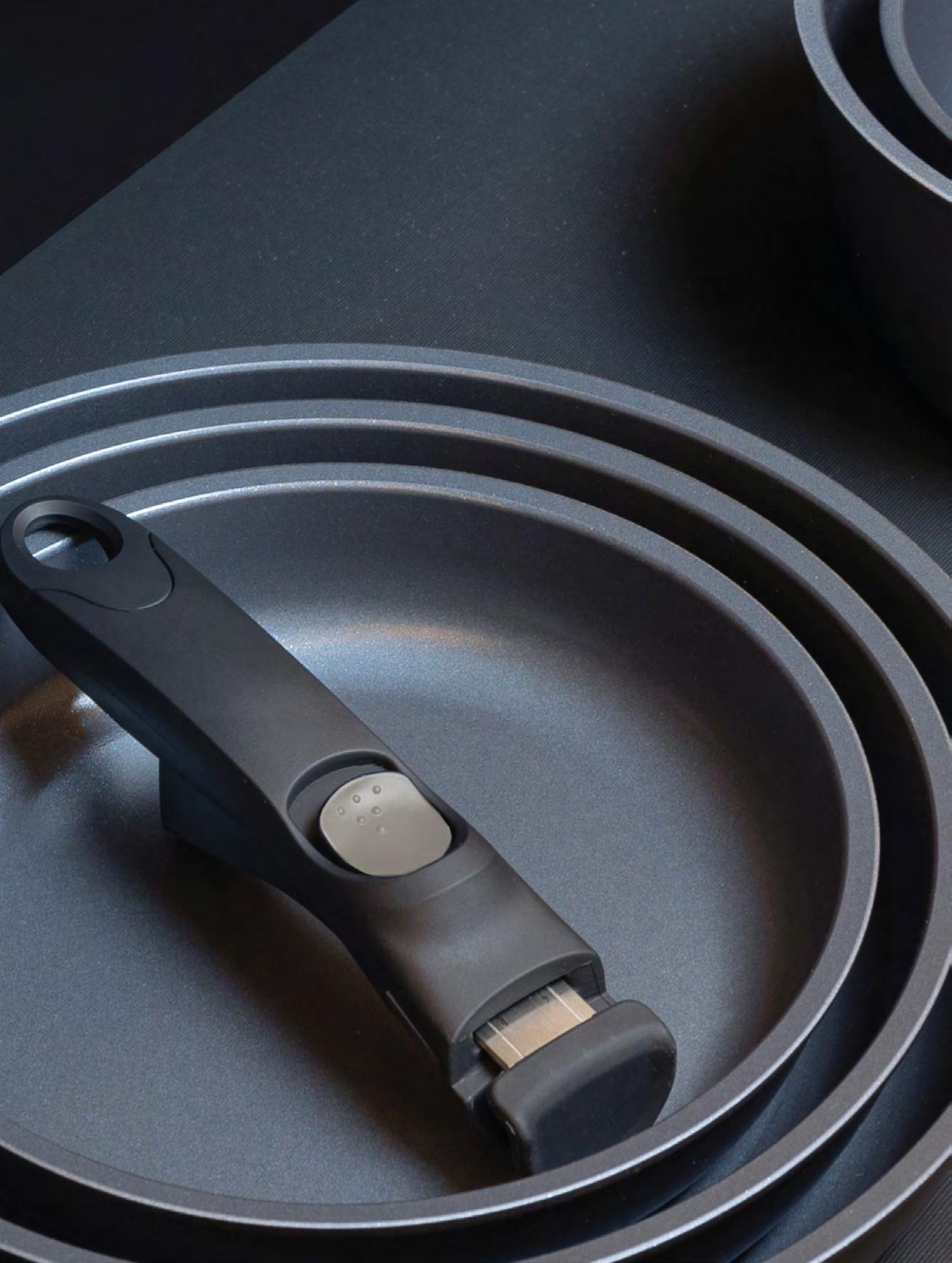

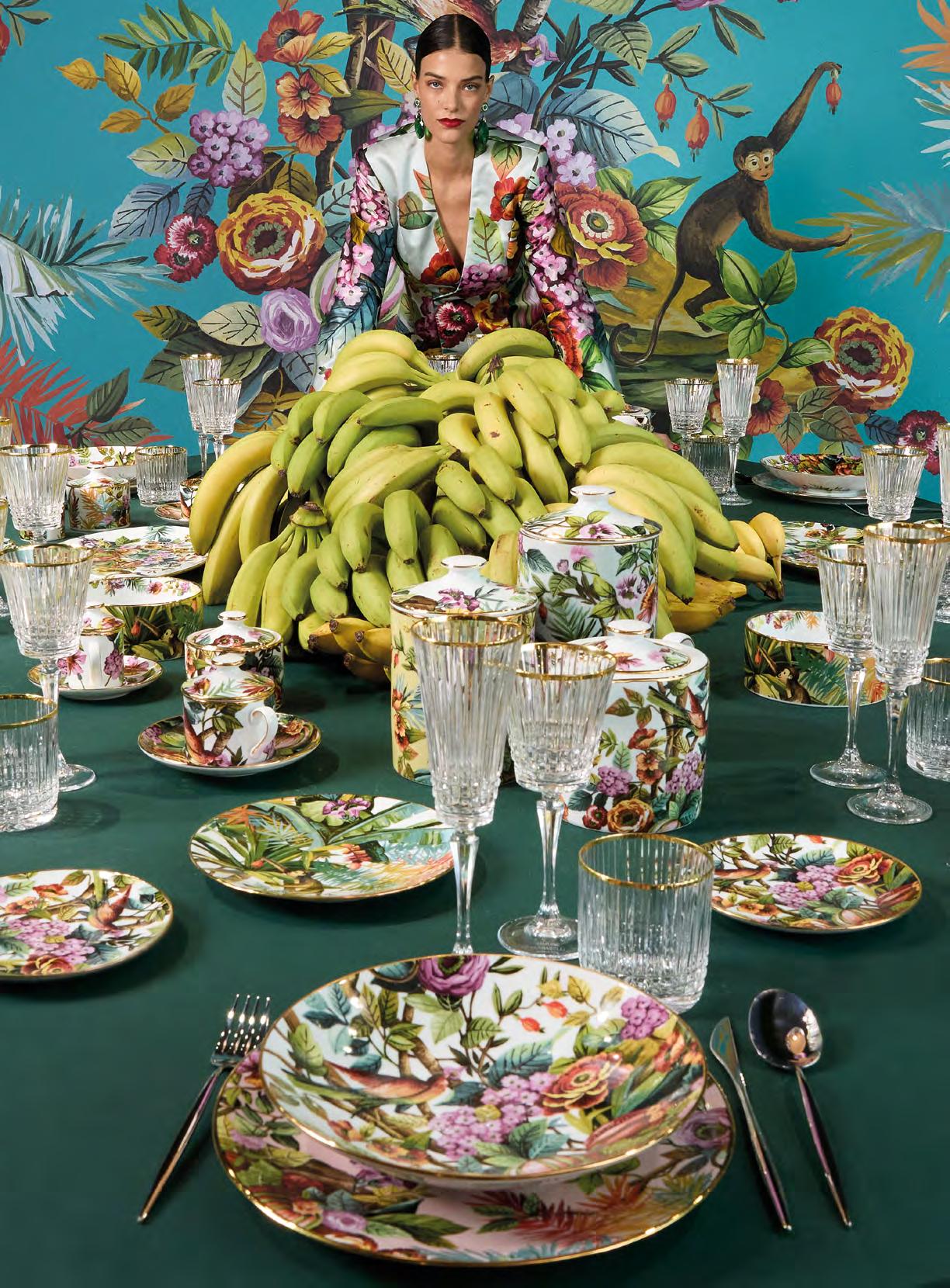
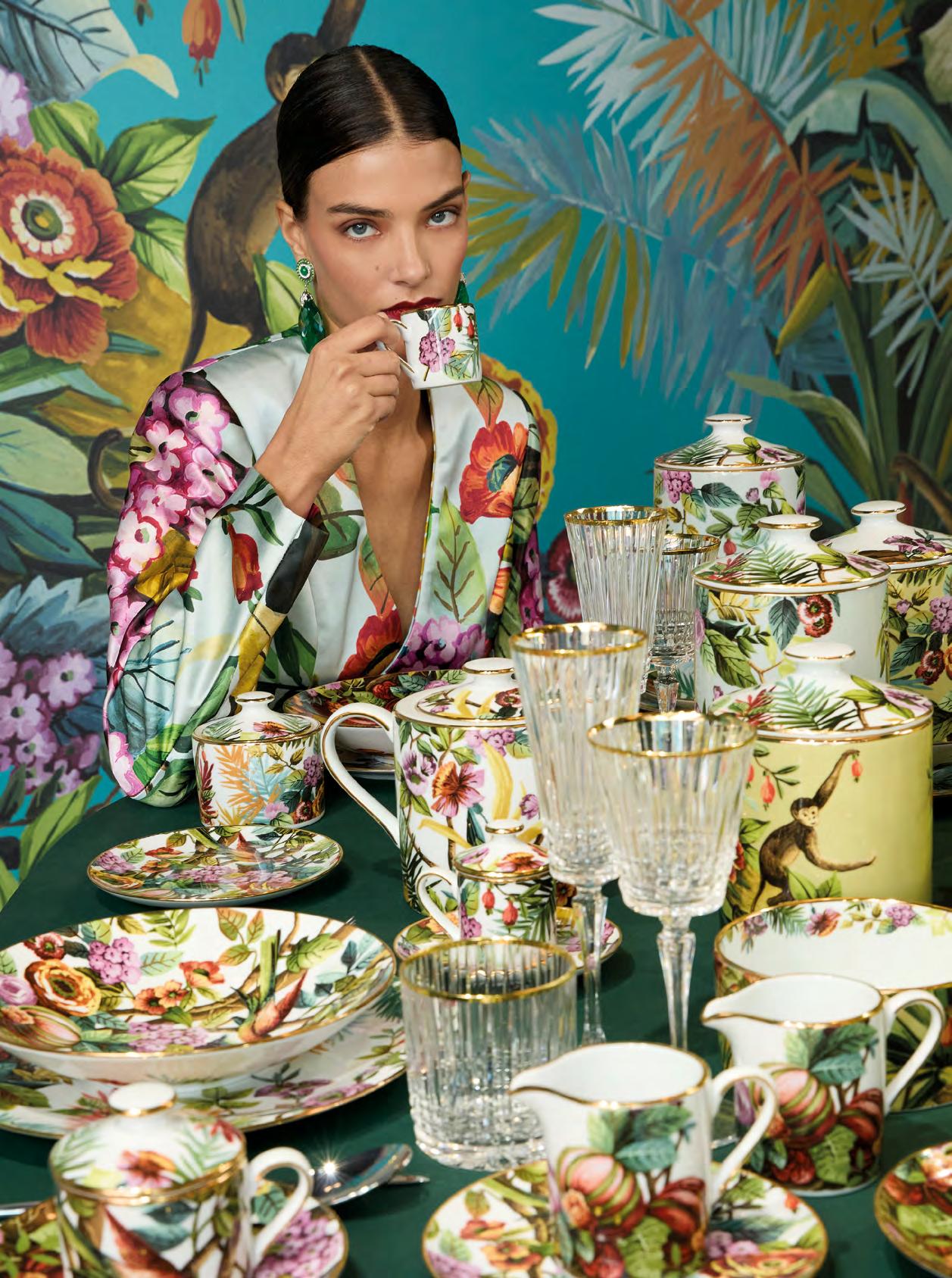
10 COVER STORY
Kéramos expands: superior performance and Made in Italy quality
14
MARKETS
Outdoor tableware: a growing global trend
22 MATERIALS
The material makes the pot... and the perfect cooking

L’arredo




Kéramos expands: superior performance and Made in Italy quality
14
Outdoor tableware: a growing global trend
22 MATERIALS
The material makes the pot... and the perfect cooking
46 EVENTS
Report from the rst trade fairs of the year: foundations for a 2025 full of developments and new inspirations for the industry
52 ULDERICO LEPRERI
Manufacturing on stage: the vision and work of Ulderico Lepreri
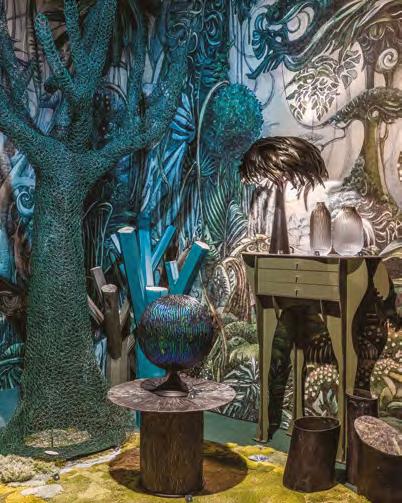
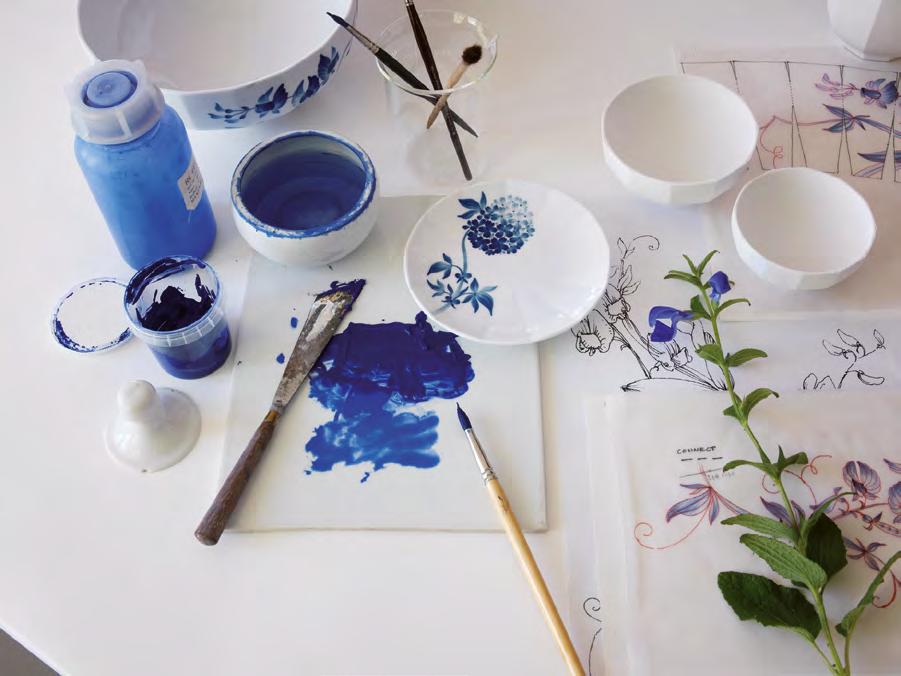
58 HERITAGE MARKETING
When heritage makes the brand excel
70 TEXTILES IN&OUTDOOR
From curtains to wall coverings, including cushions and weatherresistant furniture

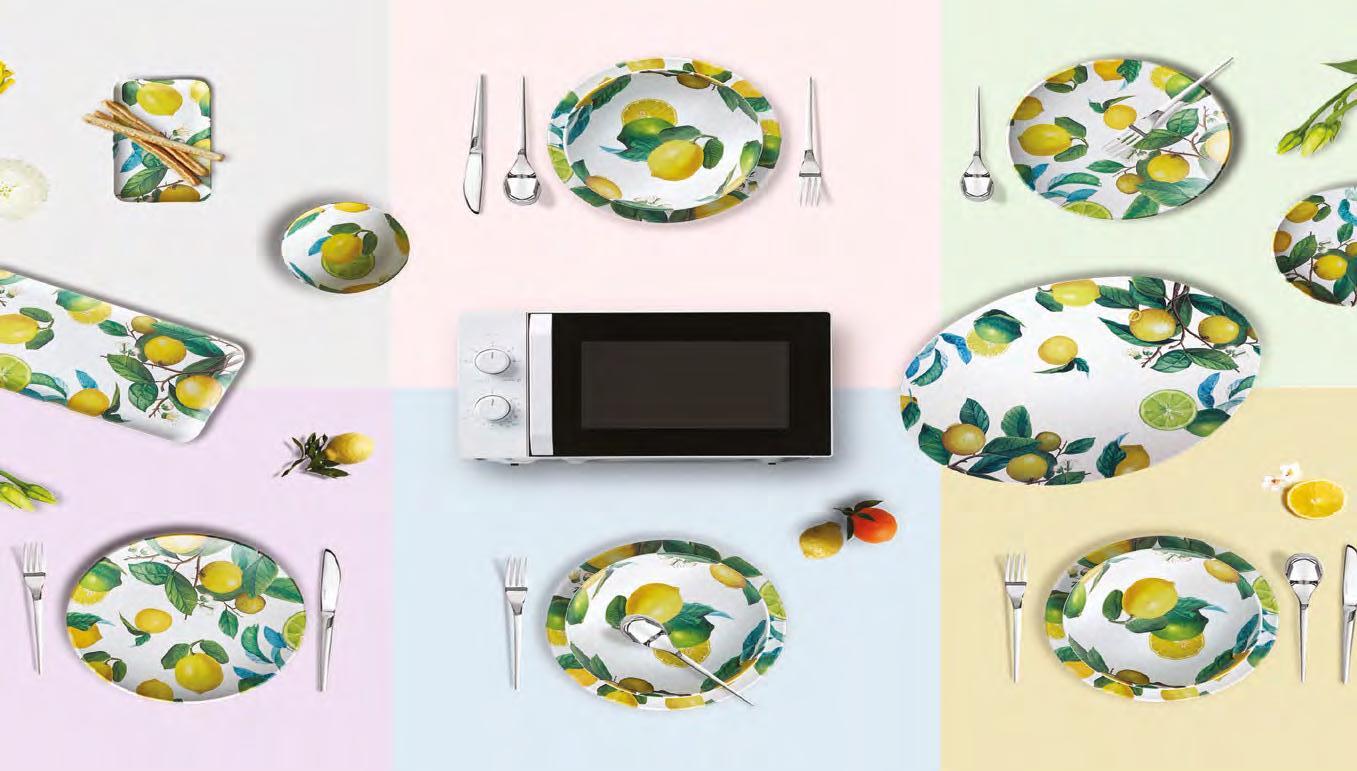
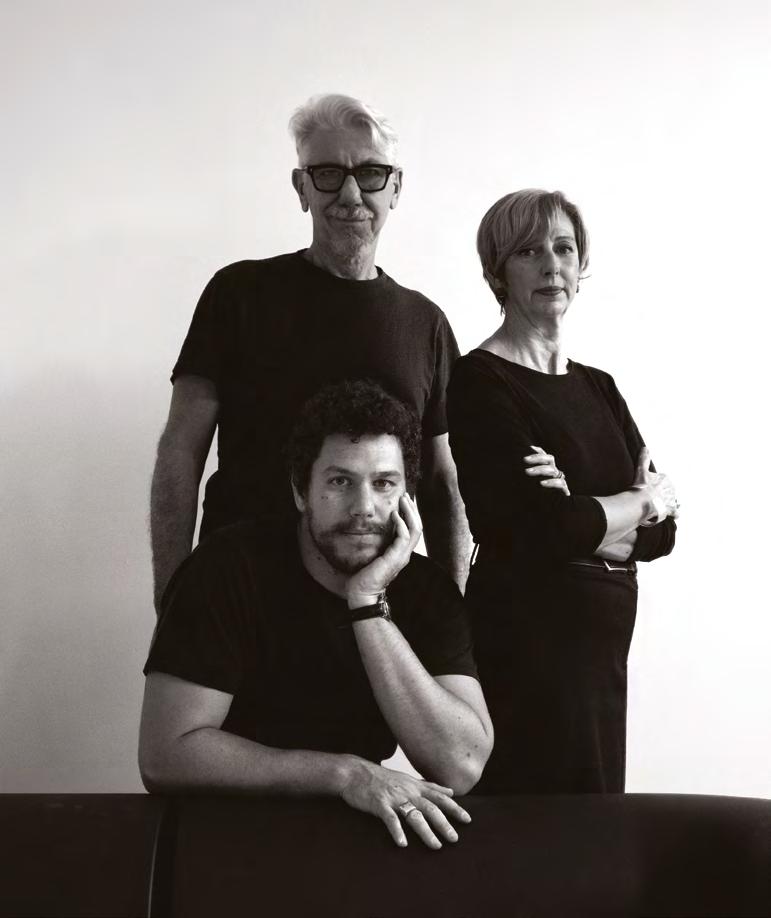
Summer table settings for terrace, garden and... boat
16
How the outdoor world is rede ning its relationship with the indoor: a conversation with architect Marco Marin
42
MATTEO BLANDI
The Arcturus Group focuses on digital and brand strategy for 2025: interview with matteo blandi, new chief marketing of cer
64
The future of glass between sustainability, design and new trends
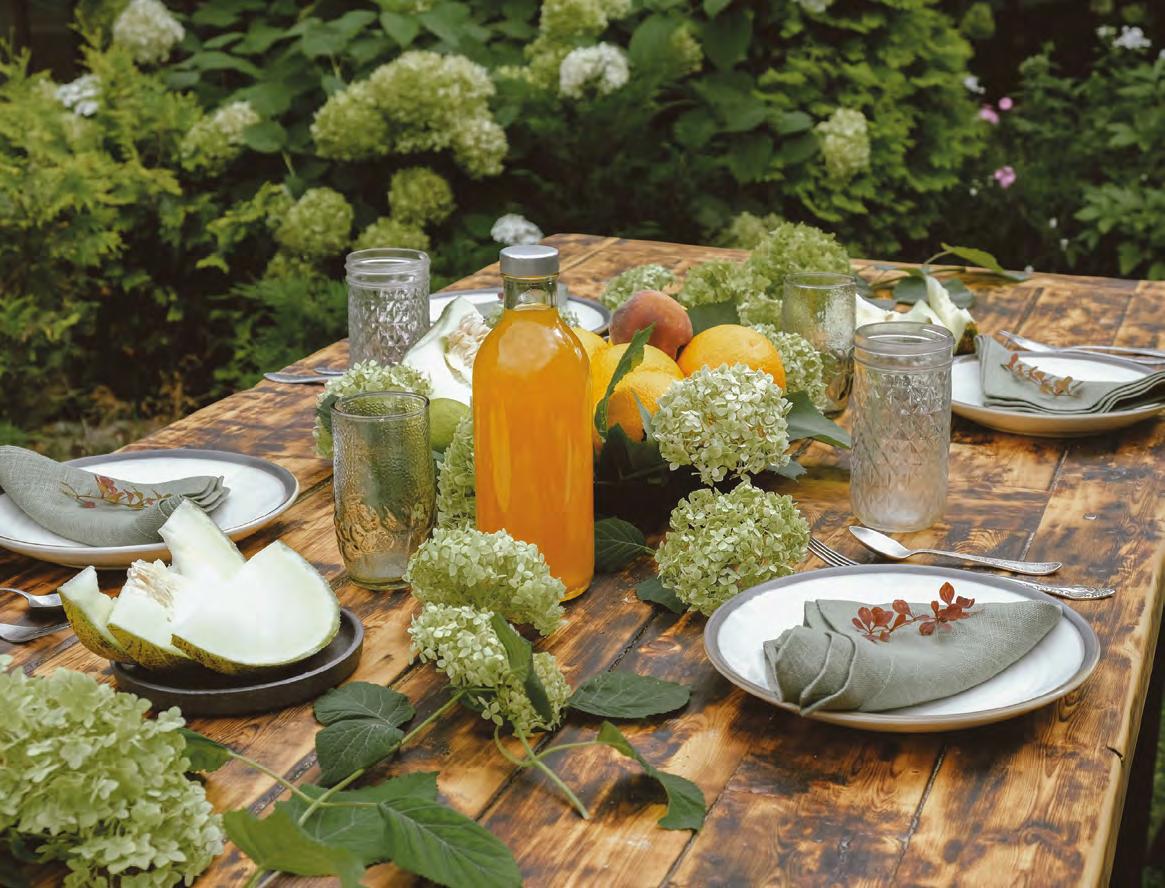
76
The new fabrics to dress the home “inside and out”
82
Furnishing the outdoor space
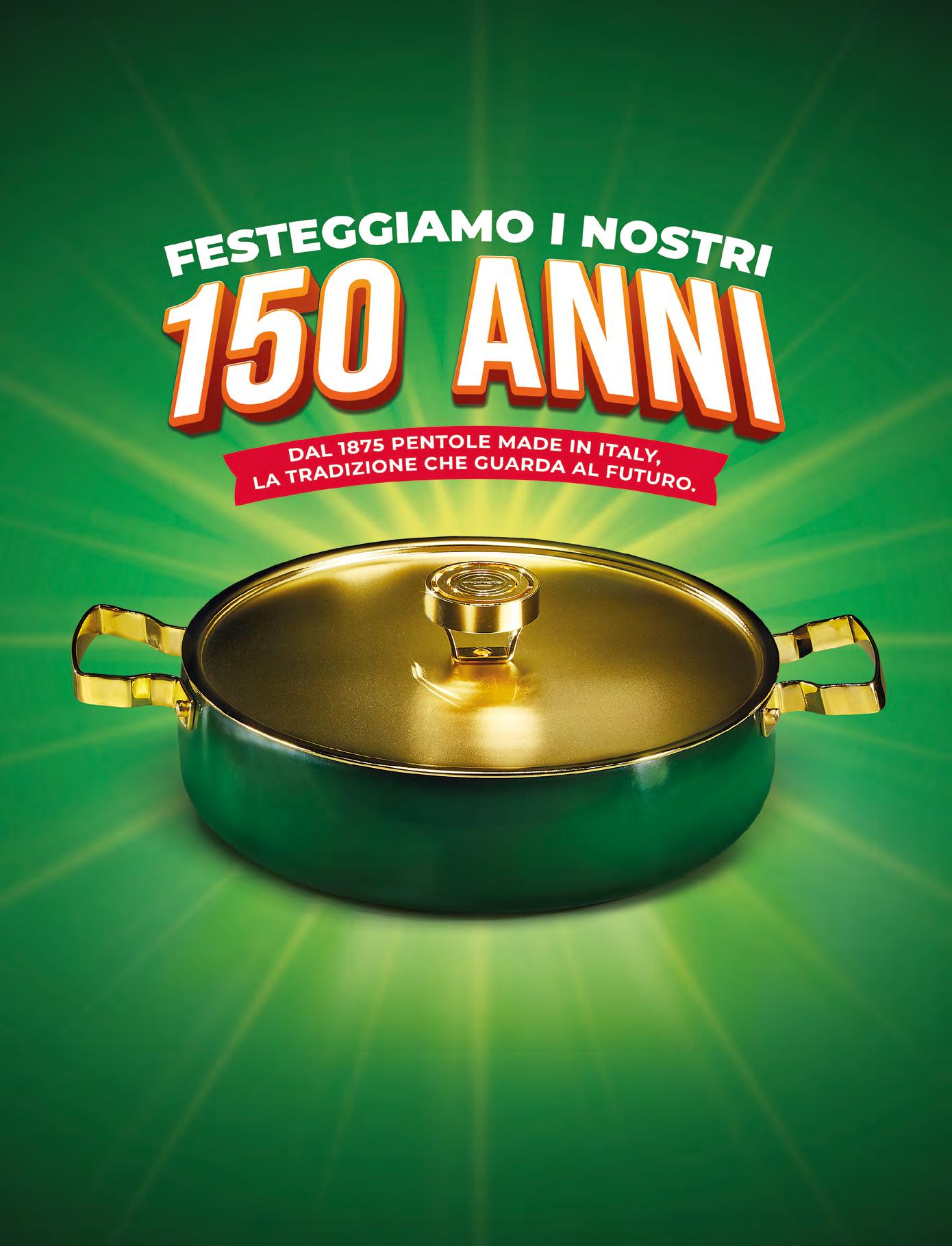
IL 2025 SARÀ UN ANNO STRAORDINARIO!
Moneta celebra 150 anni di innovazione e stile nel mondo della cucina, con 12 mesi di iniziative esclusive e promozioni dedicate per animare i punti vendita e rafforzare il legame con i nostri clienti, attività promozionali, materiali di comunicazione e contenuti social dedicati per raggiungere più persone possibili.
Contattaci per scoprire tutti i dettagli e prepararti a vivere un 2025 indimenticabile insieme a Moneta! Grazie per essere parte della nostra storia e del nostro futuro.


Organo ufficiale ART
arti della tavola e del regalo
-
Bimestrale - 434 Marzo 2025 - www.casastileweb.it
EDITORE
EDIBRICO srl con socio unico
Viale Emilio Caldara, 44 - 20122 Milano
DIRETTORE EDITORIALE E RESPONSABILE
Nicla de Carolis - decarolis@edibrico.it
CONSULENTE EDITORIALE
Giulia Arrigoni - giulia.arrigoni@edibrico.it
COORDINATORE DI REDAZIONE
Laila de Carolis - laila@edibrico.it
GRAFICA E IMPAGINAZIONE
Gabriele Curato - gabriele.curato@edibrico.it
SEGRETERIA DI REDAZIONE
Patrizia Ferrari - p.ferrari@edibrico.it
Claudia Cazzulo - claudia@edibrico.it
IN REDAZIONE
Mauro Balbi, Francesco Poggi redazione.casastile@edibrico.it
COLLABORATORI
Fabio Destefani, Francesca Guerini Rocco, Patrizia Pagani
IMMAGINI
Shutterstock
DIRETTORE COMMERCIALE
Cesare Gnocchi - cesare.gnocchi@tecnichenuove.com
SVILUPPO COMMERCIALE
Monica Sposito - monica.sposito@newbusinessmedia.it
UFFICIO COMMERCIALE VENDITA SPAZI PUBBLICITARI: Milano, Via Eritrea 21 - tel. 02 92984481 - commerciale@tecnichenuove.com
Anna Boccaletti (coordinatore) anna.boccaletti@newbusinessmedia.it
UFFICIO TRAFFICO E PUBBLICITÀ
Lorena Villa - lorena.villa@newbusinessmedia.it - tel. 02 92984542
ABBONAMENTI
Tariffe per l’Italia: cartaceo annuale 22,00 euro; cartaceo biennale 34,00 euro.
Modalità di pagamento: sul sito www.edibrico.it; Conto corrente postale n.13844469
intestato a: EDIBRICO - loc. Vallemme, 21 15066 Gavi (AL) Bonifico bancario su Iban: IT43Q0623048310000046330946
L’abbonamento avrà inizio dal primo numero raggiungibile. Servizio clienti: 0143 645037 - abbonamenti@edibrico.it
STAMPA
Faenza Printing Spa - Via Vittime Civili di Guerra, 35 - 48018 Faenza (RA)
Copyright EDIBRICO SRL
La riproduzione delle illustrazioni e degli articoli pubblicati dalla rivista, nonché la loro traduzione è riservata e non può avvenire senza espressa autorizzazione della Casa Editrice. I manoscritti e le illustrazioni inviati alla redazione non saranno restituiti, anche se non pubblicati e la Casa Editrice non si assume responsabilità per il caso che si tratti di esemplari unici. La Casa Editrice non si assume responsabilità per i casi di eventuali errori contenuti negli articoli pubblicati o di errori in cui fosse incorsa nella loro riproduzione sulla rivista.
REGISTRAZIONE
Tribunale di Milano n.392/72
ROC n. 34848 del 26 agosto 2020
ISSN 0390-1512




















Heritage marketing is the communication activity that leverages a brand’s historical legacy to strengthen its positioning in the market. No country can rival Italy in the number and quality of manufacturing/artisanal companies that have turned their products into household names—often used to identify similar products from other brands. Take for instance the MOKA, the coffee pot invented by Alfonso Bialetti in 1933, with over 320 million units produced; today, the word itself has become synonymous with "coffee maker."
Starting on page 58, you’ll nd interesting interviews with managers of renowned companies, both Italian and international, who jealously preserve their heritage while driving innovation to ensure products meet customers’ demands for reliability, traceability, and longevity— now more than ever.
Indeed, iconic products with pricing aligned to their quality—in terms of materials, craftsmanship, and design—sometimes even heirloomworthy, perfectly t into the sustainability roadmap required by the times.
In the article from page 52, you’ll also nd a showcase of objects photographed at the exclusive Milano Home exhibition. These pieces of furniture—or rather works of art—are made by companies with centuries of history. Seguso, the renowned Murano glassworks, boasts 23 generations of craftsmanship. There are also companies considered historic in other industries, such as Barazzoni, just to name one. With over a century of experience, Barazzoni continues to innovate, offering cookware with highly performing ceramic coatings that promote healthier cooking, along with removable handles for optimized storage.
The opportunities to capture customer interest certainly don’t end here: another key topic in this issue is "outdoor living," driven by the growing demand for beautiful, harmonious outdoor furnishings. Companies are responding with endless solutions, and you'll nd insights from a sector specialist starting on page 16.
Nicla de Carolis
Barazzoni enhances the Kéramos line: nextgeneration ceramic coating, completely PFAS Free, and smart spacesaving design
Following the great success of the Kéramos collection, Barazzoni continues to invest in cutting-edge materials and expands the range with Kéramos Facile. The new line features an advanced, PFAS-free ceramic coating—already a hallmark of the Kéramos collection— and a practical, functional design, perfect even for the most demanding home chefs. With this launch, the company further enriches its offering with solutions tailored to those who value quality, safety, and sustainability in the kitchen.
An Ongoing Success: Barazzoni’s Kéramos, the Collection that Revolutionized Cooking with its Natural, High-Performance Ceramic Coating.
Kéramos: sustainable, health-safe, and versatile
Launched in early 2024, the Kéramos collection quickly gained recognition thanks to its state-ofthe-art ceramic coating (tested and free from heavy metals, PFAS, nickel, PTFE, PFOA, and BPA). This coating ensures even, crispy cooking while preserving the nutritional properties of food. The natural coating is four times more non-stick than traditional ceramic treatments, offering outstanding durability and resistance.
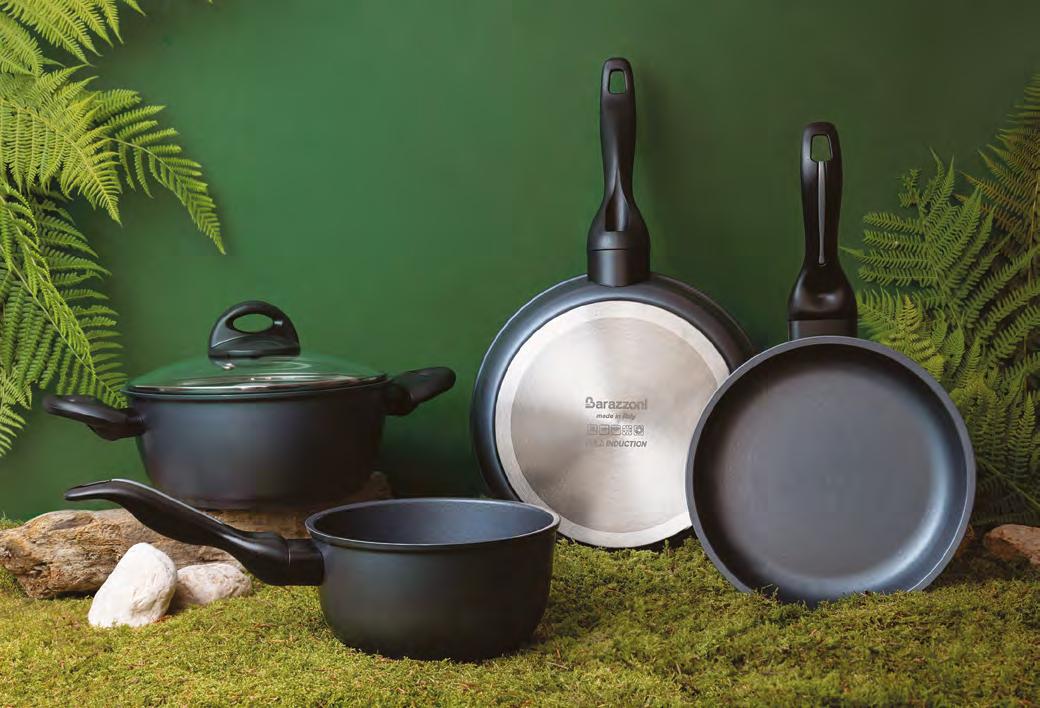
To meet the needs of those looking for space-saving and highly functional solutions, Barazzoni has developed Kéramos Facile, a version of the collection featuring removable handles. This practical system reduces clutter in the kitchen and allows pots to be easily stored, optimizing space even in the smallest drawers. The ergonomic handle ensures a safe and comfortable grip and can be detached with a simple click, depending on how the cookware is being used.
Kéramos Facile is designed for a versatile user experience: the cookware can move seamlessly from stovetop to oven, to table, to refrigerator, and be sto-
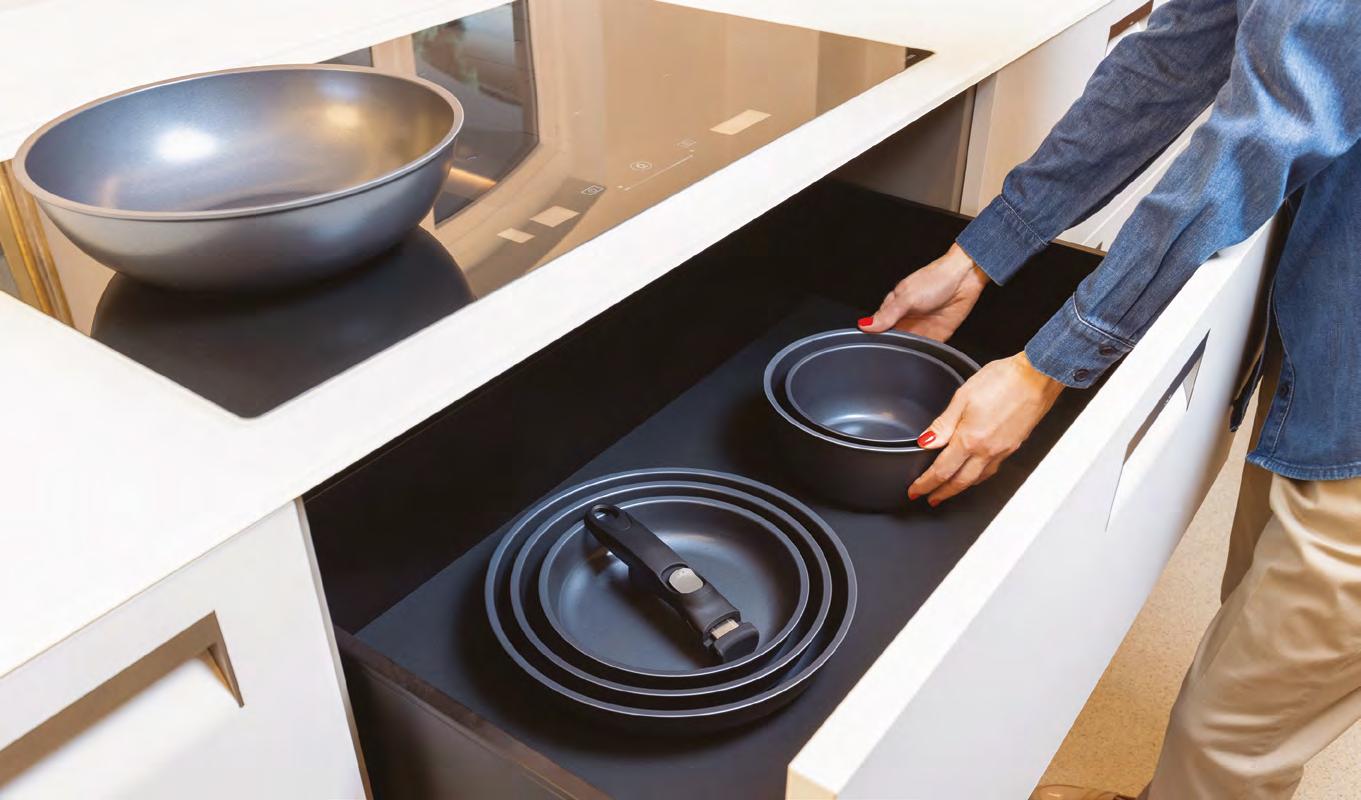
Kéramos Facile, with a detachable handle and space-saving design, offers maximum versatility without compromising
red while taking up minimal space. Additionally, the next-generation ceramic coating promotes healthier cooking.
Glass lids allow for easy monitoring of food without lifting them, helping to retain heat and moisture inside the pot.
The latest addition to Barazzoni’s range is a collection of enamelled cast iron cookware, designed to enhance slow-cooked dishes. This material distributes heat evenly and consistently, helping food retain its natural juices while preserving avor and texture.
Scratch-resistant and excellent at maintaining temperature over time, enamelled cast iron is perfect for braising, stewing, and frying. It is also highly versatile: it can be used on the stovetop, in the oven, and brought straight to the table.
The moisture-retaining lid ensures perfect, even cooking results.
Available in matte black and glossy red nishes, the collection includes casseroles in various sizes and shallow pans to suit every kitchen need.
Barazzoni: The Quality of Made in Italy
Founded in 1903, Barazzoni is an Italian company with over a century of experience in crafting cookware, synonymous with excellence and innovation in the industry. Committed to safety and sustainability, the company aims to promote and elevate Made in Italy worldwide by producing
high-quality, long-lasting collections that reduce environmental impact while paying special attention to design, functionality, and consumer health.
The family-owned business, now in its fourth generation, still operates from its historic headquarters in Invorio (NO), Italy.
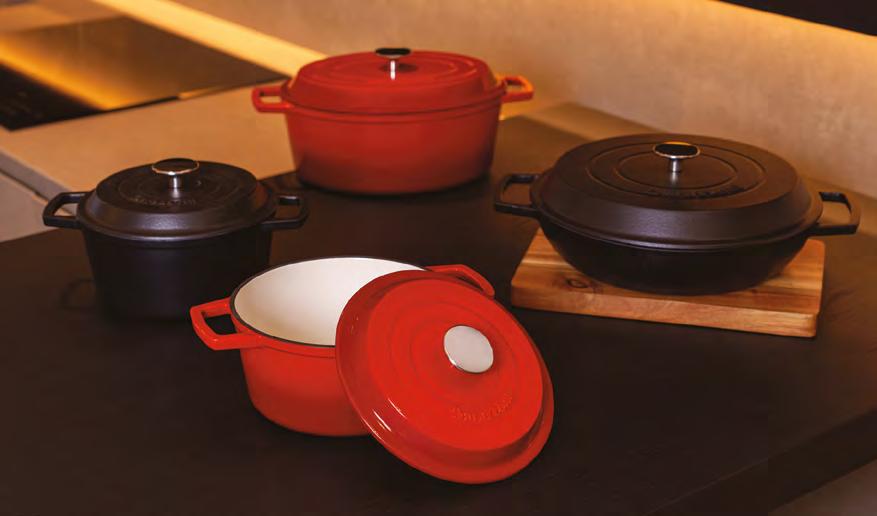
by Fabio Destefani
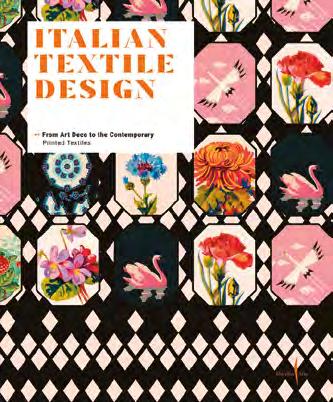
An elegant illustrated volume that tells the story of the crucial role played by stylists, artists, designers, and companies in building the reputation and quality of Italian textiles worldwide, from the early 20th century to today. More than 500 illustrations, photographs, and preparatory drawings—many previously unpublished and sourced from company and private archives—document Italy’s most signi cant creative successes. From the experiments of Lucio Fontana and Gio Ponti to the optical patterns of Germana Marucelli and the kaleidoscopic designs of Emilio Pucci; from Roberta di Camerino’s trompe-l’oeil effects to the pop sensibilities of Ken Scott, Elio Fiorucci, Gianni Versace, and Franco Moschino; from the heritage-driven work of Prada, Valentino, and Marni to Missoni’s enhancement of its historical archive, right up to the graphic hybridizations of Maison Laponte, Gentile Catone, Colomba Leddi, and Iuter.
Francesca Moscheni
While home décor may not be something we change every day, setting the table offers us this very opportunity. It can be reinvented with every meal, re ecting our shifting moods, the rhythm of the seasons, and current trends. Starting from this premise, the author takes us inside the homes of 14 interior stylists, sharing with us the pleasure and artistry of table setting. Their creative sensitivity and suggested choices serve as inspiration not only for those aiming to create impressive settings but also for anyone looking to bring a touch of artistry to their daily meals.
A thoughtfully set table is a delight for guests and even more so for the host. Selecting and arranging the various elements, combining colors and shapes, and organizing seating arrangements transform the host into a true director of conviviality.
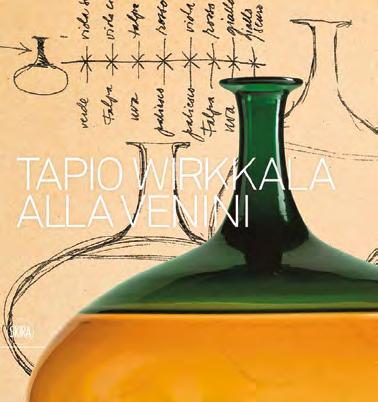
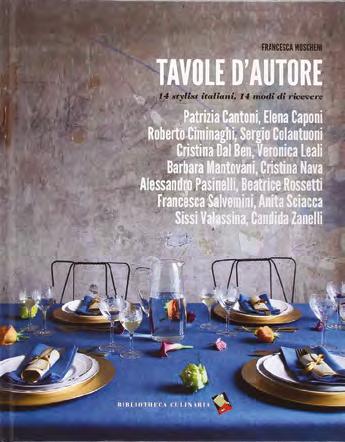
A great sculptor and glass designer, Finnish artist Tapio Wirkkala created works that are now housed in the world’s most renowned museums, from the MoMA in New York to the Centre Georges Pompidou in Paris. In 1965, he arrived in Murano at the invitation of Venini’s young director, architect Ludovico de Santillana, who was drawn to Nordic design, also as part of an effort to revitalize the company’s international production. This volume is dedicated to that fruitful collaboration and illustrates how Wirkkala approached the Murano experience with enthusiasm, supported by the extraordinary skills of the glassmakers, with whom he established a remarkable rapport.
Building on the company’s tradition, Wirkkala was able to contemporize Venini’s production, with signi cant in uence on modern Murano glassmaking.
The new collection by Vidivi, designed by Anima Laboratorio, celebrates the art of tasting with style and functionality
Elegance and transparency come together in the professional Divina Eterea glasses, designed to deliver a tasting experience without compromise. Made from Lumina crystalline glass, free of lead, machine-blown with pulled stem and cold-cut rim, they are available in three sizes (84 cl, 57 cl, and 47 cl).
The Divina Eterea collection sets a new benchmark in the world of wine tasting and luxury tableware, blending essential design with technical innovation to transform every food and wine experience into a special moment.
Designed by Anima Laboratorio, the creative studio of CERVE GROUP, these glasses are the result of meticulous research aimed at enhancing the organoleptic properties of wines while elevating the elegance of the table.
Made from Lumina crystalline glass, free of lead, the glasses stand out for their exceptional clarity, lightness, and durability—ideal features for both professional and home use.
Each model, designed to optimize wine tasting and bring out aromas—from the delicate notes of sparkling wines to the complex bouquets of aged reds—re ects the excellence of the Divina Eterea collection. Created in collaboration with sommeliers and Michelin-starred chefs, the collection symbolizes re nement and technical performance, enriching the most sophisticated food and wine experiences with its timeless design.
“The creation of Divina Eterea represents the essence of our commitment: to offer exclusive, high-performance tools that make the most re ned tables truly unique,” explains the Anima Laboratorio team.
With this project, Vidivi reaf rms its role as a leader in the hospitality and ne dining sectors, offering products that celebrate the art of good living with extraordinary attention to detail. vidivi.it
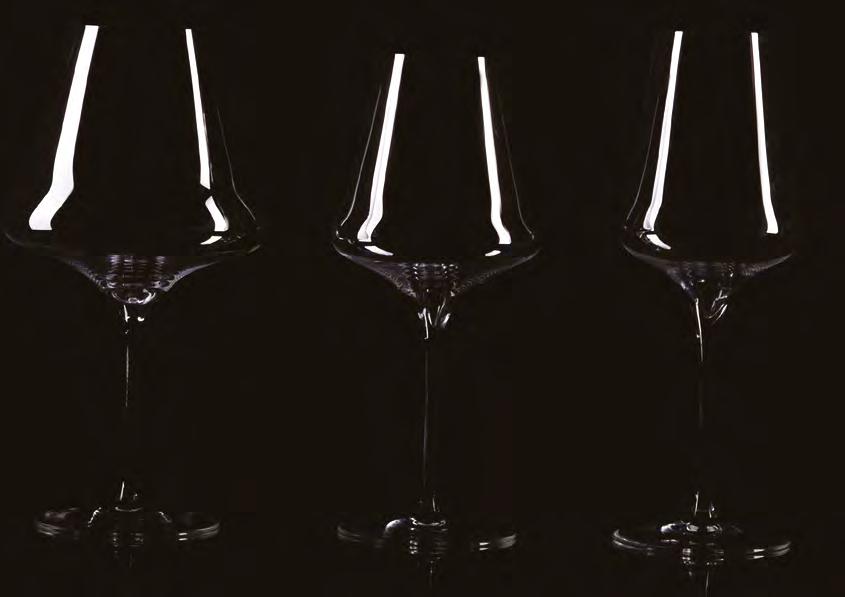
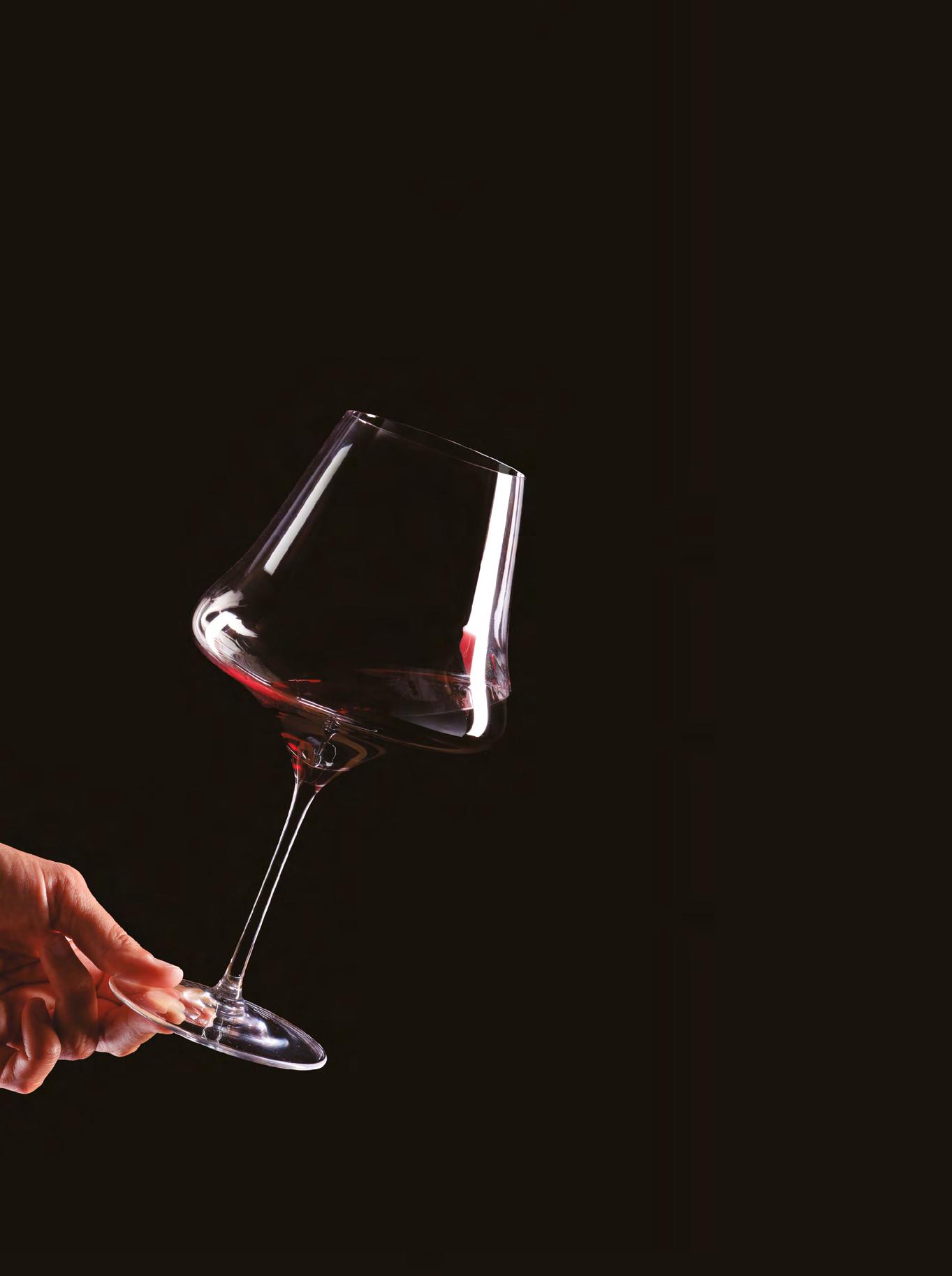
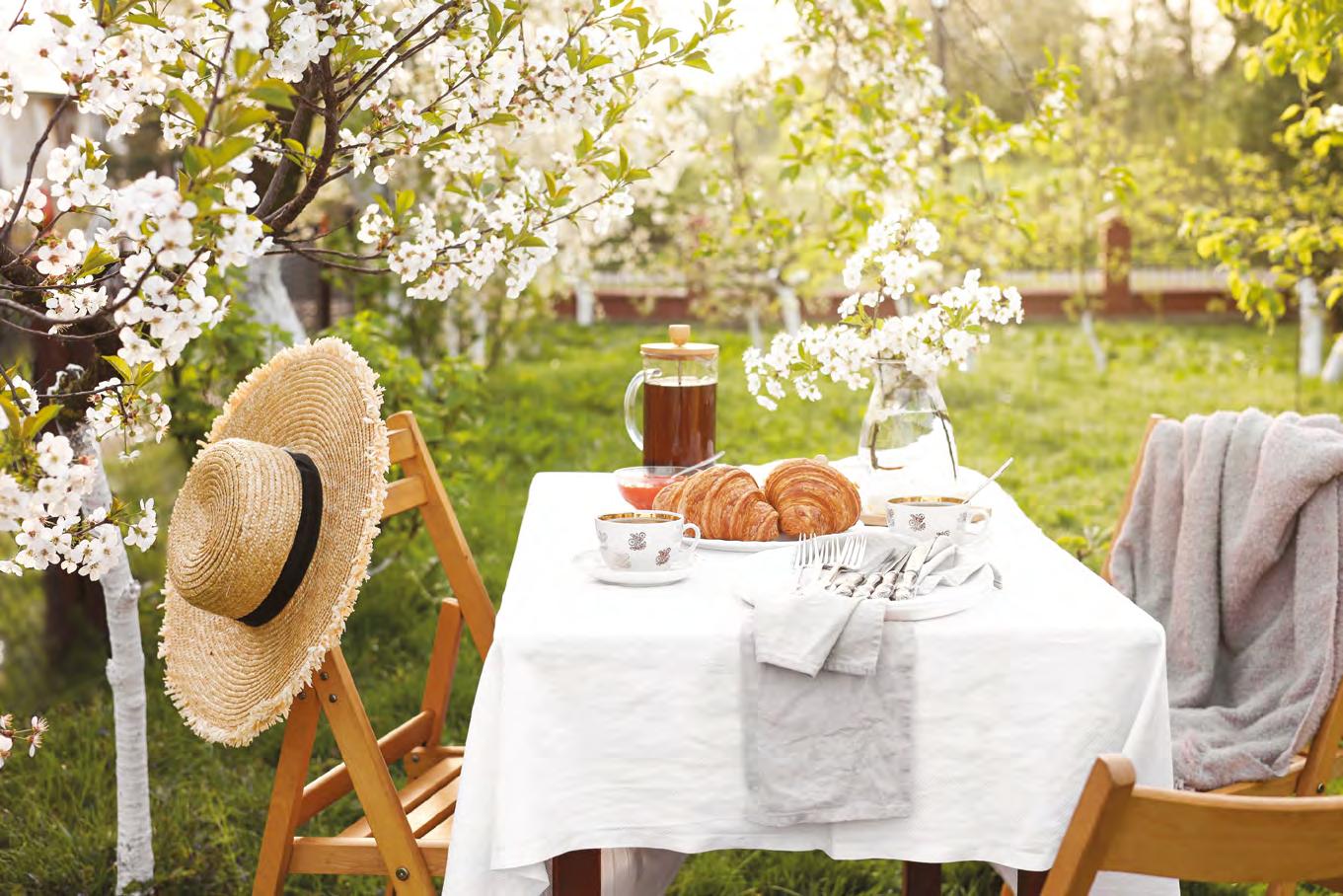
by Giulia Arrigoni
According to research conducted by Global Market Insights (GMI), a company specializing in market studies, the outdoor dining sector has experienced exponential growth in recent years, becoming a strategic opportunity for companies operating in the production and distribution of outdoor catering products. Growing consumer interest in wellness, outdoor living, and innovative design has driven the market to evolve rapidly, signi -
cantly impacting business strategies and purchasing preferences.
The study, which forecasts the global market through to 2032, indicates that the outdoor tableware sector is bene ting from increased investment in the renovation of outdoor spaces, both residential and commercial, with purchases of outdoor furniture, barbecues, and specialized tableware.
In 2023, the overall value of the outdoor table-
ware market was approximately $40 billion and is expected to grow at an annual rate exceeding 5% through 2032. In terms of product categories, beverages represent the largest segment, accounting for nearly 31% of the market. Geographically, the United States leads with just under 33% of the market, driven by a well-established outdoor dining culture and a strong inclination toward premium products. Europe follows in second place with a share of over
25%. However, the rising middle class in emerging regions such as Asia-Paci c, Latin America, and Africa, along with increasing disposable income, is boosting demand for high-end outdoor dining products, with greater attention to materials, sustainability, and functional design. Over the next seven years, Global Market Insights predicts that the most signi cant market growth will occur in Europe and the Asia-Pacic region, followed by North America.
Sustainability
Companies in the sector are responding to these trends with investments in research and development to offer innovative and high-performance products. Competition among market players is leading to an increasingly diversi ed offering, including durable tableware, multifunctional equipment, and design solutions aimed at enhancing the outdoor dining experience.
One of the key drivers of the sector is the growing preference for eco-friendly and sustainable materials. Demand for tableware and accessories made from recycled, biodegradable, and long-lasting materials is on the rise. Bamboo, stainless steel, and anodized aluminum are among the most popular choices due to their weather resistance and low environmental impact.
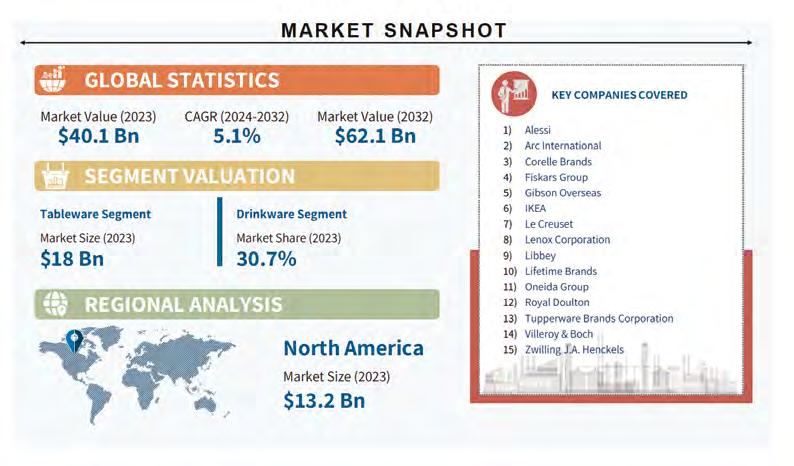
At the same time, aesthetics play a crucial role: attractive, modern designs, often inspired by social media trends, make products more appealing to both the retail market and the HoReCa sector.
Companies are investing in creating product lines that combine functionality and style, meeting the demand for practical and trendy solutions for outdoor food service.
Brick-and-mortar retail remains a key pillar for the sector (64.8%), as consumers prefer to assess product quality and design in person before purchasing. Specialty kitchenware stores, department stores, and large retail chains are expanding their sections dedicated to outdoor ta-
bleware, offering a wide range of solutions for every need. In this distribution segment, specialized retail continues to hold its position as the primary channel for such purchases, recording an increase of nearly one percentage point. However, generalist "home goods" stores are gaining market share at a faster pace, growing from $6.7 billion to $7.2 billion in just two years (+7.4%).
E-commerce is also growing (+6.8%), though at a slower pace compared to certain of ine retail categories. The rise in online sales is supported by brands adopting omnichannel strategies to provide a seamless and personalized shopping experience, integrating digital storefronts, interactive tools, and targeted promotions to attract new customer segments.

DESIGN
by Fabio Destefani
Thanks to an increasingly refined and designoriented product offering, the world of outdoor living is redefining its relationship with indoor spaces. We discussed this and other topics with architect Marco Marin
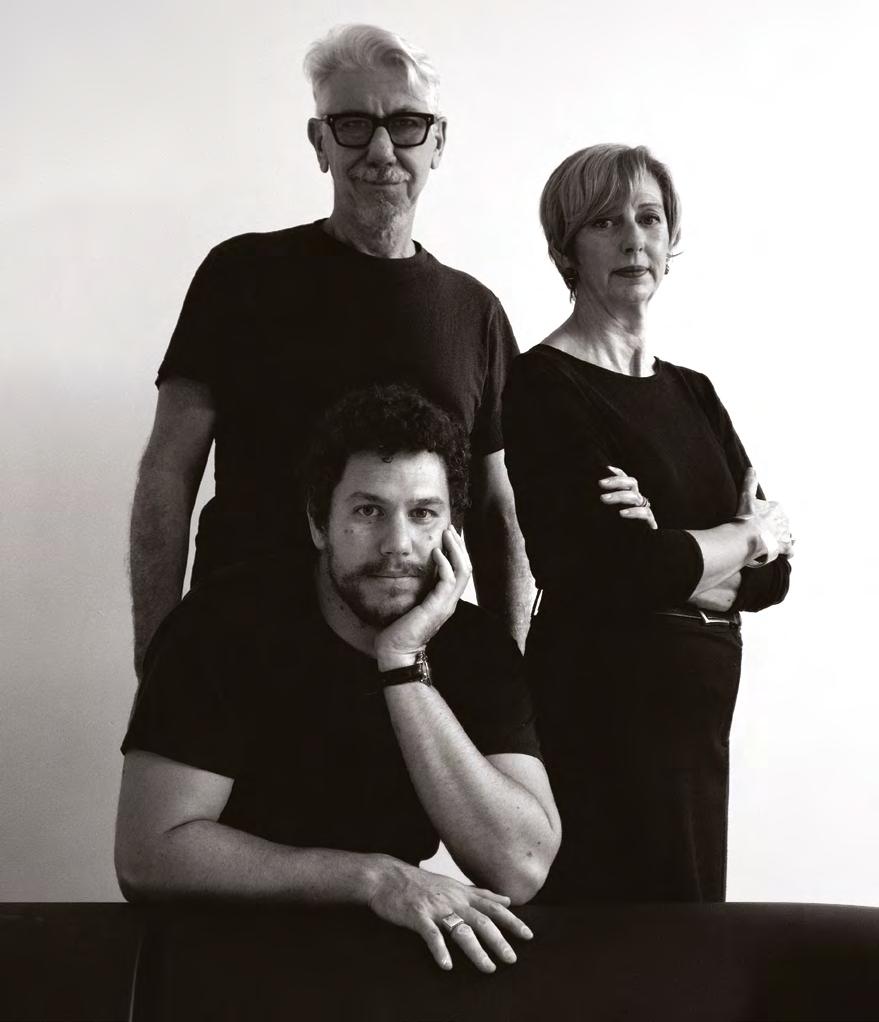
Marco (top left), Carolina, and Lorenzo Marin, the members of LCM Marin Design
When did outdoor spaces begin to emerge as a design sector worthy of attention?
Thanks to my long-standing collaboration with Emu, it’s a sector I’ve been involved in for many years, and I would say its evolution has been ongoing for over thirty years. When I started working in outdoor design, there were far fewer companies operating in the sector, and the product offering was much more limited. Outdoor furniture back then was mainly targeted at the contract market—restaurants and bars—and much less at the domestic sphere. Over time, people began to value their outdoor spaces, wanting to furnish terraces, gardens, etc., with aesthetically pleasing and functional products. It’s been a slow but steady process that has led us to today, where the focus on outdoor design is comparable to that of interiors.
Proof of this is the fact that many companies now create products suited for both settings. Of course, even in the 1950s and 60s, there was outdoor furniture—sun loungers, umbrellas, etc.—but these were exclusive pieces, reserved for the upper classes. As mentioned, outdoor living evolved from an elitist phenomenon to a mass-market trend about 30 years ago.
Outdoor design is booming today. How do you explain this trend? Did the pandemic accelerate this growth?
There’s no doubt that during the pandemic, there was an extraordinary surge in demand for outdoor products. This strong interest distorted sales forecasts for subsequent years, creating a sort of bubble. During COVID, outdoor spaces were perceived as places of freedom, whether it was a small balcony or a large garden. People wanted to perfect these areas, spending money
they couldn’t allocate to other categories due to lockdowns. As a result, outdoor products sold very easily. However, as I mentioned, this situation didn’t last, and the sector saw a decline post-pandemic.
How is the relationship between indoor and outdoor evolving from a design perspective? Are these still treated as separate areas, or is there now some sort of osmosis, a sense of continuity?
Today, the separation between indoor and outdoor is much less distinct, also evident in the aesthetic quality of outdoor products, which makes them suitable for interiors as well. Materials, of course, may vary, as outdoor items must be weather- and UV-resistant, and sofas require different llings and systems to protect internal cushions. But aesthetically, outdoor and indoor products are increasingly similar. In this process, textiles are playing a key role. The variety of fabrics available for outdoor use today rivals that of indoor materials. Twenty or thirty years ago, outdoor textiles were very limited, but now designers are creating outdoor products that use synthetic fabrics closely resembling natural ones typical of indoor environments.
How important is sustainability in the outdoor sector?
Sustainability is becoming increasingly important for companies. However, I believe that, in
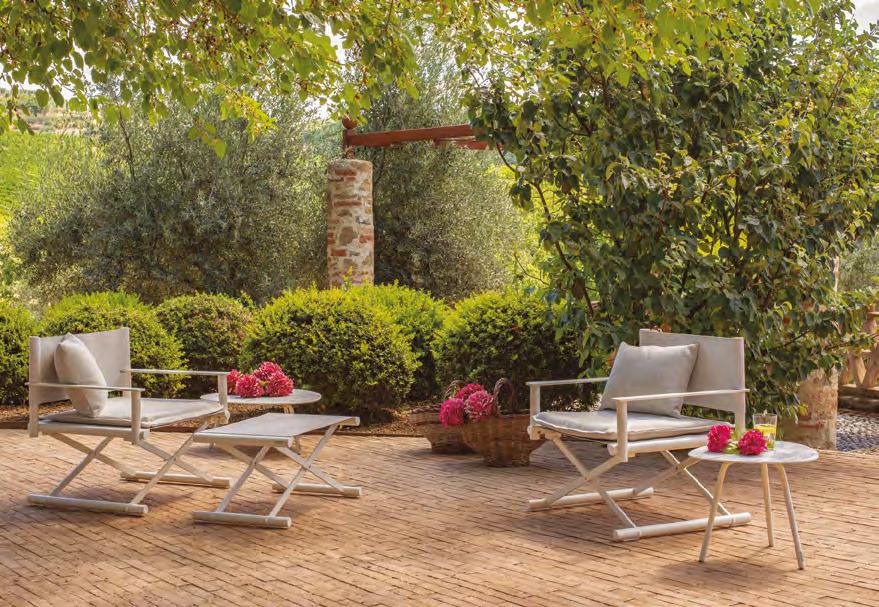
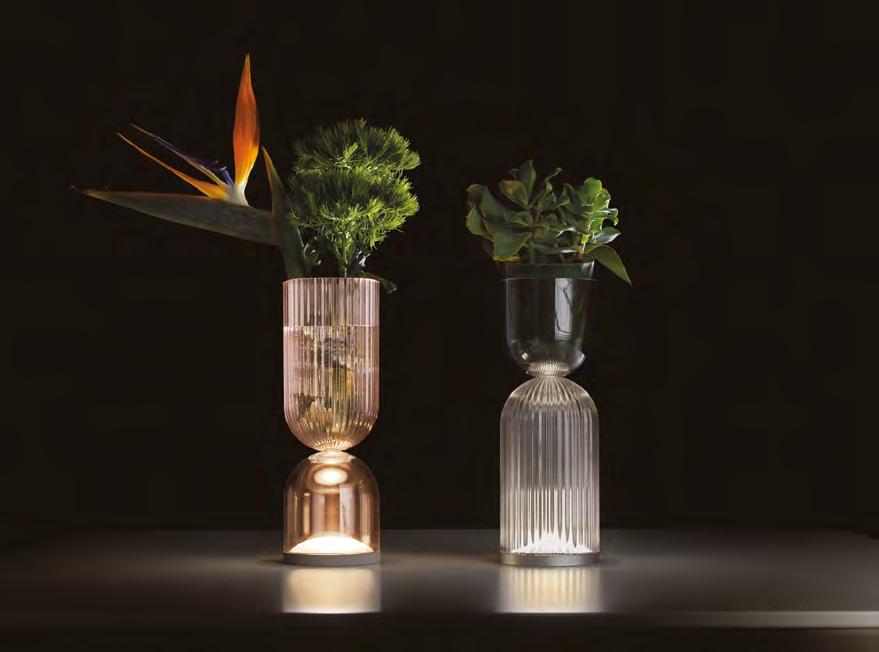
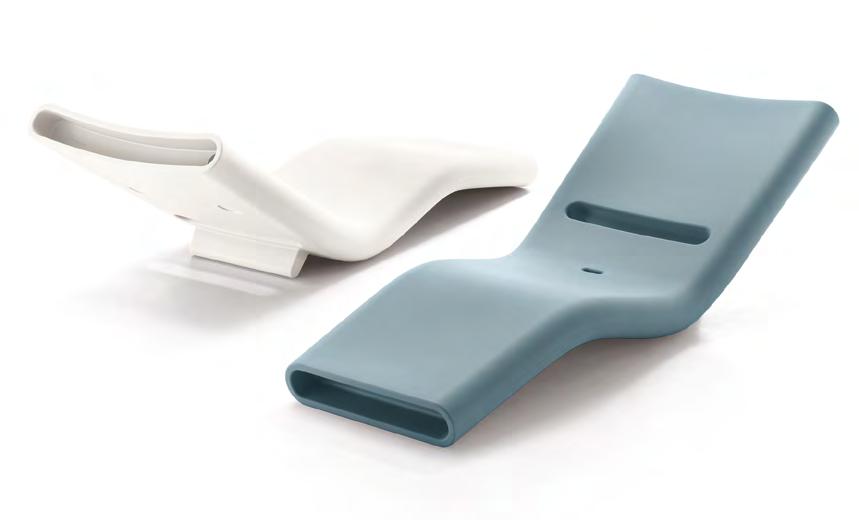
the end, purchasing decisions are still largely driven by product costs and aesthetics. Sustainability is certainly a valuable addition, but not the main driver.
Every company highlights its environmentally responsible production methods, partly for communication purposes, as public awareness on this topic is high. Regardless of companies' motivations, the key point is that sustainable choices are being made, and that has a positive impact on the environment.
How is research and experimentation with new materials evolving in outdoor design?
I wouldn't say we’re witnessing anything revolutionary, but research is progressing thanks to technological advances—special paints for metals, fabrics with enhanced outdoor resistance, etc. However, these developments are mostly imperceptible from an aesthetic point of view.
One major evolution I’ve noticed is the rise of outdoor sofas, which were rarely considered 20 or 30 years ago. Serious outdoor manufacturers know all the technical requirements needed, but when it comes to purchasing, aesthetics remain the priority. And, as we’ve discussed, that aesthetic is now closer than ever to the world of indoor living.
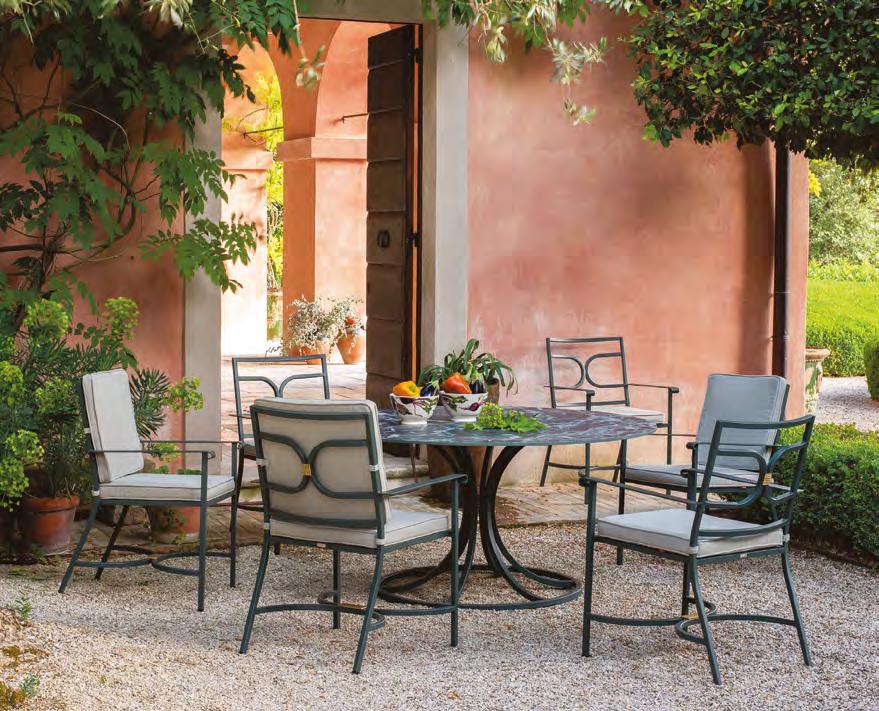
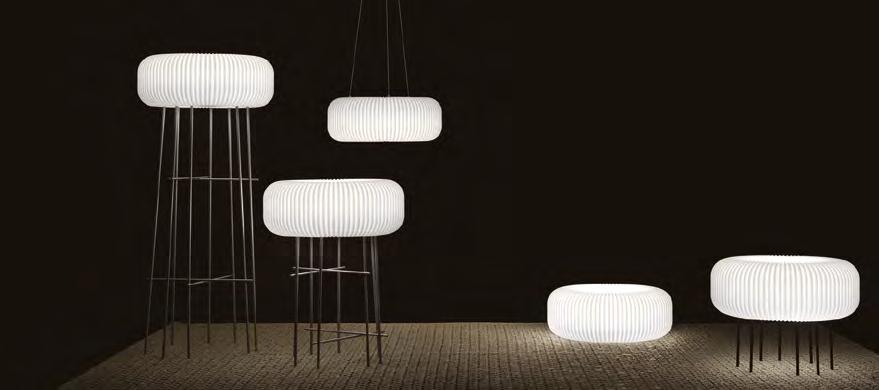
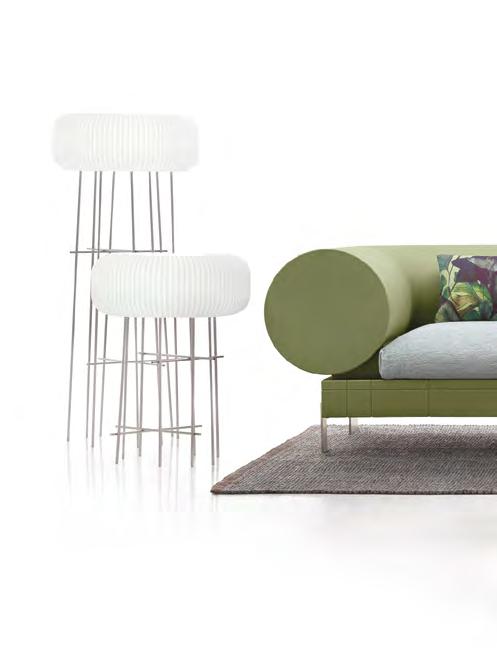
How has your own approach to outdoor design evolved over time?
I entered the outdoor world almost by chance when I began collaborating with Emu, for whom I’ve completed many projects. Recently, through my new studio (LCM Marin), we took on the artistic direction of Lyxo, a new outdoor furniture brand that’s part of Veca, a major rotational molding manufacturer based in Vicenza. Compared to injection molding, rotational molding has longer production times but requires less investment in molds. The brand offers a wide range of products—seating, sofas, tables, lamps, planters, stools. These versatile pieces are designed for outdoor use but also work well indoors thanks to their shapes and colors. In terms of lighting, I’ve also collaborated with Brokis and Hind Rabii.
Is there a stylistic continuity in your work across indoor and outdoor spaces?
Yes, every designer has their own design approach—a distinctive style that they apply across different elds. A particular design element can reappear in a chair, a sofa, or a lamp.
In your view, what are the key elements for creating an outdoor space that fosters comfort and social interaction?
I believe that, as with indoor spaces, objects need to be not only visually appealing but also comfortable, combining aesthetics with functionality. For example, I think a chair should have a speci c ratio between seat angle, backrest, and height. There are essential ergonomic fac-

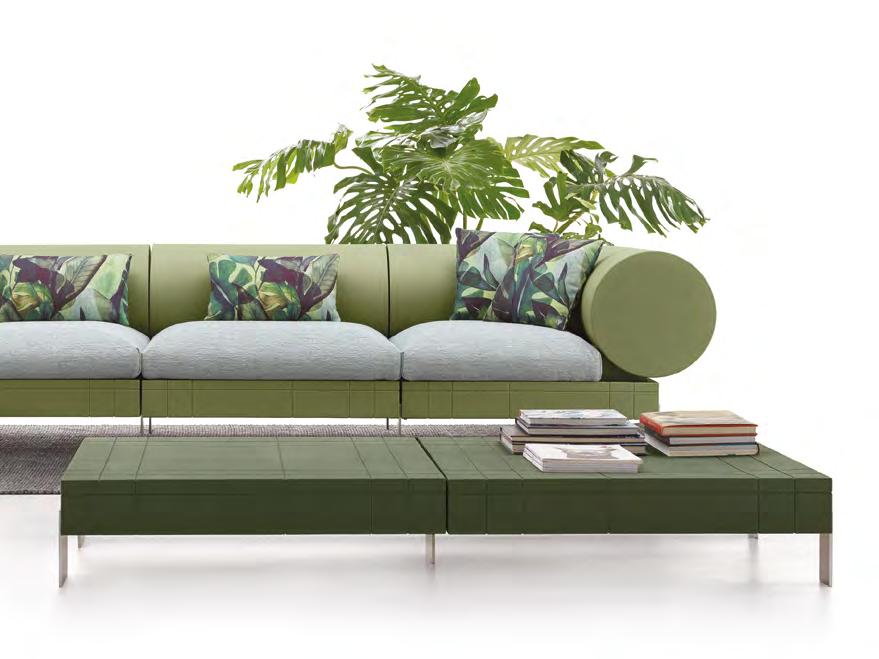
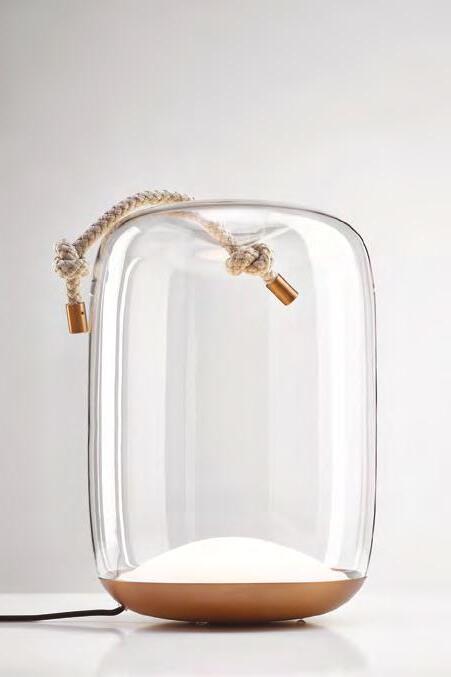
tors that we designers must always consider. Then, of course, there are constraints—costs, manufacturing feasibility, target markets—that shape the design process. A company might ask me to design a compact folding chair for a small balcony or a large, generous seat for a luxury hotel. If the chair is destined for the U.S. market, that would in uence the design even further. There are many variables at play, but creativity lies precisely in navigating these constraints.
In your opinion, what are the dominant styles (shapes, colors, etc.) in today’s outdoor sector, and how would you de ne your own style?
I’m not a trend expert, but based on my expe-
rience, I’d say earthy tones like burgundy red or brick red—colors inspired by nature—are very popular, both for product structures and fabrics. As for style, I see a focus on neutral, reassuring designs. That said, there are also iconic, more exuberant products meant to strongly and clearly express the brand’s identity.
Would you say that outdoor spaces allow for greater creative freedom compared to indoor spaces?
Not necessarily. As I’ve said, people now pay close attention to both indoor and outdoor design. Giving free rein to creativity outdoors, especially by non-professionals, could sometimes risk veering into kitsch—and that’s something everyone tries to avoid.
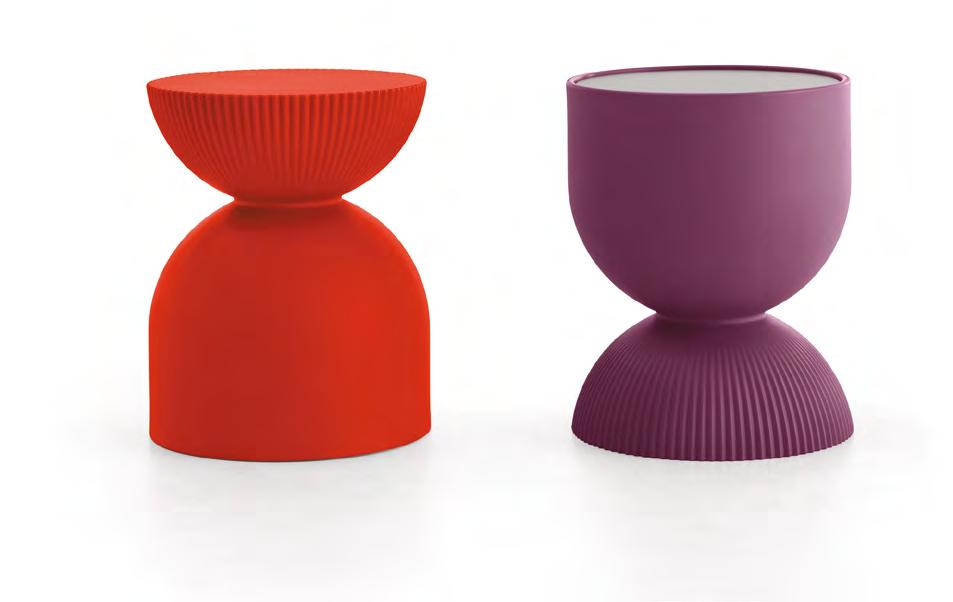
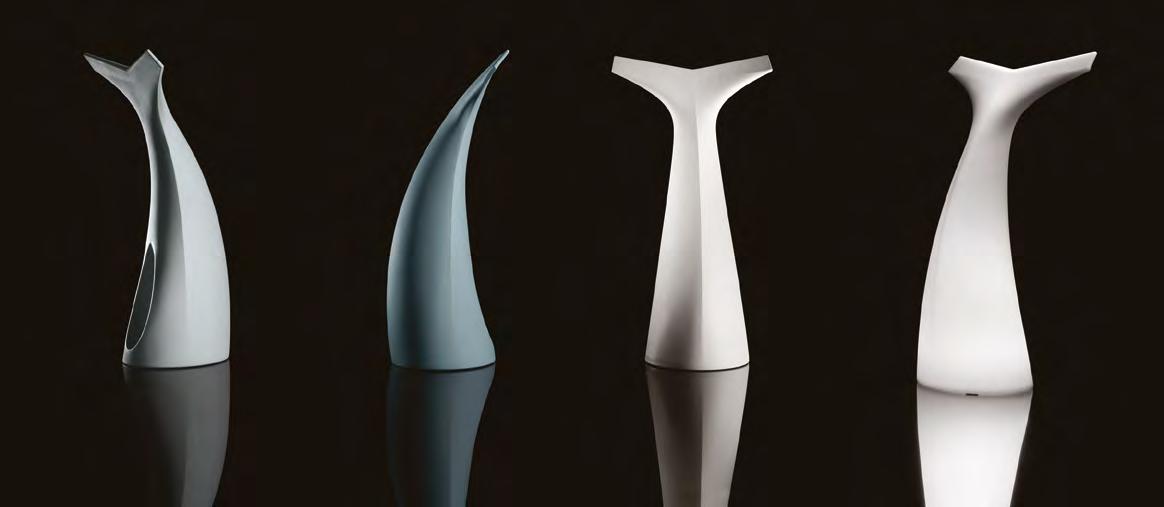
“Pina” Collection with multiple functions: umbrella stand, valet stand, sculptural lamp, or simply a decorative furnishing piece, produced by Lyxo, designed by LCM Marin Design Studio
“Dome Nomad” Portable Table Lamp, produced by Brokis, designed by LCM Marin Design Studio
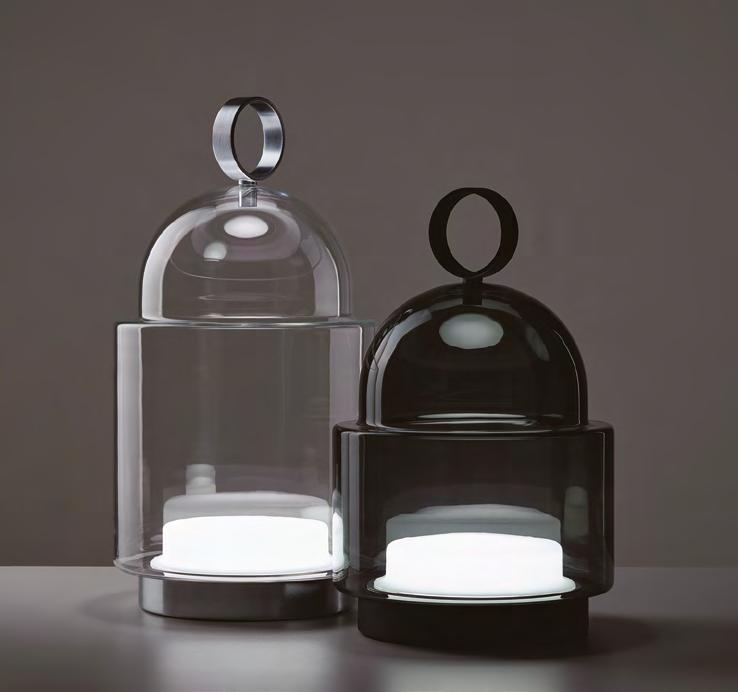
Co-founder of the Chiaramonte Marin studio in 1989, Marco Marin graduated in Visual Arts with a specialization in Industrial Design from Venice. In 2020, together with Carolina and Lorenzo Marin, he founded LCM Marin Design Studio, a multidisciplinary practice working across industrial, interior, and graphic design. The studio collaborates with prestigious national and international companies in the furniture and lighting industries, including Emu, Lyxo, Vistosi, Brokis, Hind Rabii, Barovier & Toso, Pallucco, Cattelan Italia, Bonaldo, Potocco, Jesse, Calligaris, Miniforms, and Nason Moretti.
His thirty-year partnership with Emu, a leading company in the outdoor furniture sector, has resulted in numerous products that have become milestones in the brand's history. In 2023, he took on the role of Art Director at Lyxo, a brand of the Veca Group.
He has received multiple awards in national and international competitions, including the Archiproducts Design Award, the German Design Award, and the Wallpaper* Design Award. His works have been exhibited in prestigious museums such as the Centre Pompidou in Paris, the MoMA in San Francisco, the Murano Glass Museum, and the Museo Correr in Venice.


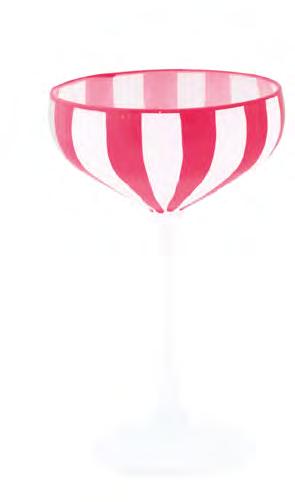
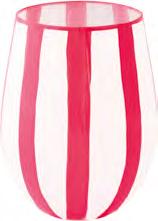
L’art de la table meets contemporary design with Twist & Match, a collection that rede nes table styling through a mix of vibrant colors, modern lines, and artisanal details.
Crafted with high-quality materials, the collection offers a wide range of products, from porcelain plates and borosilicate glassware to cups, decorative vases, catchall trays, and jewelry boxes.
Each item stands out for its pastel shades, playful patterns, and sophisticated details, creating visual harmony for those who love to personalize their table with creativity.
One of Twist & Match’s key strengths is its versatility: pieces can be mixed and matched to create a unique, customized setting, perfect for both special occasions and everyday use. Additionally, the collection’s decorative items are ideal for enhancing home spaces with re ned, contemporary accents. Available at leading retailers and online at:
https://easylife.boutique
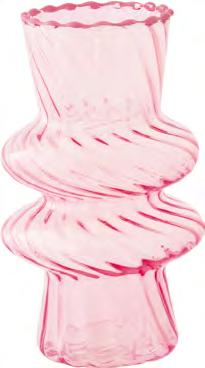
With Twist & Match, the table becomes a true sensory and stylistic experience, where every detail tells a story of elegance and innovation

From borosilicate champagne coupe sets, combining lightness and durability with elegant, fluid designs, to glass and porcelain vases that serve multiple purposes— perfect as centerpieces or as decorative accents for the living room. The collection is completed by decorative plates with colorful motifs, handpainted glasses, and porcelain jewelry boxes.
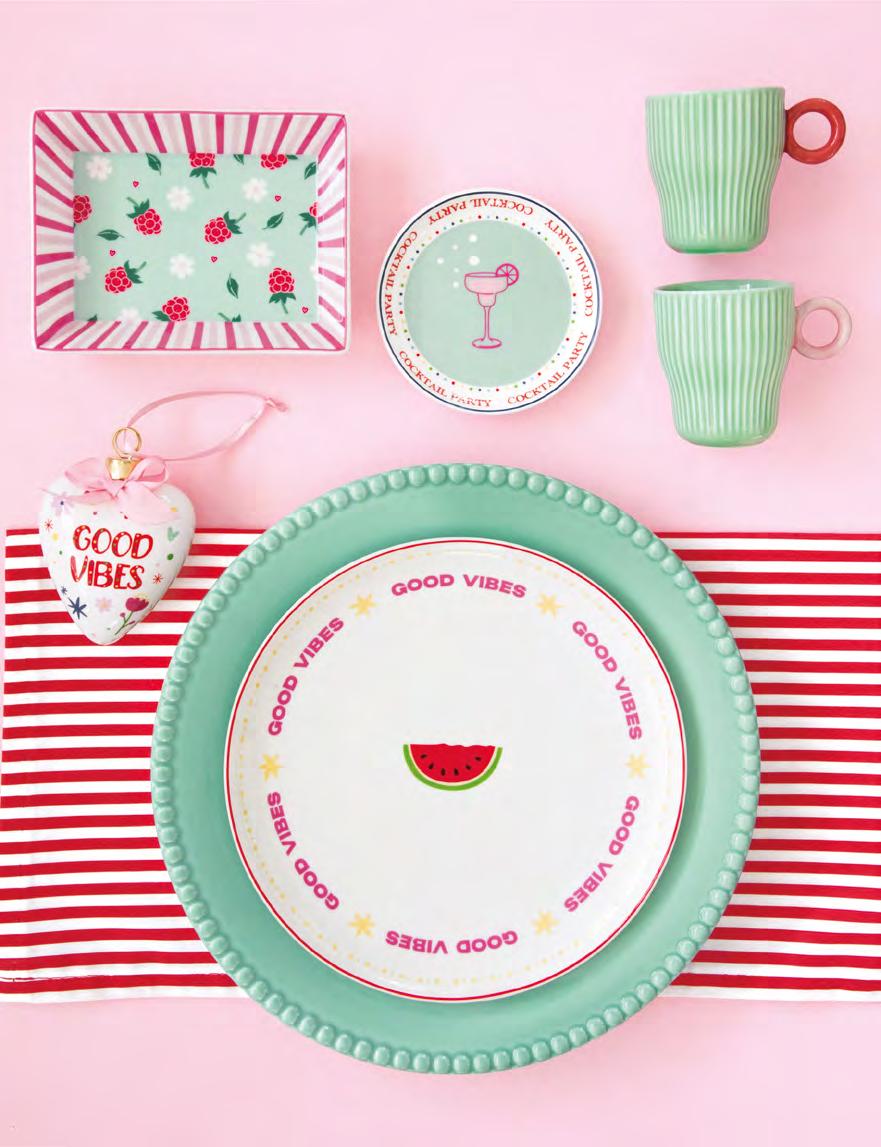

by Patrizia Pagani

In professional kitchens—and increasingly in home kitchens—there is growing attention to selecting the most suitable cookware based on the recipe at hand. The key factor when making this choice is the core material from which the cookware is made
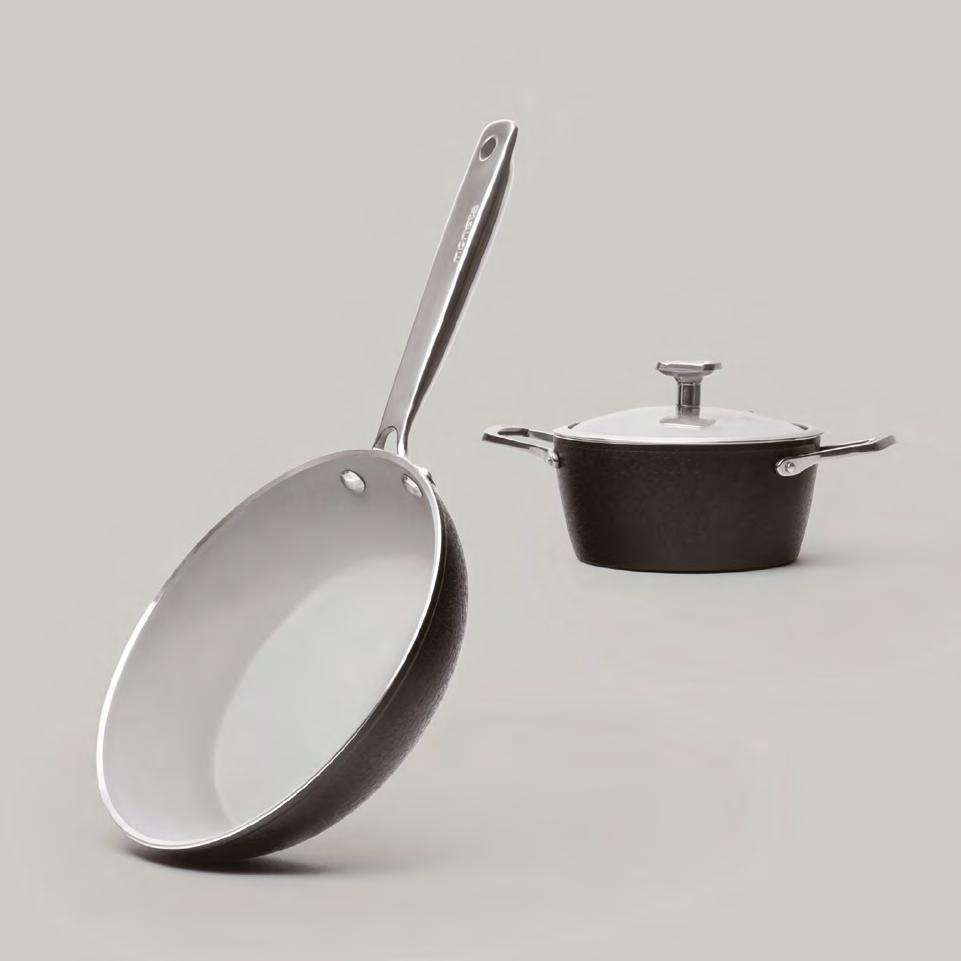
Choosing the right pot for each dish is essential to ensure optimal cooking results without compromising the nutritional properties, aroma, and avor of food. The decision-making process involves a wide range of variables, but the rst considerations should be shape, size, and above all, the material. Selecting the ideal material is critical, as each one has unique properties and affects cooking differently.
The key requirements for a quality cookware material include even heat distribution, health safety (meaning it should not release toxic substances or alter the taste and aroma of food), and long-term durability. Additional factors are compatibility with different cooktops (including induction), a reasonable price, and the now-essential element of sustainability.
The versatility of aluminum
Aluminum is one of the most widely used materials for cookware in Italy, thanks to its many proven bene ts. These include its lightness— making even large pots easy to handle—and its
excellent thermal conductivity, ensuring uniform heat distribution. Additionally, its exibility allows for cookware in a wide range of shapes and sizes.
On the downside, pure aluminum is not compatible with induction cooktops (although the industry has now developed solutions to overcome this) and is not non-stick or suitable for food storage, as it tends to degrade when in contact with acidic or salty foods. However, coated aluminum resolves these issues through non-stick or protective treatments, making it even more practical and versatile in the kitchen.
So how does a brand stand out in this competitive market?
“In this segment, differentiation isn’t based solely on manufacturing quality but on a combination of factors that make a product truly distinctive,” explains Cinzia Casagrande, Marketing & Sales Director at Allu on Spa.
“Research on coatings, studies on form, ergonomic handles, and innovative base designs all contribute to adding real value. As manufacturers, we control every step of the production
Frying Pan and Casserole from the Armonia FineGres Series by Moneta process, allowing us to optimize every detail.” Today, Moneta’s agship lines are characterized by Finegres, an exclusive 100% natural, PFASfree ceramic coating that allows for radiant heat cooking, ensuring more even and ef cient results.
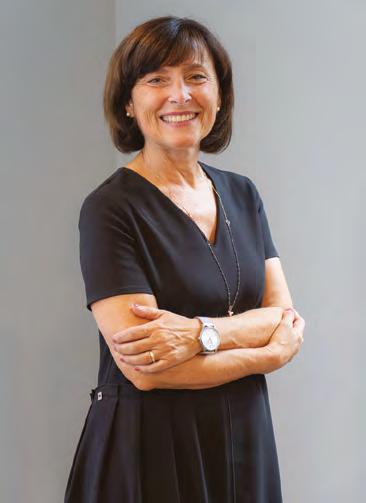
With its unique properties and modern production and safety standards, die-cast aluminum is a top choice for cookware.
“Its key features,” says Cristina Montini, Owner and Commercial Director of Risolì Srl, “include recyclability, durability, and a thick base that ensures excellent and consistent heat distribution, which results in signi cant energy savings and even cooking across the surface.”
The material’s downside is its relatively heavier weight, but this is also seen as a bene t, as it signals quality and stability.
Proper care is essential: to ensure the safety and longevity of die-cast aluminum cookware, abrasive cleaners and metal utensils should be avoided.
“This type of cookware is aimed at passionate home cooks who value high-quality, Italianmade products that are more expensive than competitors but also more reliable and long-lasting. Sustainability is another key value, as these are ethically-made products that respect both people and the environment.”
To differentiate itself in the market, Risolì in-
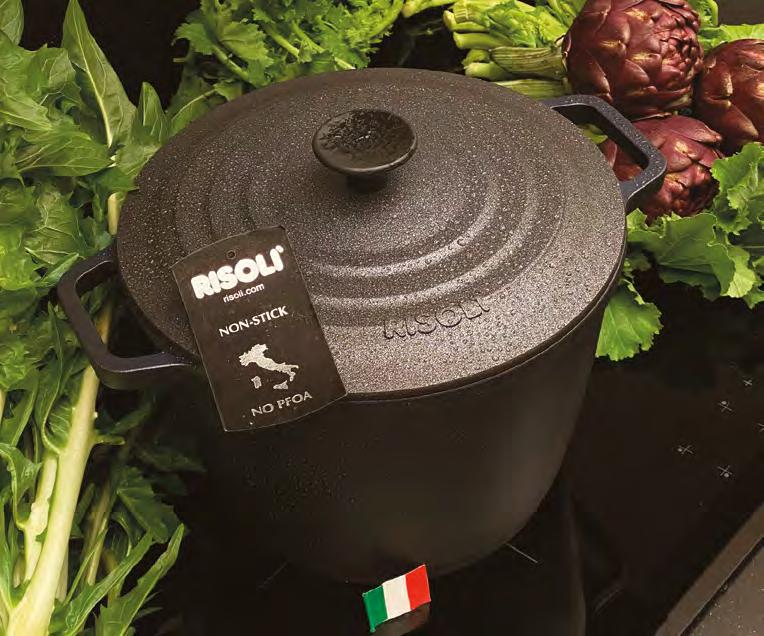
vests heavily in communication, focusing on training its salesforce to convey the added value of its products and to advise customers against generic or imported alternatives—even those carrying Italian brand names.
“We are currently focusing on our Black Plus line, which combines long-lasting performance with distinctive, elegant shapes.”
Cristina Montini, Owner and Commercial Director of Risolì Srl
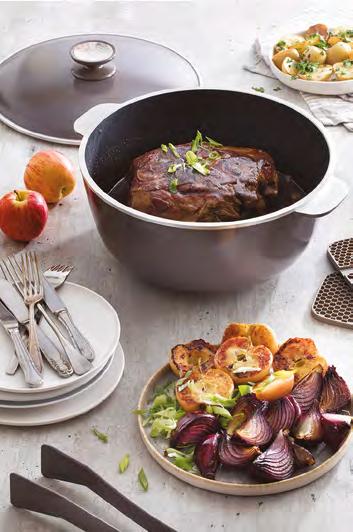
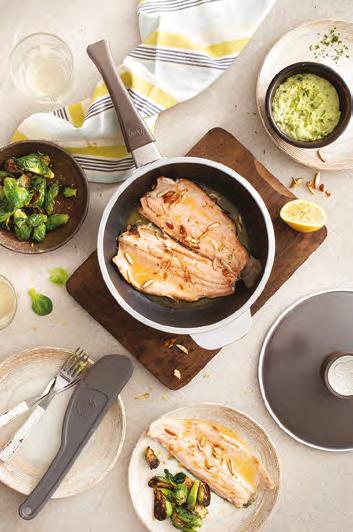
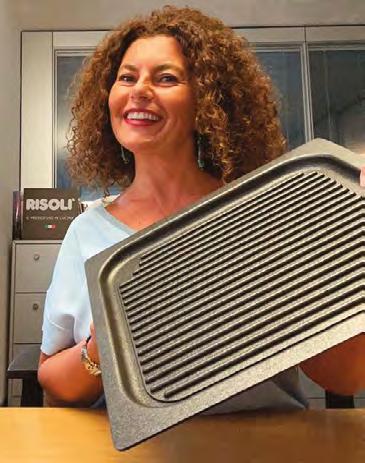
The coating makes the difference
Aluminum cookware with non-stick coating retains all the typical advantages of plain aluminum—such as lightness and excellent thermal conductivity—while adding the benefit of preventing food from sticking during cooking. This allows for reduced use of fats and makes cleaning the cookware easier and more convenient. However, not all non-stick coatings are created equal.
“Our non-stick products stand out for the exceptional uniformity and durability of their coating, which is designed to withstand daily wear and scratches, exceeding industry standards,” says Chiara Brunelli, CEO of Deko Srl.
“We also ensure easy and fast cleaning, combined with high food safety standards, making our coatings ideal for applications where quality and reliability are key.”
The company differentiates itself through the use of cutting-edge technologies for coating application, supported by ongoing technical assistance that delivers not only a superior product but also strong service value.
“We are proud to be recognized as market leaders, thanks to our continuous innovation and the outstanding quality of our products, designed to meet the needs of even the most demanding customers. Today, our flagship line includes rolled and sprayed PTFE-based coatings, renowned for their exceptional non-stick performance and reliability in industrial processes.”

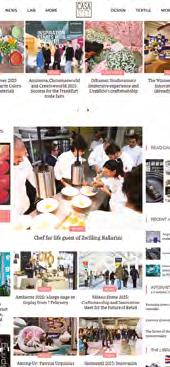

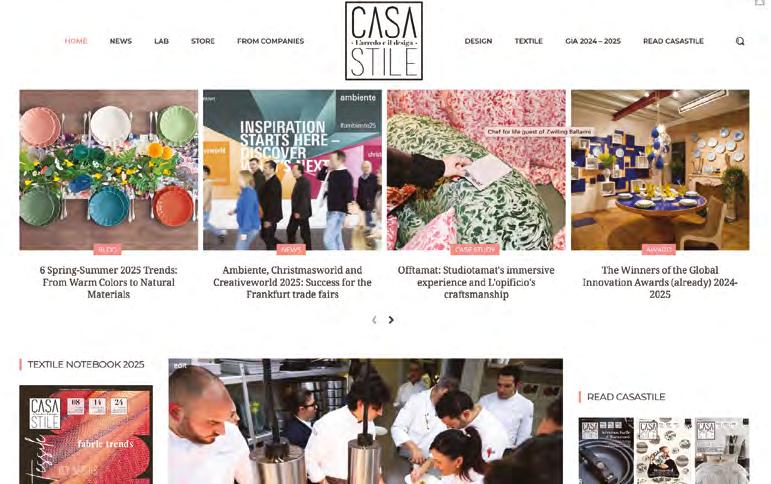
Stainless Steel: Healthy, Durable, and Eco-Friendly
Stainless steel cookware excels in boiling and offers undeniable advantages in terms of hygiene, easy maintenance, and long lifespan, though it is less maneuverable due to its weight and has lower thermal conductivity unless enhanced with a specially engineered base.
“Our products stand out in this category because we use the highest-grade stainless steel—18/10 (18% chromium, 10% nickel)—sourced from Italy or, in some cases, other European countries,” explains Andrea Barazzoni, President and CEO of Barazzoni Spa.
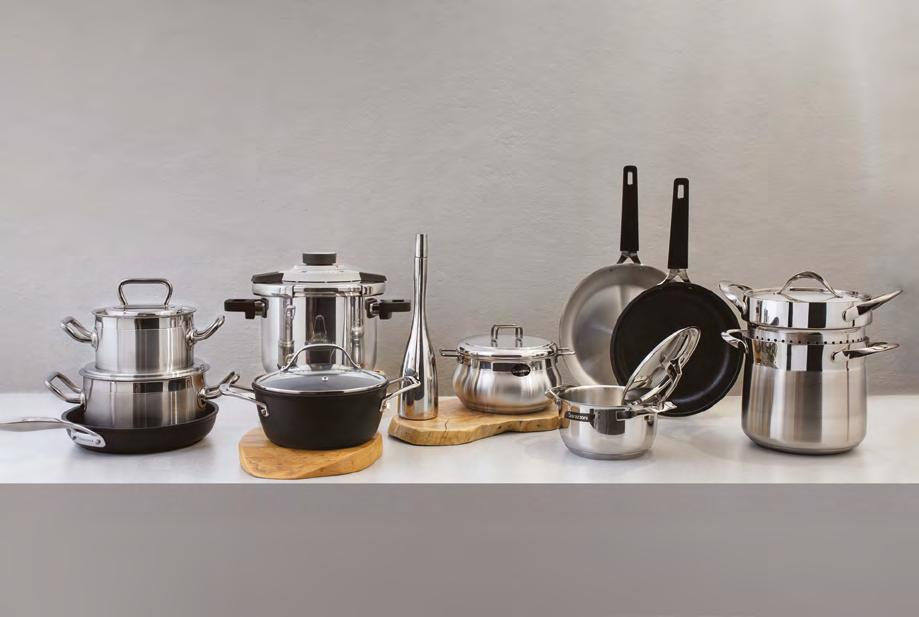
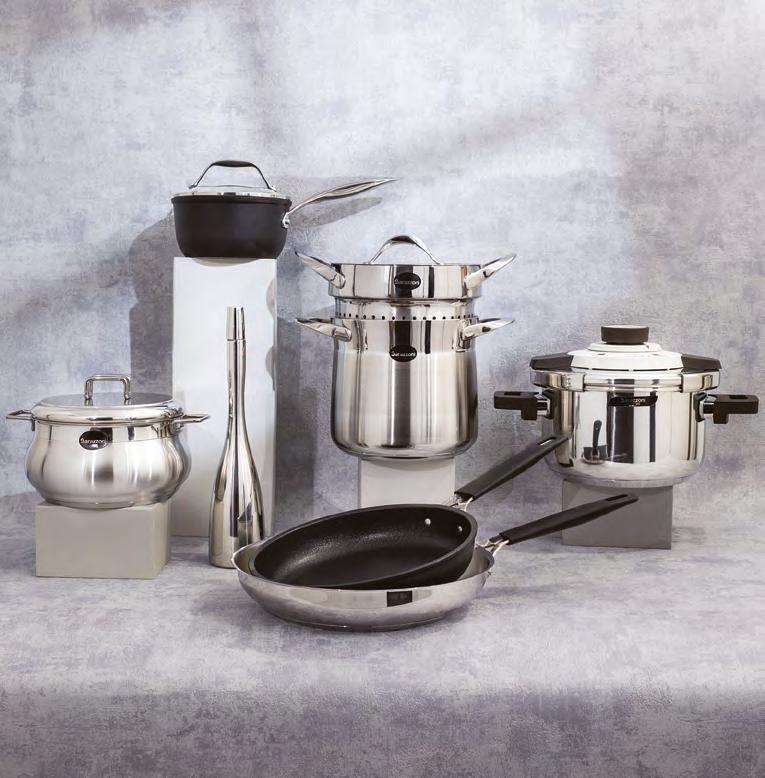
“This material ensures superior heat conduction (for energy savings), high resistance to rust and corrosion, and excellent food preservation and cleaning properties. Combined with our strict production controls—all carried out entirely in Italy—our pots are durable, hygienic, and safe for health.”
Additional bene ts include sustainability, thanks to the long life cycle of the product and the recyclability of stainless steel, as well as compatibility with all cooktops, including induction.
“This is achieved through our triple-layer base (steel-aluminum-steel), which ensures even heat distribution and suitability for all heat sources.”
Stainless steel cookware appeals to both novice and experienced cooks.
“Our customers include long-time users who may have received our pots as wedding gifts and remain loyal, as well as new customers of all ages who choose stainless steel for its health bene ts, durability, and versatility.”
Barazzoni’s stainless steel range includes several collections, led by the iconic Tummy line, launched in 1969 and still a bestseller.
Strength and Durability in Stoneware and Cast Iron
Vitri ed stoneware is a high-quality ceramic material with a non-porous surface, making cookware durable, easy to clean, and dishwasher safe.
“Our vitri cation process makes each piece even more resistant, long-lasting, and versatile,” says Alessandra Maggi, Commercial Director of Le Creuset Italia.
“Contemporary colors and lightness combine in a wide range of collectible products designed to meet the highest demands for oven and microwave use. Ideal for everyday cooking, our vitried stoneware is made with one of the most durable clays and is red at high temperatures, making it resistant to scratches, chips, cracks, and stains. It also ensures excellent heat retention, so food stays warm longer on the table.”
In addition to gift sets and “art de la table” items, Le Creuset’s collection includes bakeware such as casseroles, ramekins, and cake molds.
The brand also offers vitri ed cast iron cookwa-
re, an equally versatile material that ensures even heat distribution during both short and long, low-temperature cooking.
“Our cookware features a high-quality vitri ed surface that resists daily wear and tear, does not absorb or transfer moisture, odors, or avors, and withstands all types of acidity. It is compatible with all heat sources and dishwasher safe.”
Each cast iron piece is still produced at Le Creuset’s factory in Fresnoy-le-Grand, where some steps are still performed by hand, making every item unique.
Technically, molten cast iron is poured into sand molds (called “creusets” in French), which are broken after use, followed by a triple vitri cation process at high temperatures. The rst layer ensures durability and resistance to thermal shock, while the others provide Le Creuset’s signature vibrant nishes.
“Our most iconic products are our round and oval cocottes—indispensable tools for risottos, roasts, soups, sh dishes, and oven cooking.”
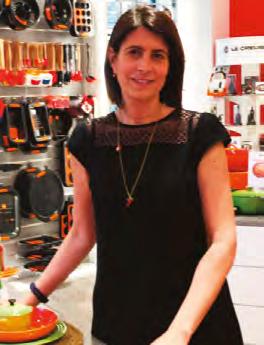
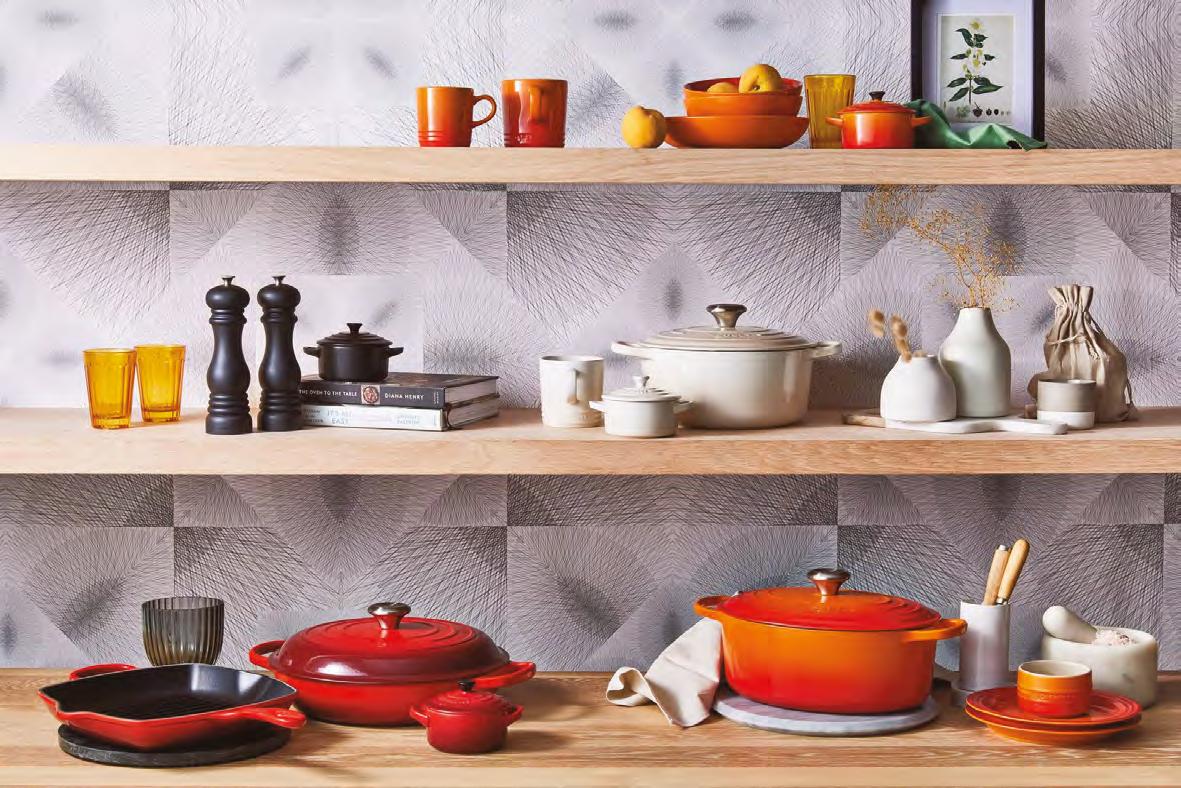
Second only to silver in thermal conductivity, copper distributes heat evenly and quickly, allowing for precise temperature control. This is why it is widely used in pastry making, where precision is key.
“This feature makes copper ideal for various types of cooking, both short and long, although it is particularly suited to risottos and meats,” says Angelo Pavoni, Co-owner of Pavoni Snc, a fourth-generation, family-run business.
“As I often say, a copper pot teaches you how to cook. Food will stick if temperatures or techniques are incorrect, but when used properly, ingredients are cooked to perfection and develop unique avors.”
Most copper cookware is lined with tin to protect against acidic foods. “Over time, tin can wear off and requires re-tinning. However, this is not necessarily a drawback: since copper pots can be re-tinned multiple times, they can last a lifetime, making them highly sustainable.”
Copper cookware’s main drawbacks are its high price and considerable weight, which can be challenging for everyday use.
“Our products are popular among food enthusiasts and high-end restaurants and hotels—not just for cooking but also for table service, as copper adds a unique touch of elegance. While all our products meet professional standards, one of our standout pieces is the domed casserole.”
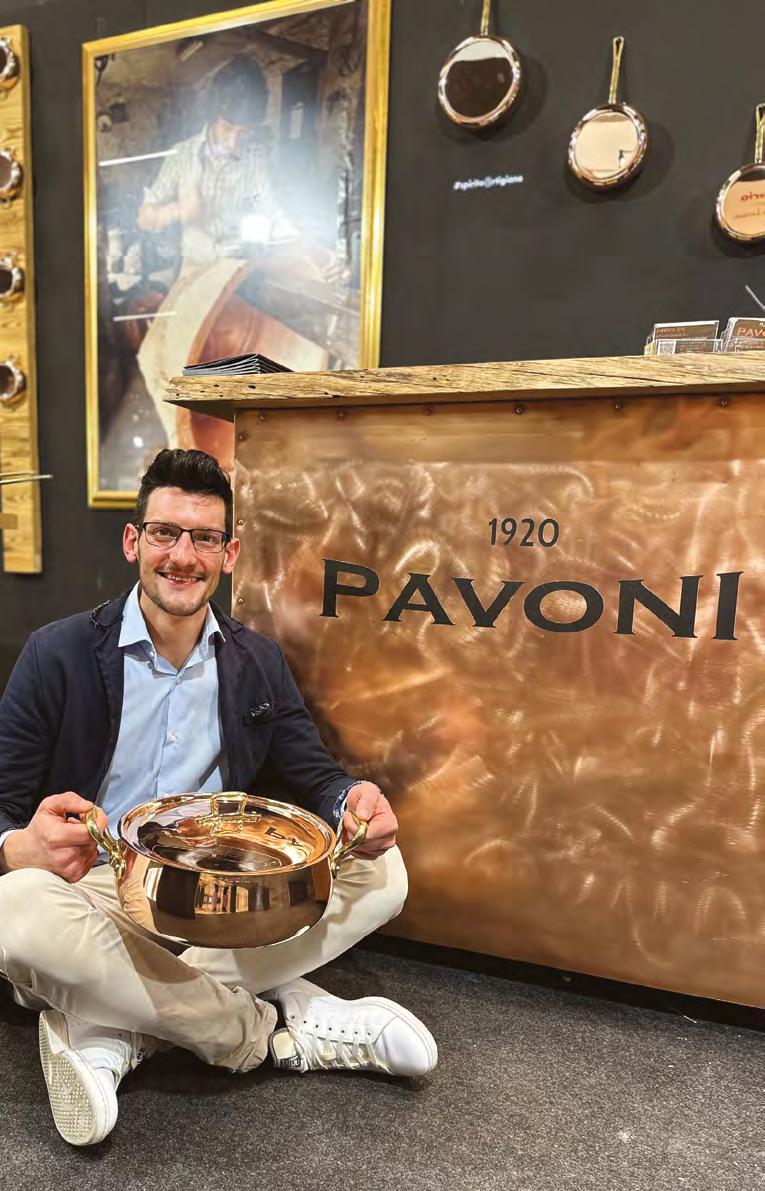
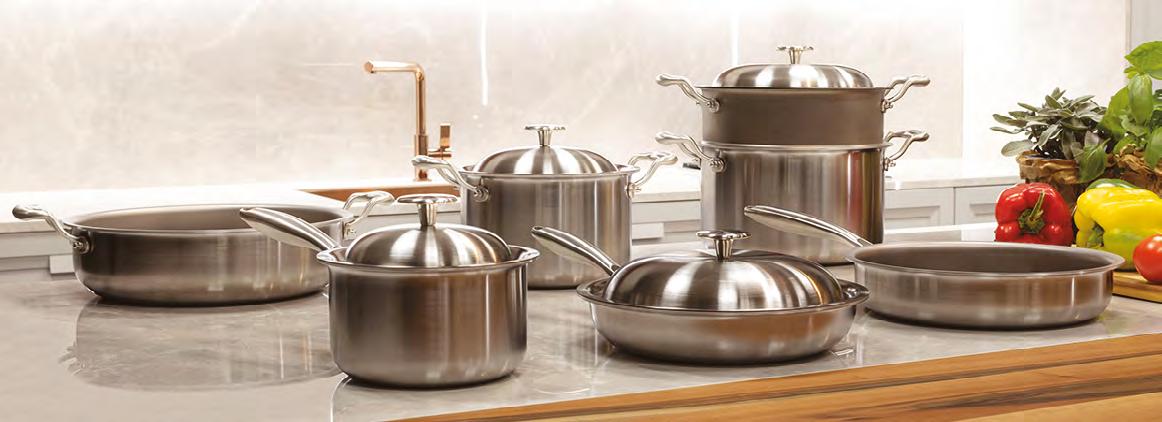
Titanium appeals to health-conscious consumers
Titanium cookware is favored for its resistance to corrosion (from acidic and alkaline foods and salty water) and high temperatures, as well as for being biocompatible and non-toxic.
“The pure titanium cooking surface of our pots eliminates the risk of harmful substance contamination and the release of potentially toxic fumes,” says Emma Maria Villa, Communications Manager at Tritania
Green Dragons and cast iron griddles too
Officina Ghise Lamperti Srl— a manufacturing company founded in Legnano back in 1908 and known worldwide for the so-called "green dragons," the iconic public fountains of the City of Milan featuring dragon-shaped taps—also operates in the cookware sector with a range of cast iron pots and pans.
“Enamelled cast iron,” explains Andrea Lamperti, the company’s Owner, “is one of the best materials for cookware, as it performs exceptionally well on any heat source. It stores heat, retains it for a long time, and distributes it slowly and evenly, preserving the nutritional qualities of food and enhancing its flavors and aromas. It even allows for residual cooking with the heat off, saving energy.
Of course, not all cast iron is created equal: our products are TÜV-certified and undergo constant quality controls, which is
“This also bene ts avor, as titanium preserves the natural taste of food.”
Titanium, being free of nickel and PFAS, is a valid alternative to stainless steel and non-stick aluminum. Its higher price point, however, is a limiting factor.
Who typically buys titanium cookware?
“Our early adopters were doctors and nutritionists interested in healthy cooking, along with material science enthusiasts. Over time, we’ve
expanded to include all health-conscious consumers who love good food.”
Tritania’s range includes seven triple-layer pieces, with pure titanium on the cooking surface, an aluminum core, and an external layer of AISI 430 magnetic stainless steel for induction compatibility.
Since these products are entirely metal and coating-free, they are virtually indestructible and require no reconditioning over time.
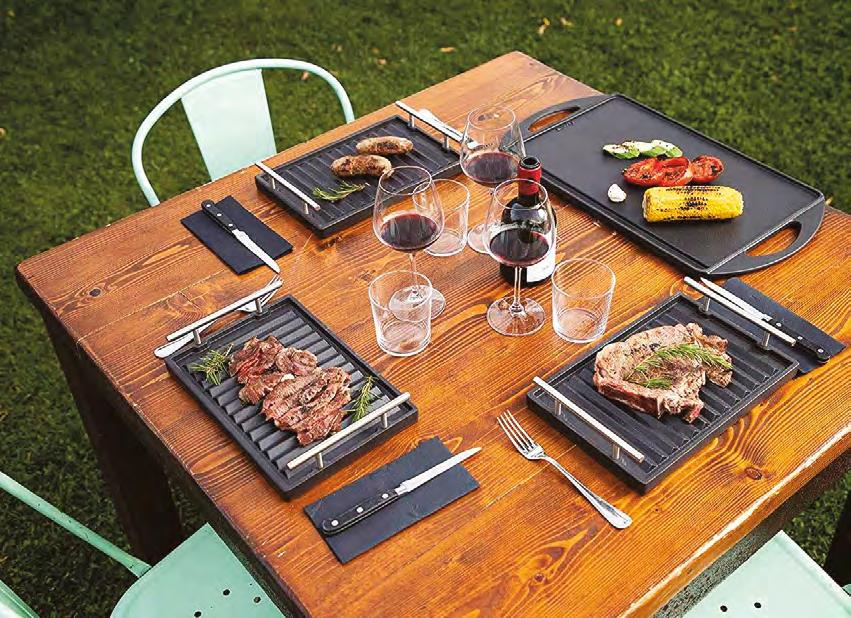
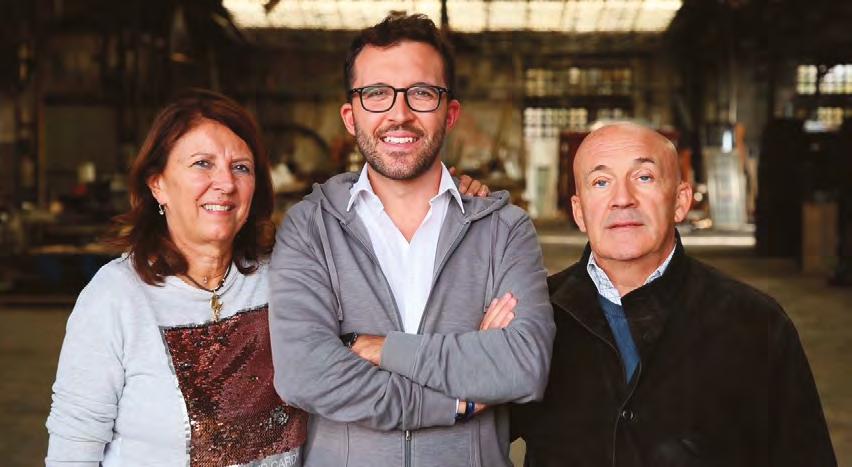
why they are positioned at a much higher price point compared to supermarket products.
With this in mind, we are now focusing less on classic cookware and more on griddles, grills, and skillets, available in various shapes and sizes.”
ZWILLING
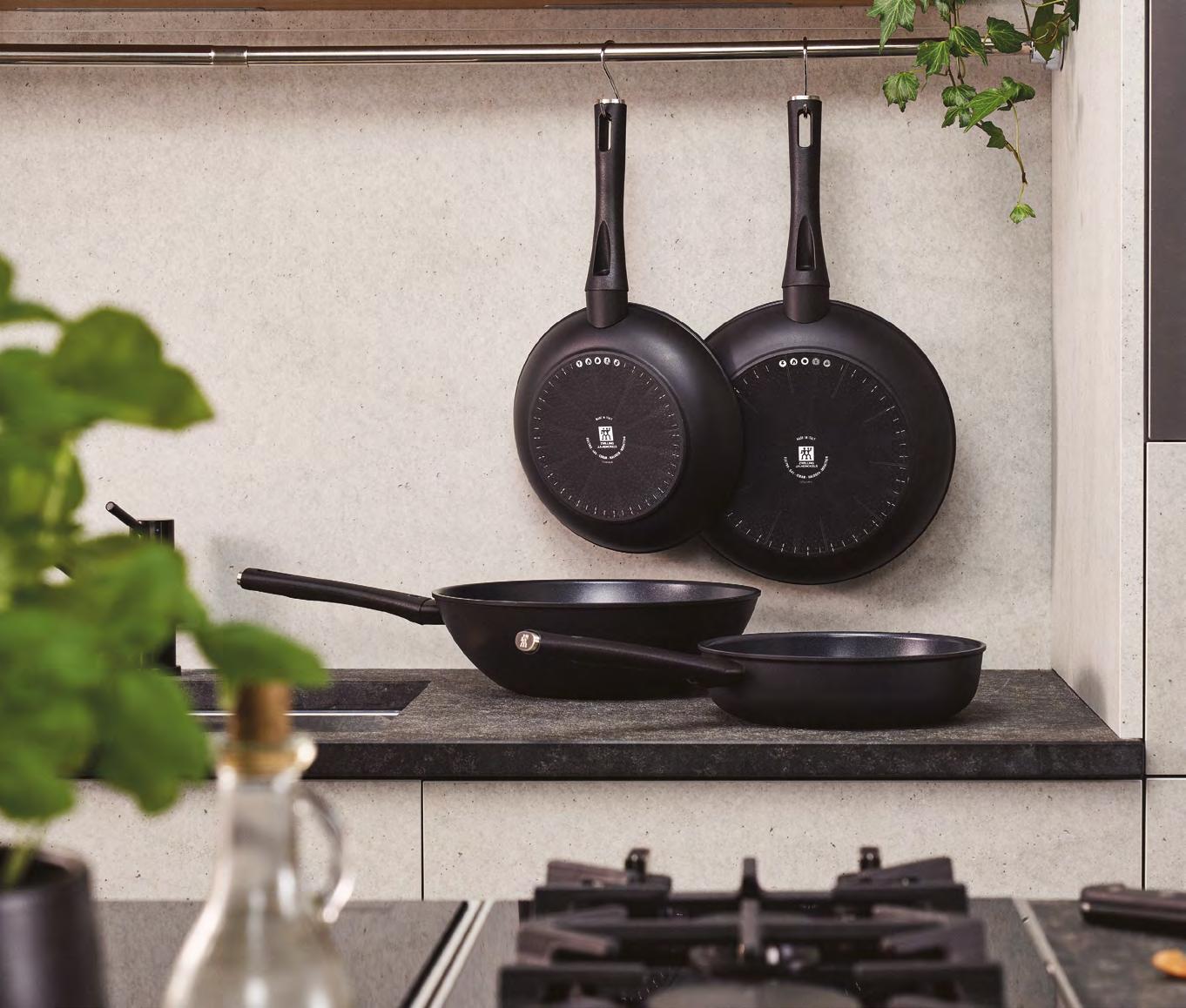
Produced in Italy, the Madura Plus line marks a signi cant evolution in Zwilling’s non-stick range. Its new Ceraforce® Titanium coating is the result of advanced research and is characterized by a titanium hardening treatment that ensures high scratch resistance and longlasting performance. The PFASfree coating contributes to a more eco-friendly kitchen.
Another distinctive feature of Madura Plus is its patented Flat Induction base, which is seamlessly integrated into the pan’s structure. It optimizes heat distribution, delivering more even and ef cient cooking—even on induction stovetops.
Zwilling and Ballarini’s focus on technological innovation and sustainability is redefining standards in the cookware sector. From the durability and safety of Madura Plus' Ceraforce® Titanium, to the elegance and versatility of the Joy Plus line, and the green revolution of the Ledro range, the Zwilling Group continues to innovate to meet the needs of chefs and cooking enthusiasts

In the premium cookware sector, the Zwilling Group has always stood out with collections that embody the evolution of kitchen technology: a constant focus on non-stick coatings and induction technologies that has established the group as a benchmark for professionals and passionate home cooks alike.
One of the hallmarks of these products is the use of advanced coatings. Madura Plus features Ceraforce® Titanium, which ensures exceptional scratch resistance and durability while being PFAS-free, contributing to more sustainable cooking. Joy Plus, on the other hand, integrates an ultra-resistant, triple-layer coating with a microetched metal texture that provides excellent nonstick performance with little or no oil.
Madura Plus' Flat Induction technology and Ledro's Radiant base ensure excellent heat distribution, optimizing energy consumption and guaranteeing awless cooking results on all types of stovetops, including induction. Joy Plus also delivers high performance thanks to its induction-optimized base, minimizing energy waste.
In addition to high performance, user comfort is a key feature. Madura Plus offers a heat-resistant handle with a metal end cap for a secure and long-lasting grip. Joy Plus stands out for its sleek and functional design, while Ledro introduces an eco-system handle, oven safe up to 150 °C and made with at least 37% bio-based material, reecting a strong commitment to sustainability.
Ballarini Ledro takes sustainability to the next level with the use of 100% recycled aluminum and completely plastic-free packaging. This commitment is complemented by the use of Ceraforce® coating, produced without PFAS and tested for nickel and heavy metals, for a reduced environmental impact. www.zwilling.com
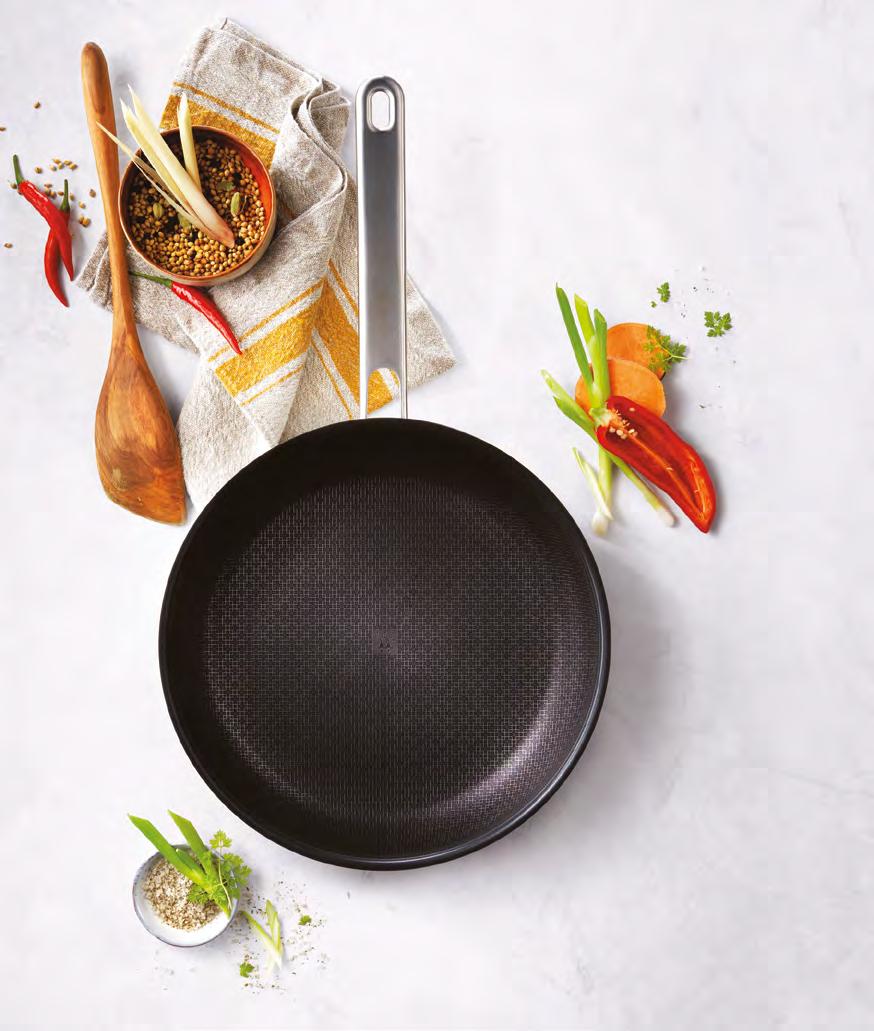
Zwilling Joy Plus: versatility and performance for every need
The expanded Joy Plus range introduces a new, highperformance frying pan with a refined design. The range includes three frying pans (20, 24, and 30 cm) and a 30 cm wok, all suitable for any type of cooking and oven safe up to 200 °C.
Ballarini Ledro: the sustainable cookware revolution
Launched in 2024 by Ballarini, the Ledro line combines outstanding performance with a focus on sustainability. The key feature of this collection is the use of 100% recycled aluminum, significantly reducing the environmental impact of production.
The handle incorporates the Thermopoint heat indicator, which signals when the pan has reached the ideal cooking temperature, ensuring perfect results while minimizing energy waste. The range includes frying pans (20, 24, and 28 cm), a 28 cm wok, a square grill pan (28 cm), and a two-handled casserole.


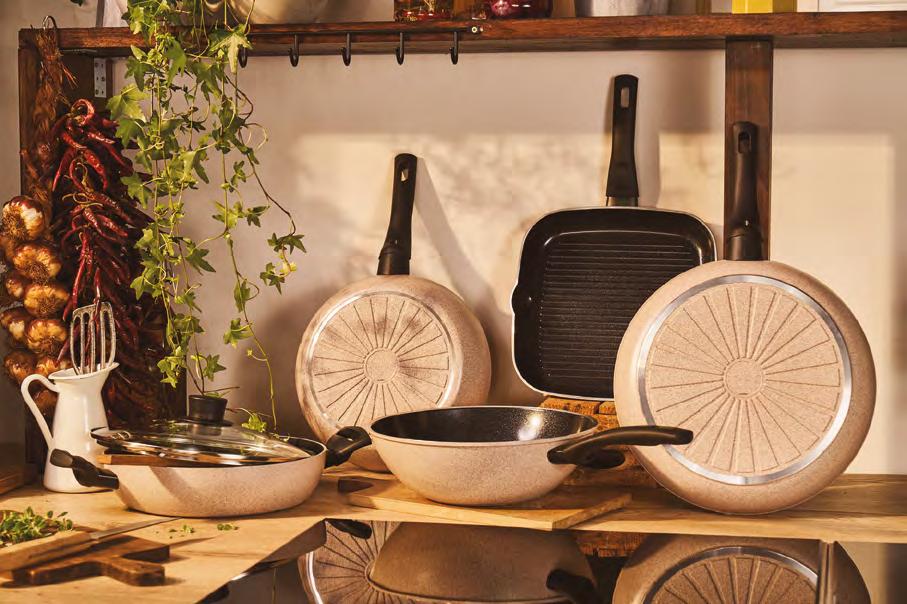
by Francesca Guerini Rocco
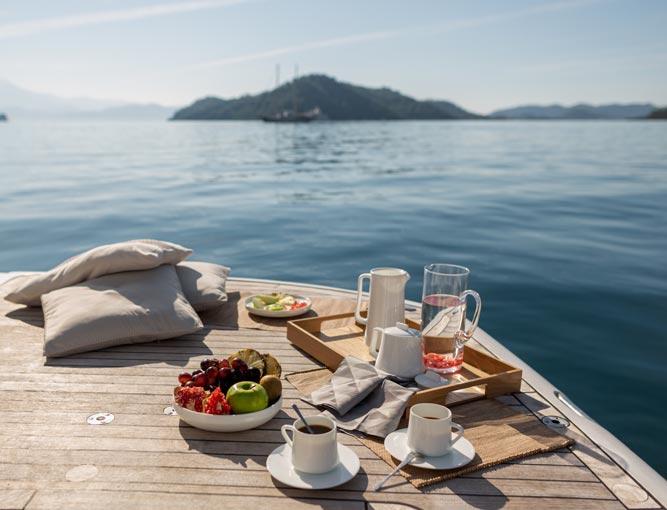
Ideal for organizing a romantic “déjeuner sur l’herbe,” the classic Torino picnic basket by Cilio, crafted in grey woven willow, contains everything needed for two: two plates, two glasses, and two sets of cutlery. Featuring faux-leather straps and a fabric-lined interior. Dimensions: 37x27x19 cm. Distributed by Schoenhuber.
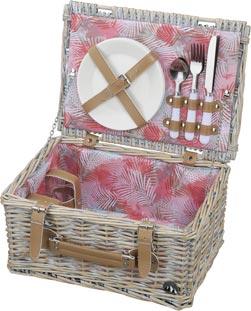
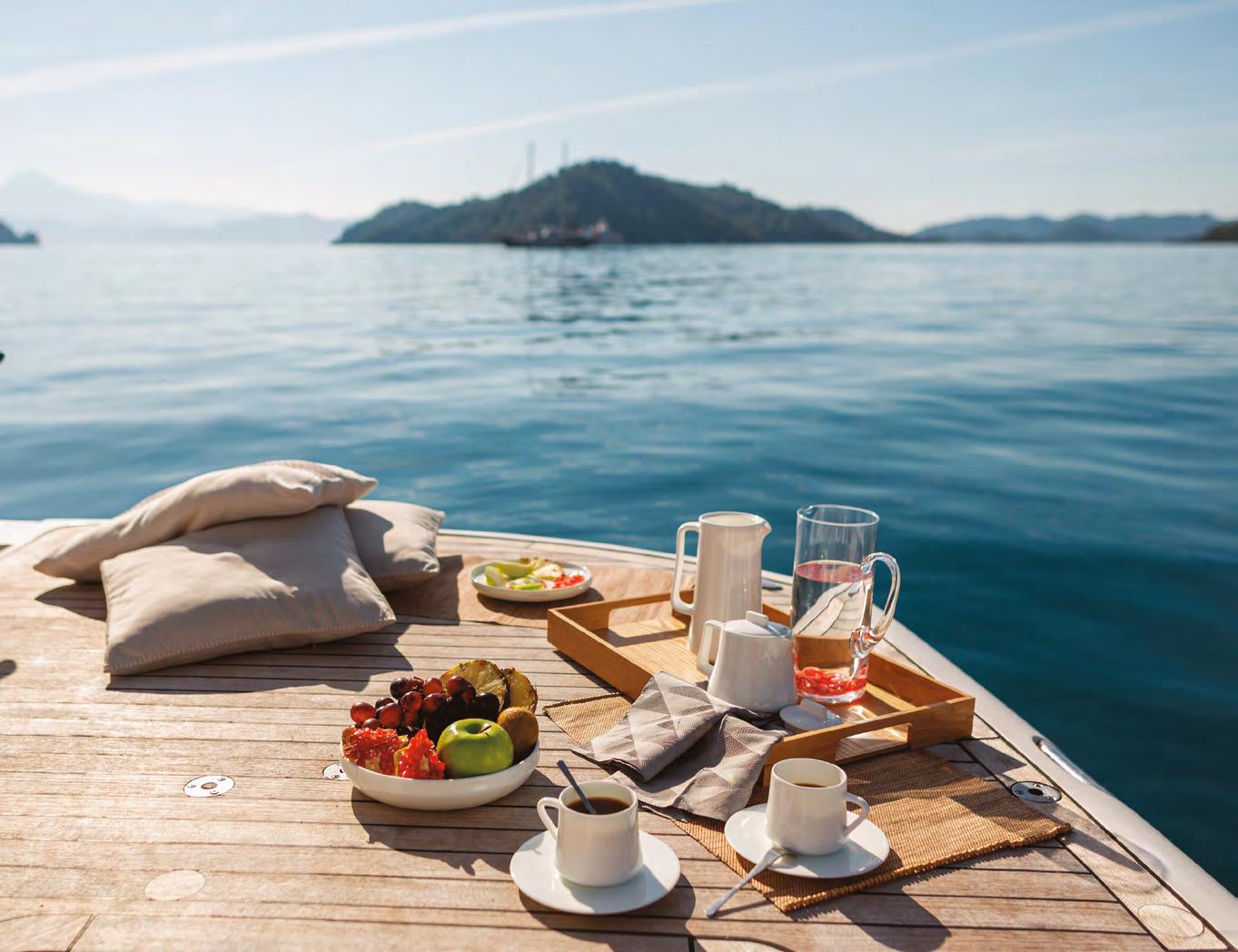
On a city balcony, surrounded by flowers in the open countryside, or on a boat out at sea: in summer, every occasion is perfect for dining al fresco, as long as the right atmosphere is created. The latest seasonal novelties offer a cheerful, chic, and naturally practical mise en place, complemented by specially designed accessories for serving brunches and aperitifs in style. Planning a barbecue menu? Here’s a selection of the most convenient grills and indispensable utensils for flawless cooking and elegant serving.
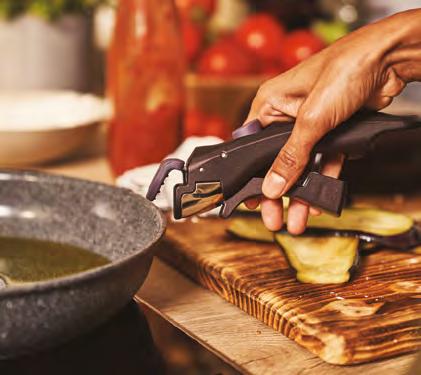
Compact, versatile, efficient. Ballarini’s Torre collection is a stackable cookware line, ideal for limited spaces and perfect for boat cooking. The removable handle allows easy stacking to optimize storage space without compromising quality. Its patented induction base ensures high performance, while the CERAFORCE® coating, non-stick and PFASfree, guarantees durability and effortless cleaning. Intelligent design and maximum functionality to cook anywhere—from boat galley to home kitchen.
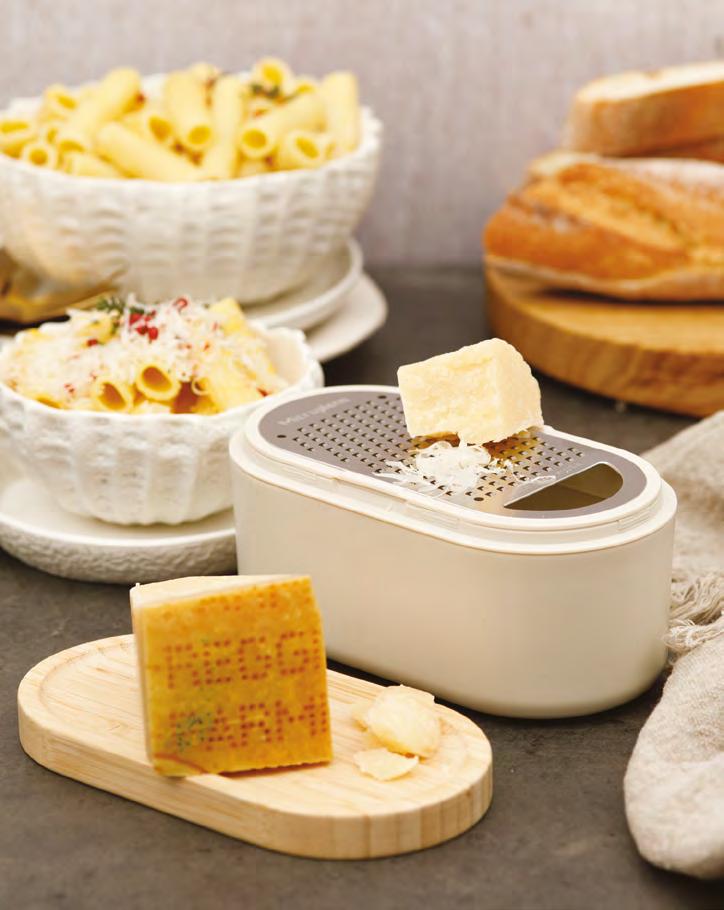
Two-in-one: Microplane®’s new grater with storage container perfectly grates every ingredient (including chocolate and nuts), preserving aromas and organoleptic properties thanks to its extremely sharp, USA-made stainless-steel photo-etched blade. The wooden lid protects the blade after use and doubles as a base, while the opening allows contents to be poured directly onto dishes or used as a cheese server (with a non-slip ring on the base). Additionally, a second airtight lid ensures grated cheese stays fresh for longer.
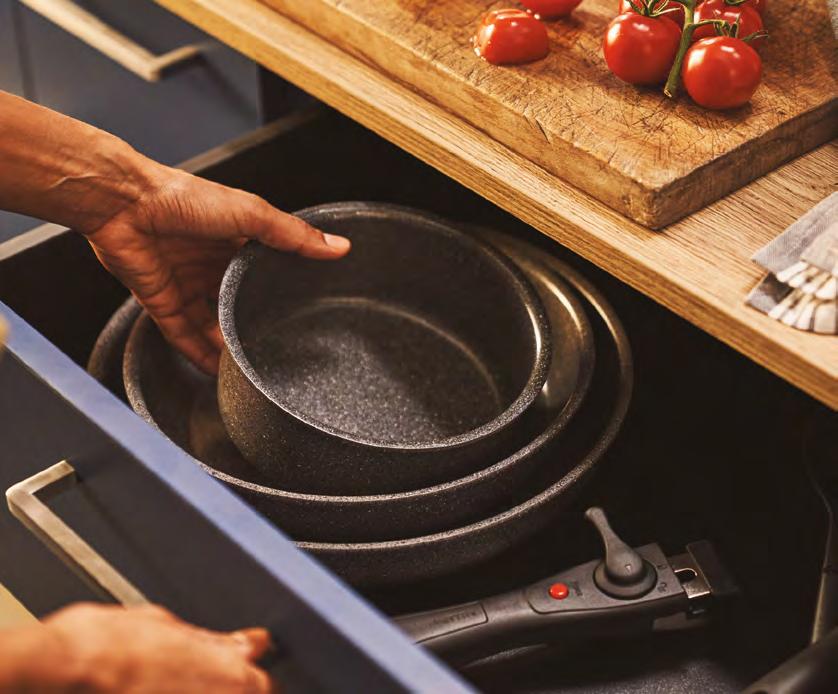
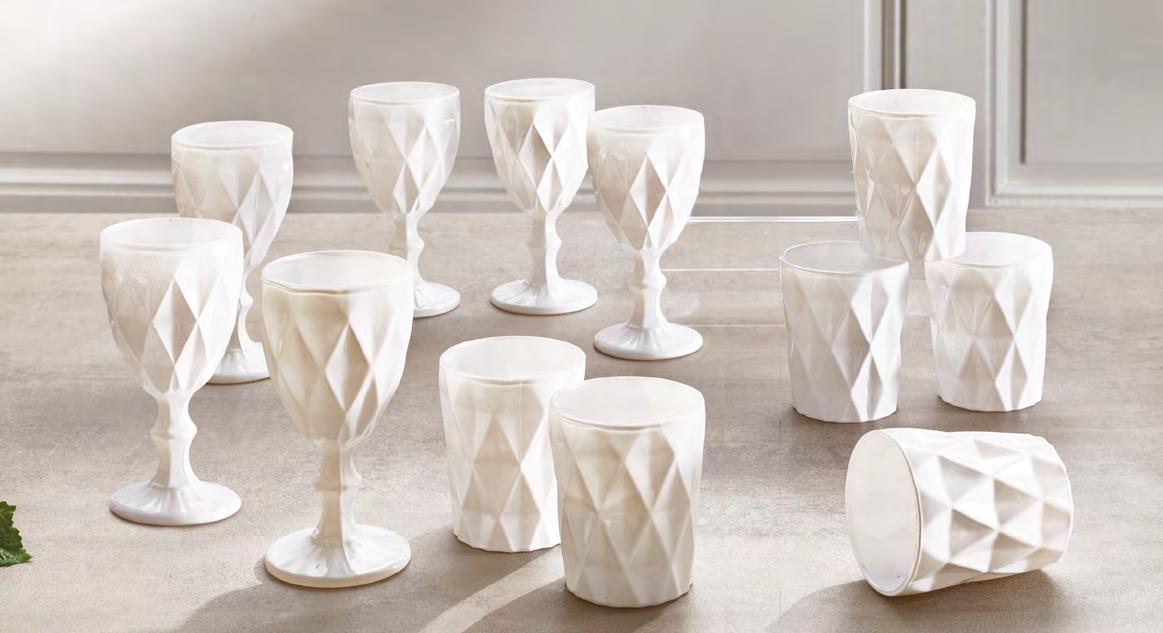
Brandani introduces the Diamante glassware collection, reinterpreted in an elegant white glass version. Goblets and tumblers, featuring a faceted "total white" surface, create a luminous and sophisticated effect on the summer table. Also available is a set of six goblets in assorted colors.

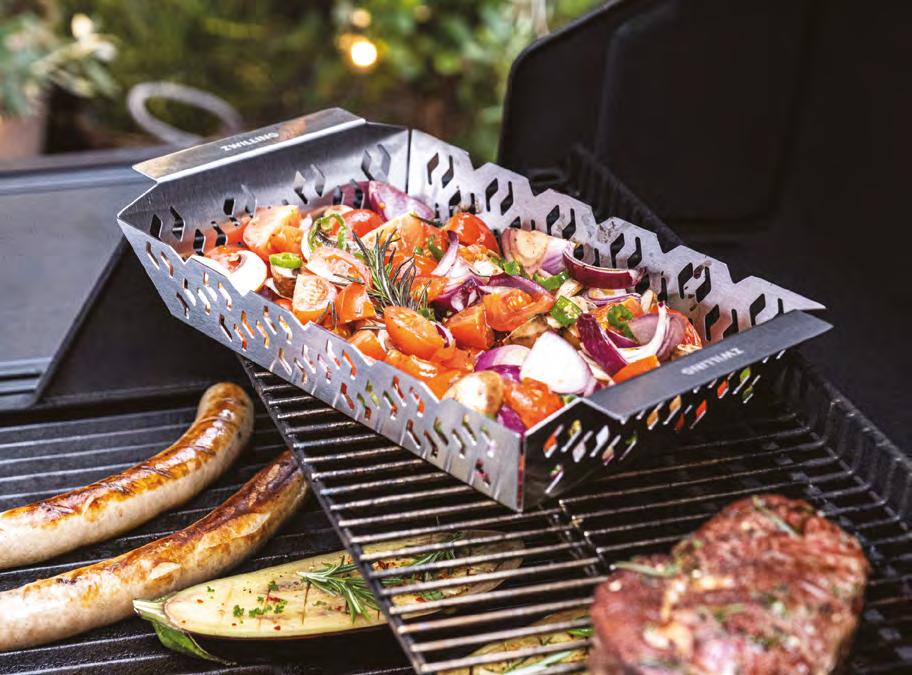
BBQ+ by Zwilling is the utensil line designed specifically for grilling meat, fish, and vegetables. Crafted from stainless steel, the spatula, tongs, fork, and brush come with extra-long handles for safe grilling from a comfortable distance, while the digital thermometer accurately measures the internal temperature of meat. The kit also includes robust nylon claws for gripping, cutting, and shredding any type of meat, grilling pans with special perforations, gloves in cotton or silicone, an FSC-certified bamboo cutting board with integrated drawer, skewer sets, and serving baskets.
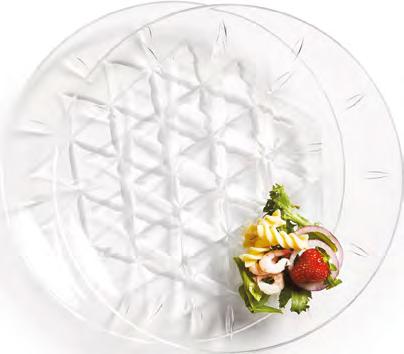

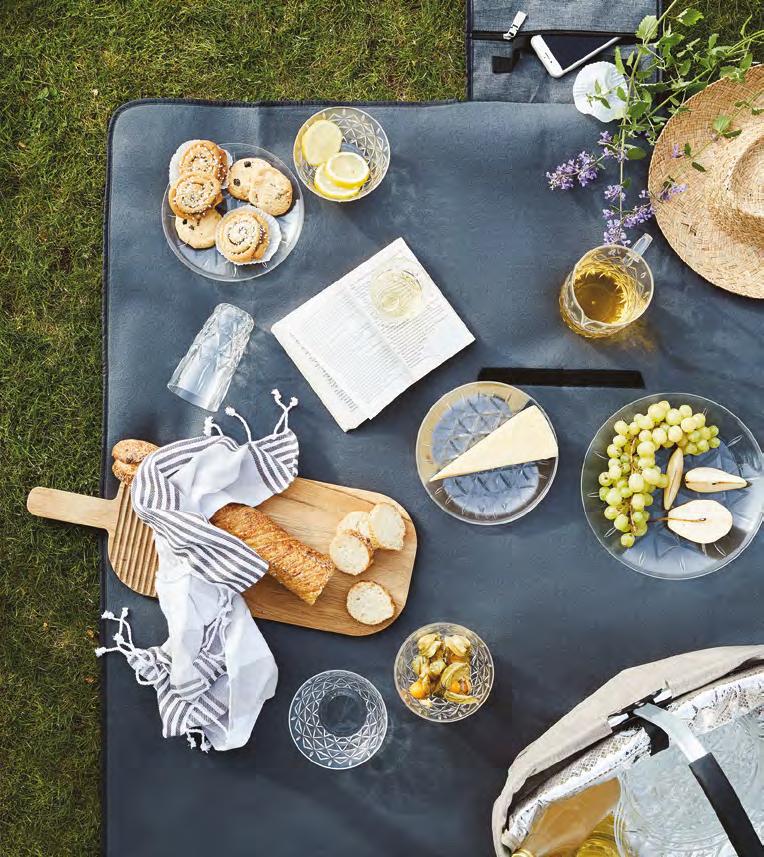
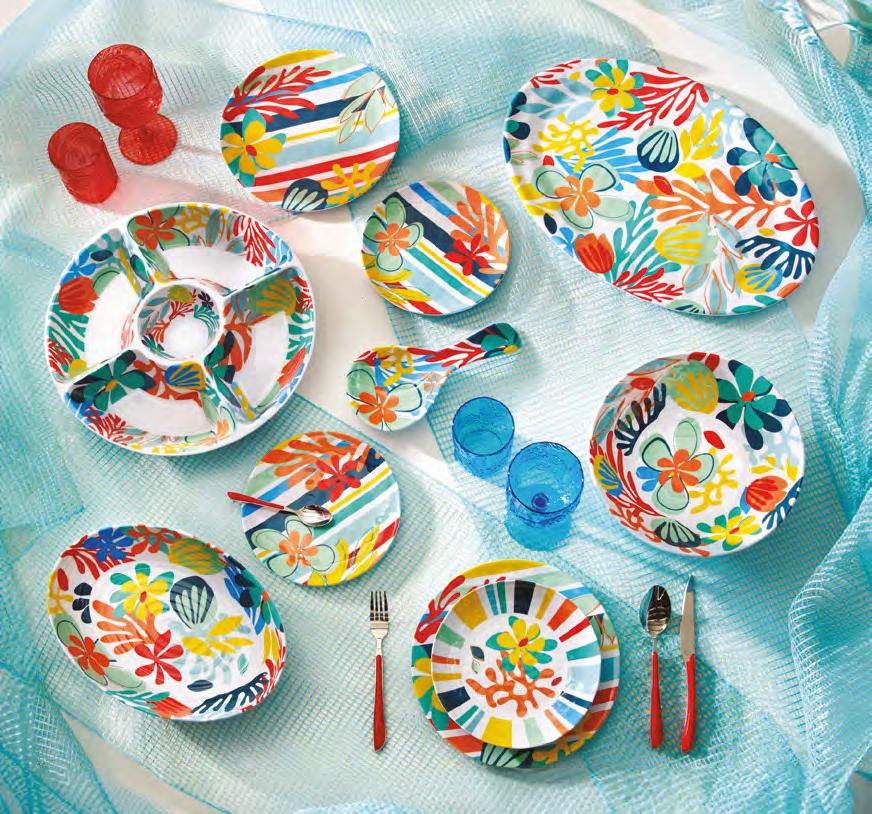
Transparent, featuring a diamond-relief pattern and exceptional durability: the Picnic collection by Sagaform, distributed by Schoenhuber, shines thanks to its versatile practicality. Crafted from durable acrylic (not dishwasher-safe), the line includes dinner plates (diameter 26 cm), a cutlery set (comprising four knives, four forks, and four spoons), a pitcher, and coffee cups—ideal for organizing picnics, outdoor lunches, boating trips, and camping vacations.
Thaiti by Brandani pays tribute to the vibrant colors and atmosphere of the tropics. This new melamine collection brings an explosion of lively shades to the table, from rainbow stripes to floral decorations. Lightweight, durable, and practical, the range features plates, trays, and serving dishes with compartments for appetizers and finger foods. It can be coordinated with the Tropical goblets, glasses, and carafes, all made from 100% colored melamine featuring 3D decorations.
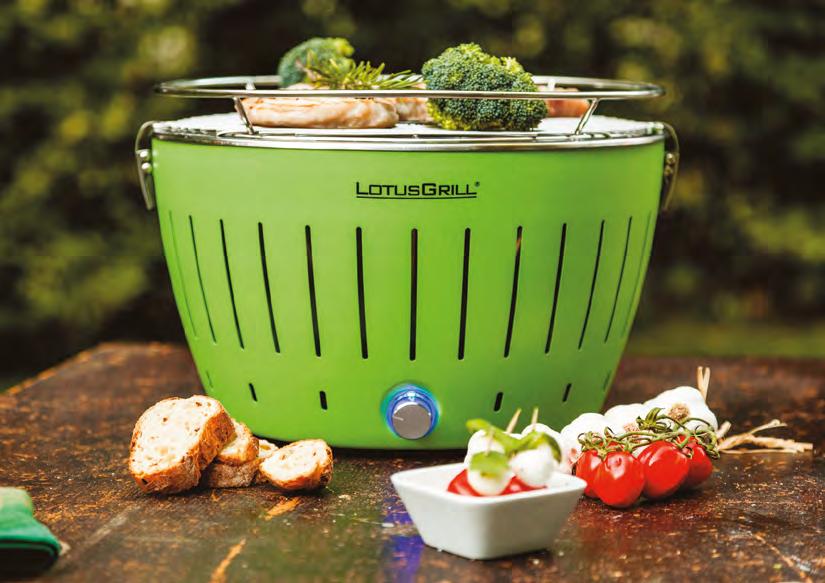
Lotus Grill, distributed by Kunzi, is the ultimate compact, portable BBQ. Ideal both on terraces and boats, it features easy ignition thanks to its battery-operated fan and temperature control ignition button. Its airtight charcoal compartment eliminates any risk of fire. Moreover, it produces no smoke, allowing for healthy cooking with lower fat and calories. Available in various colors and sizes (grill diameter 25.8, 32, or 40.5 cm), it also offers accessories such as a wheeled stand, glass lid or hood, stone plate, Teppanyaki plate, and silicone tongs suitable for high temperatures.
Timeless nautical style defines Riviera by Guzzini, the new tableware collection designed by Pio&Tito Toso (with graphic design by Rosanna Grigolon). The line plays elegantly with a white and blue color palette, enriched by colorful brushstrokes and irregular shapes that evoke handmade charm. Perfect for outdoor table settings by the pool or aboard yachts, this collection includes dinner plates, soup plates, dessert plates, bowls ranging from 8 to 30 cm in diameter, salad servers, an oval risotto dish that doubles as a fruit bowl or centerpiece, and four oval serving trays.
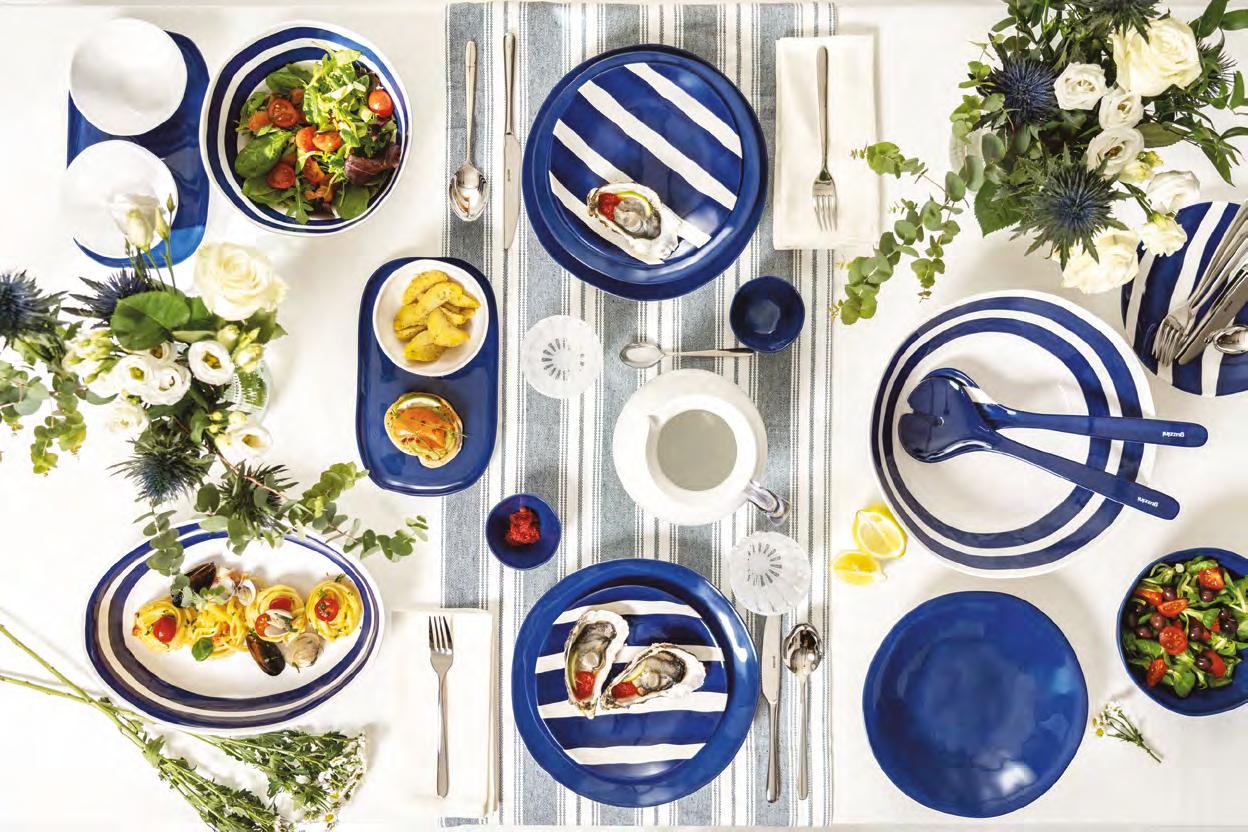
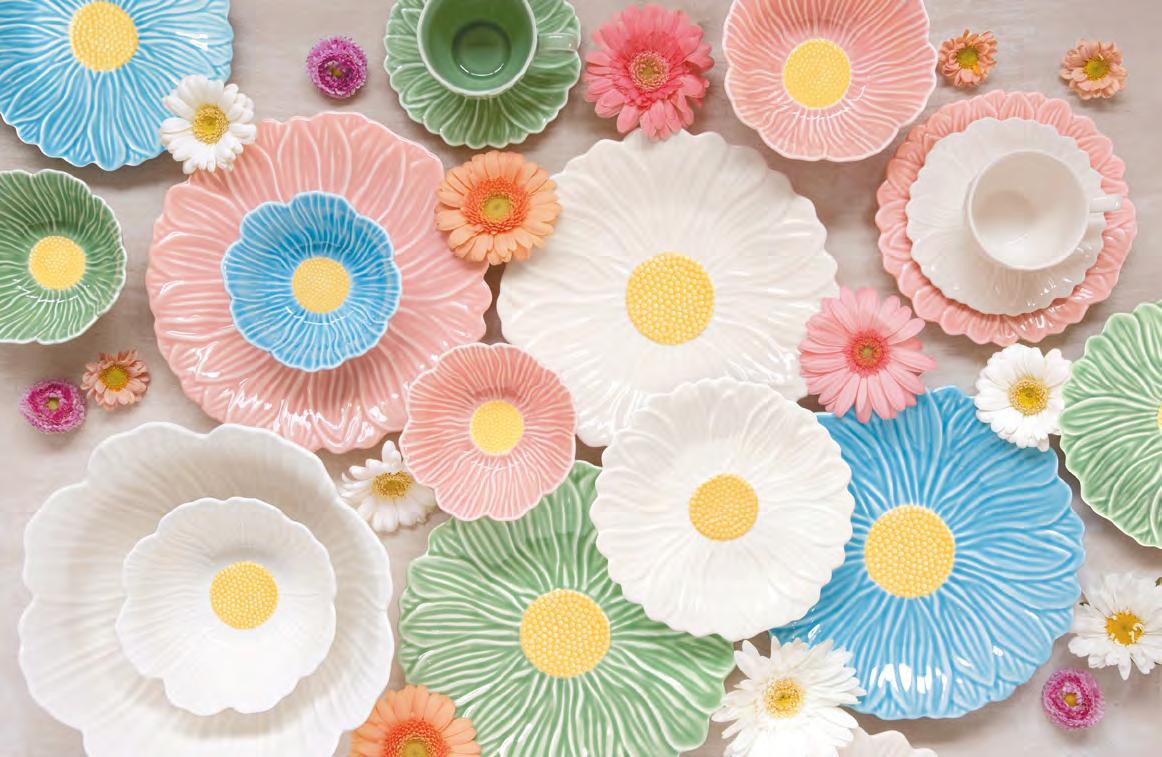
Daisy by Easylife is a joyful celebration of spring freshness. The tableware features oversized daisies in pastel shades (soft pink, mint green, sky blue, and white) across plates, cups, bowls, small dishes, and cake stands. The embossed petal decoration with buttery yellow centers creates delightful floral scenes ideal for outdoor brunches, stylish picnics, and special breakfasts.
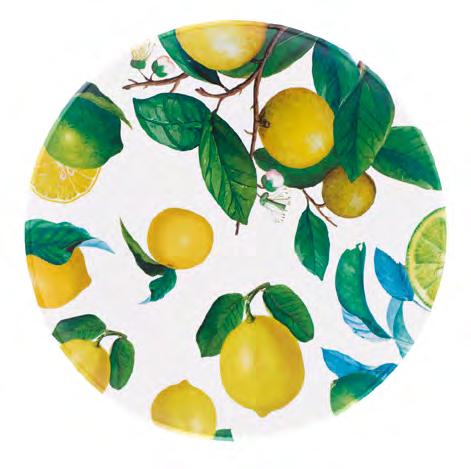
An exciting innovation unveiled at Maison&Objet 2025, Sorrento by TOUCH-Mel, a brand under the Serafino Zani group, is the first and only melamine tableware collection suitable for microwave use. Designed with an authentic Mediterranean flair, the line showcases a white background adorned with lemon motifs and comprises dinner plates, soup plates, dessert plates, a medium bowl, salad bowl, large rectangular tray, small rectangular tray, and a large oval tray.
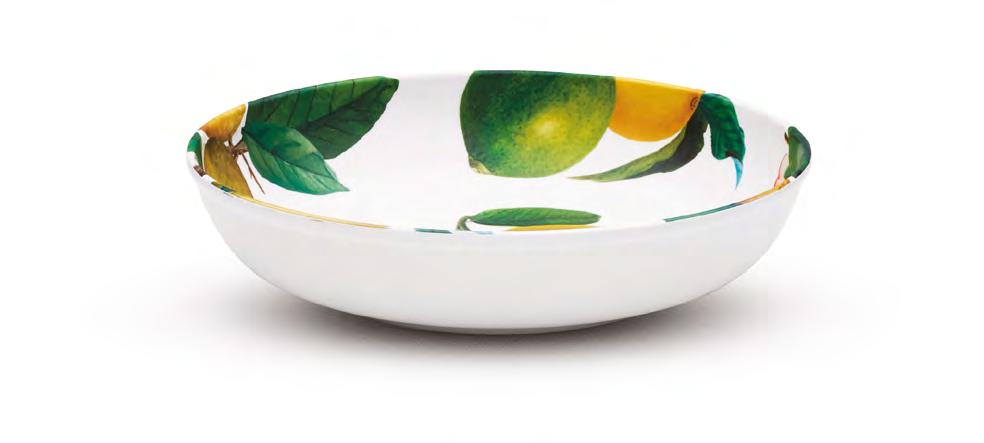
Cassera Casa, a brand of the Cotonificio Zambaiti group, presents ReLux, an exclusive upcycled spring collection (plastic-free) giving new life to fine fabrics. A limited edition featuring vintage-inspired archival patterns, it updates jacquards, friande fabrics, cottons, and linens with modern digital reprinting techniques, sartorial finishes, or artistic patchwork designs.
Tablecloths, runners, sheets, pillowcases, and bedspreads come with a certificate of authenticity.
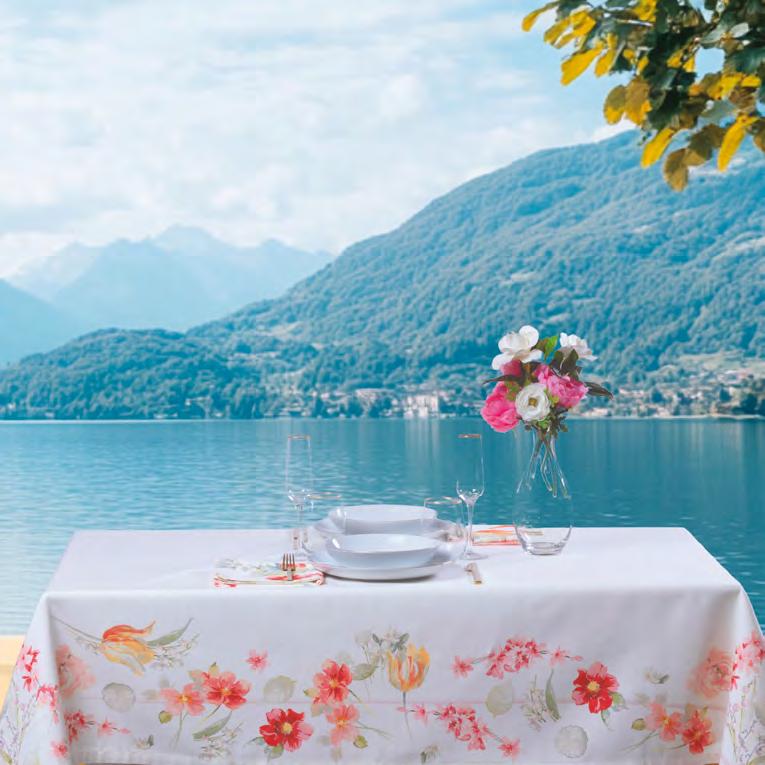
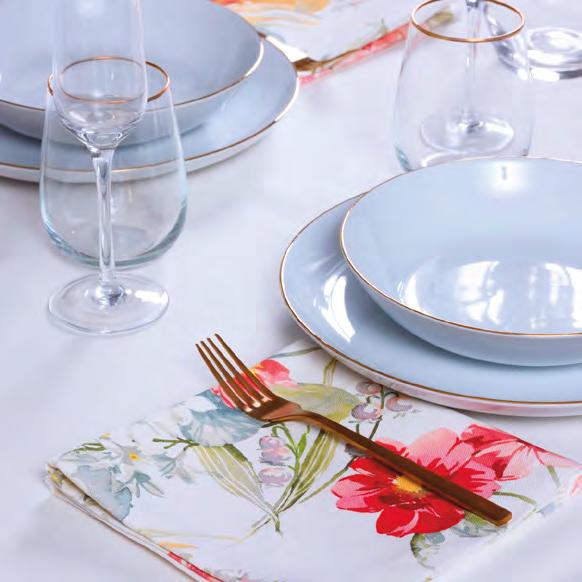
Compact, practical, and robust: the new Néo6 stainless steel pocket knife by Opinel is a versatile accessory to carry everywhere. Thanks to its patented closure, it reinvents the pocket-knife experience through an innovative and intuitive mechanism: OPIFLEX®, which requires no safety lock. The wooden handle is available in three elegant wood options—black walnut, olive, and ebony—finished with protective varnish resistant to wear and humidity.
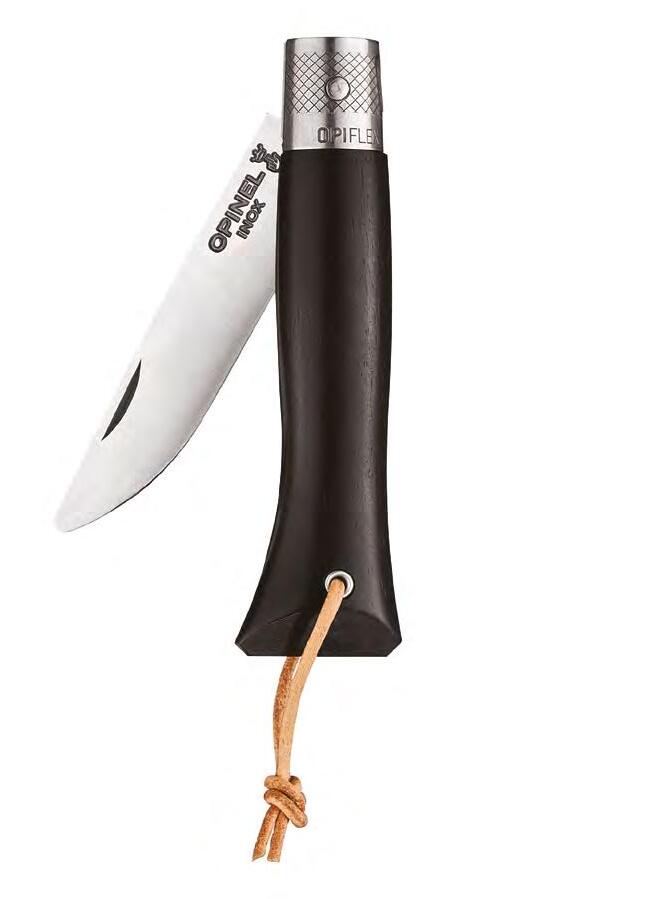
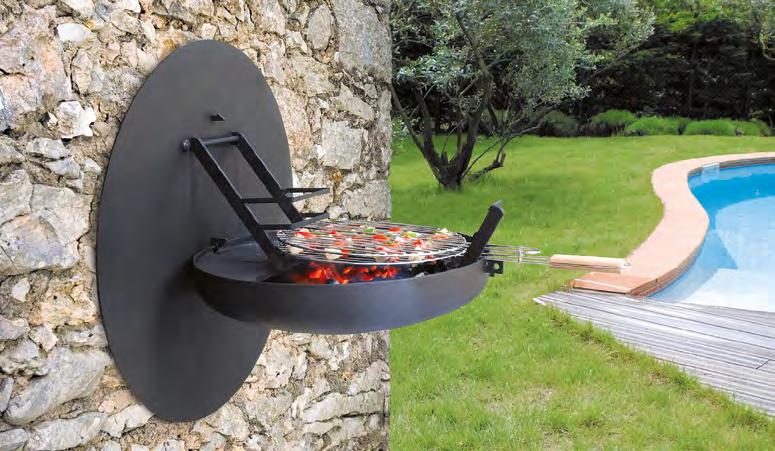
Sigmafocus by Focus is a new compact, wallmounted, space-saving barbecue. Ideal for those who want to enjoy grilling even on small balconies, it consists of a fixed wall-mounted disk protecting the wall from smoke and a practical ash container for quick and easy cleaning. Made of black steel, it conveniently folds flat against the wall when not in use.
The Zwilling Fresh&Save Bowls all-inone vacuum system optimizes kitchen space and well-being by keeping food fresh and flavorful up to five times longer than traditional storage methods. Featuring sturdy, stackable bowls made of stainless steel and glass, interchangeable lids also compatible with the Staub Ceramique collection, and numerous accessories for chopping and grating.
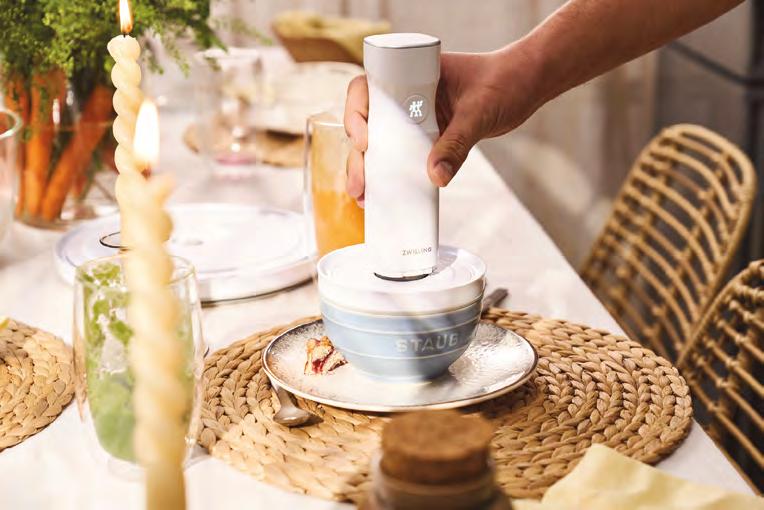
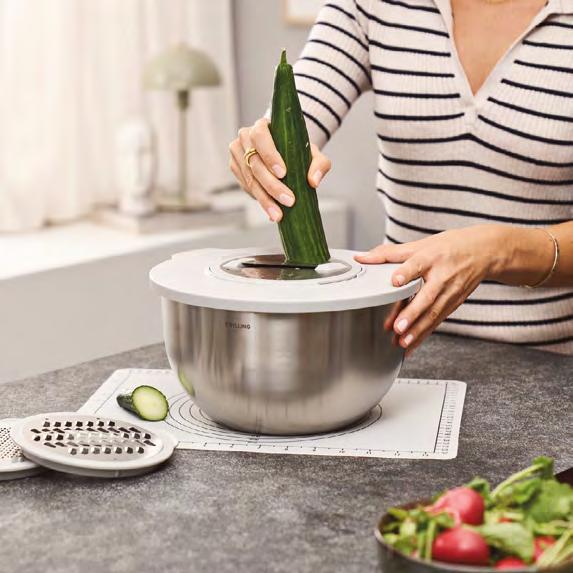
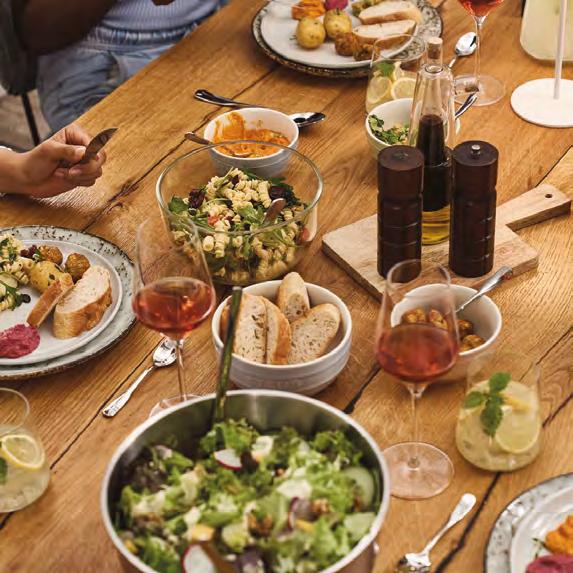
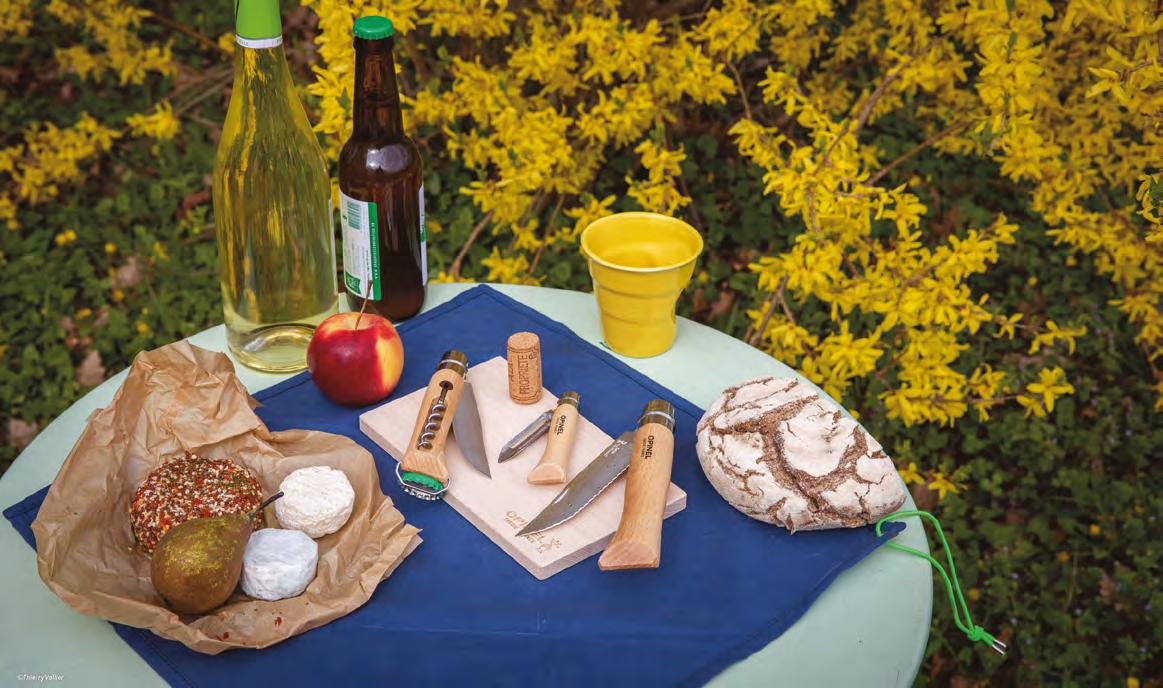
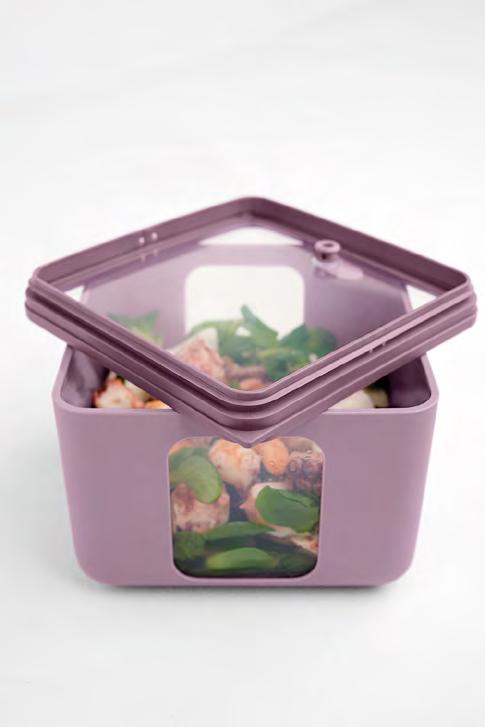
Featuring a corkscrew and bottle opener knife, vegetable peeler, serrated knife, mini wooden cutting board, and microfiber cloth that doubles as both placemat and carrying case, Opinel presents its Outdoor Kitchen Kit. Designed specifically for preparing meals outdoors, whether camping or boating, each utensil features handles crafted from varnished beechwood, stainless steel blades, and double safety rings.
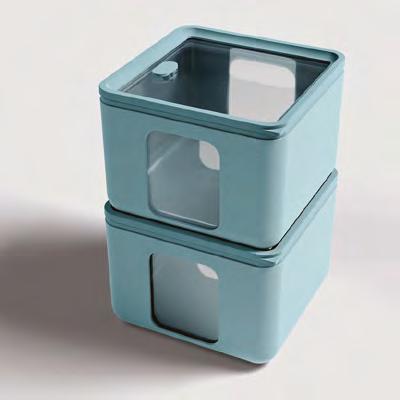
Maximum practicality meets stylish design: the Quadro square airtight containers from Bim Plus’s new Peek Box food storage collection are crafted from polypropylene, with transparent Lumicene lids and side windows. Versatile and space-saving, available in five different stackable sizes, they conveniently nest inside each other when not in use. Suitable for fridge, pantry, microwave, dishwasher, or travel, these fully recyclable, highquality containers offer exceptional durability and airtight sealing, ideal for boating use. Available in six colors.
Minimalist design, advanced technology, and total comfort: the BBQ station (Swiss Design Engineering) by Outdoorchef, a brand specialized in gas barbecues distributed by Kunzi, delivers multiple cooking methods with professional performance and an extensive range of accessories, such as glass grills, windshields, and storage solutions for keeping all cooking utensils neatly organized.
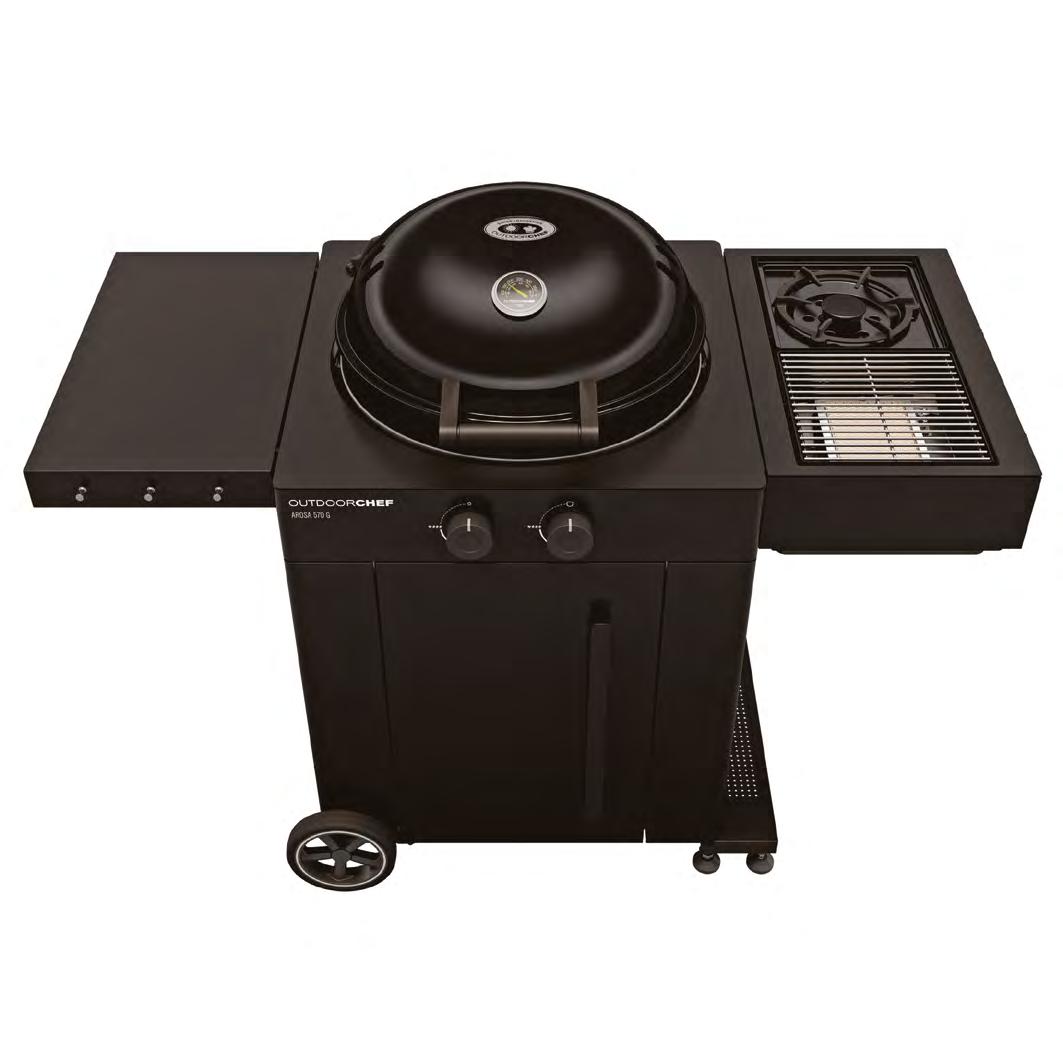
Air, Water, and Earth: these natural elements inspire the colors of Vanity Italian Beauty by Guzzini, a new collection blending lively transparent textures with remarkable sustainability. Designed by Pio&Tito Toso, Vanity is made in Italy from special bio-based acrylic crystal, a renewable, modern, fossil-free organic material derived from vegetable waste. The complete collection includes everything required for an aperitif: tall and short glasses, carafes with lids and chilling bulbs or infusers, serving bowls with salad servers available in five sizes (12, 16, 20, 25, 30 cm diameter), round and oval trays, a double-faced cake plate, and a cake stand with dome.
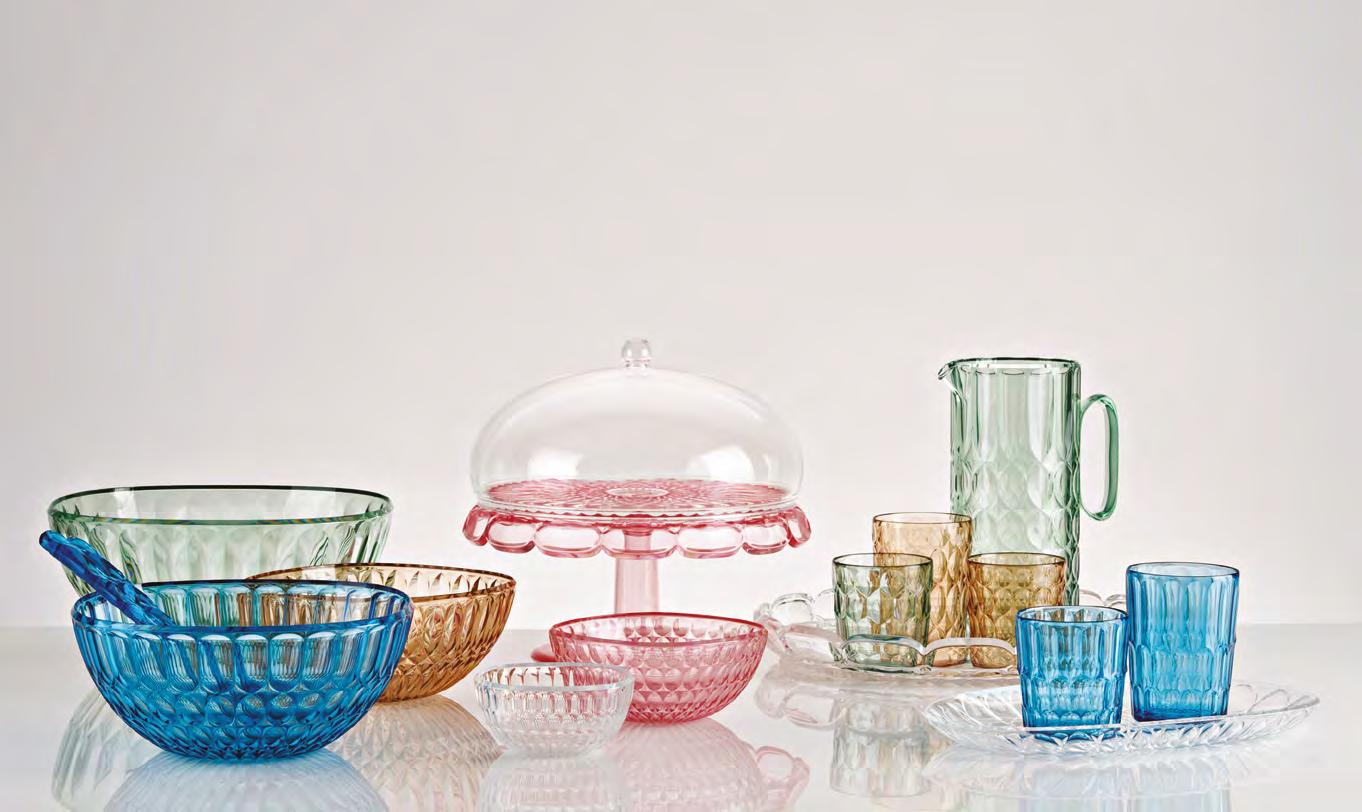
The Arcturus Group, a leader in the tableware industry encompassing prestigious brands such as Sambonet, Paderno, Arthur Krupp, Rosenthal, Ercuis, and Raynaud, focuses on digital and branding strategies for 2025: an interview with Matteo Blandi, the new Chief Marketing Officer
by Giulia Arrigoni
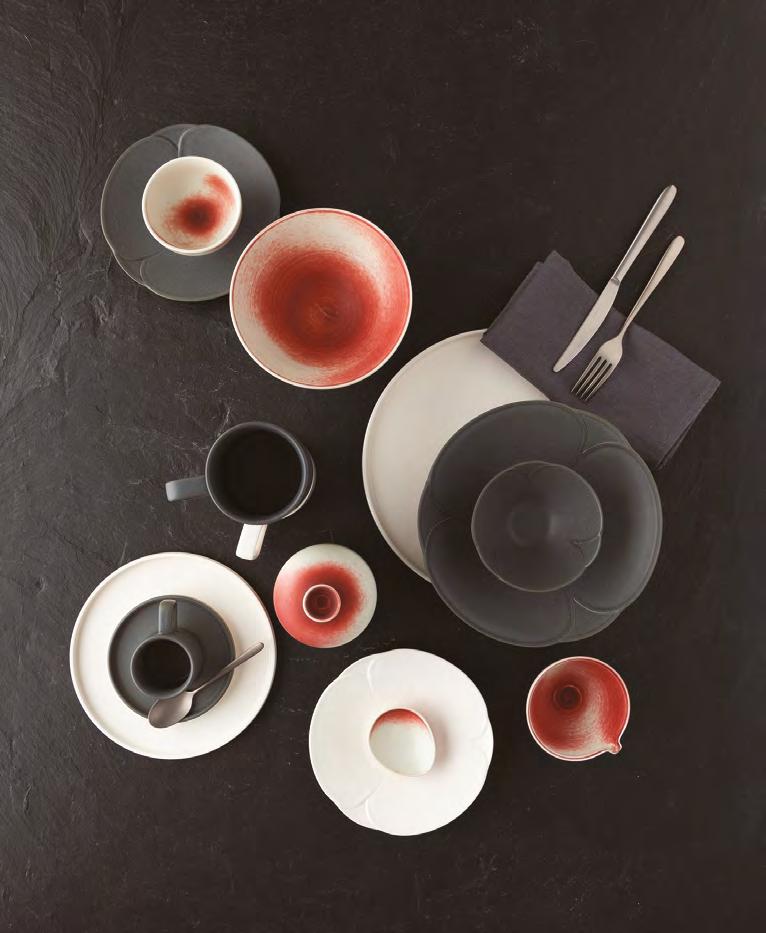
Matteo Blandi assumed the role of Chief Marketing Of cer at Arcturus Group in June 2024. This meeting provided an opportunity to discuss strategies for 2025, a year promising signi cant developments for the Italian group specialized in tableware production.
You bring extensive and diverse marketing experience. Could you share the path that led you to Arcturus Group?
I started my career in cosmetics, transitioned
into fashion accessories, and then moved to the automotive sector. My professional journey has always involved renowned brands characterized by strong product-centricity and compelling narratives. With Arcturus, this strategic mindset will continue, leveraging the group’s exceptional brand portfolio. Joining Arcturus appealed to me because of its prestigious heritage brands like Sambonet and Rosenthal, which produce locally with high-level R&D. I am excited about the opportunity to broaden these brands' reach while preserving their authenticity and tradition.
Is brand value still central, or have recent market dynamics challenged it? How can brands reinforce themselves in an increasingly competitive market?
Brand value remains pivotal but must remain authentic and deliver on consumer expectations. A strong brand is akin to an appealing book cover—attractive yet meaningful primarily due to its content. Consumers seek products with intrinsic value rooted in tradition. This differentiation sets apart genuinely valuable brands from products focusing solely on short-term pro ta-
bility. A brand's true strength lies in its ability to authentically narrate its story, production processes, research, and design.
Is Made in Italy still an added value globally?
Absolutely. Made in Italy symbolizes excellence, meticulous attention to detail, and innovation. It's a strategic approach re ected in quality, research, sustainability, and detail-oriented practices. What impressed me about Arcturus
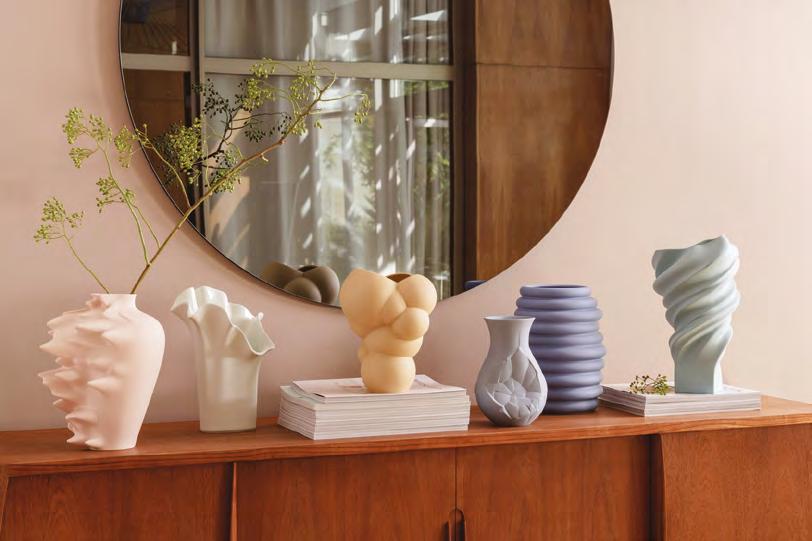
was precisely this synergy between product excellence and production processes—each stage embodying strategic thought. Though Made in Italy now includes collaborations with external suppliers, maintaining quality standards and brand values is paramount.
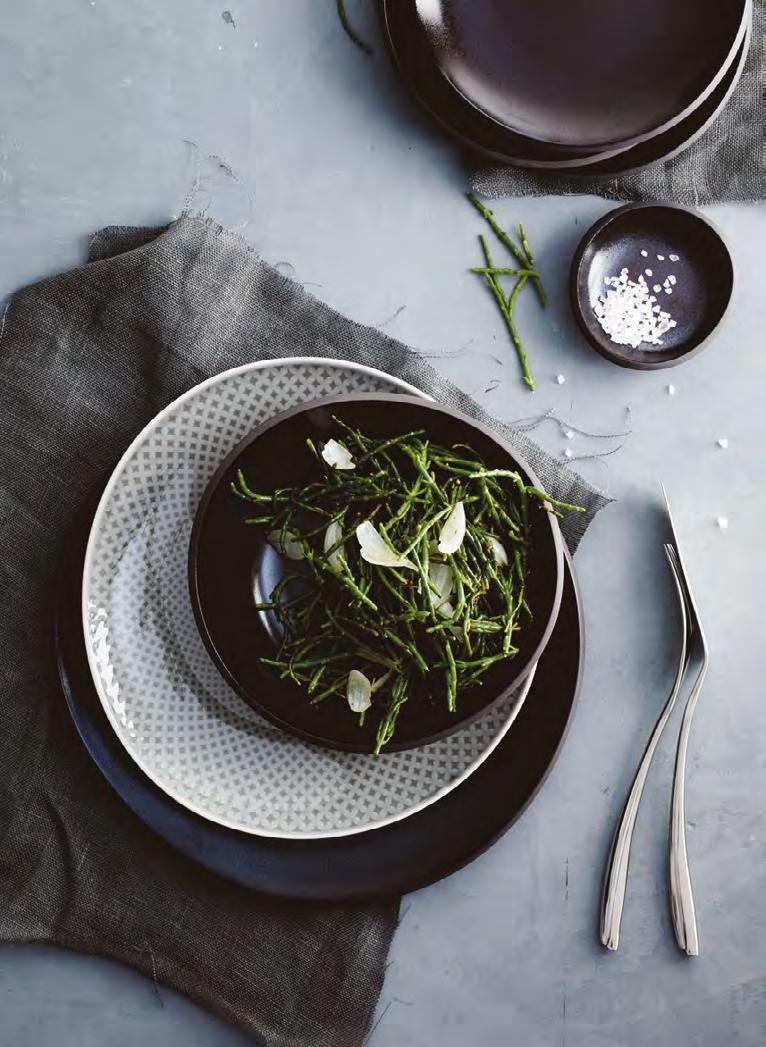
What impact have you had during your initial months at Arcturus, considering the difference from your previous industries?
Entering the tableware industry has been highly stimulating. The market is undergoing profound changes, with evolving consumer behaviors, heightened competition, and the entry of nontraditional players like IKEA, Zara Home, H&M Home, and even prominent fashion brands like Dolce&Gabbana, Versace, Prada, and others. Furthermore, newer generations prefer practical and exible products. This drives us to innovate, expanding our offerings into gifting and interior decor and strengthening our digital presence. Additionally, the expansion into hospitality and HoReCa sectors is becoming increasingly signi cant. Amidst this complexity, effectively communicating our narrative is crucial—exempli ed by Sambonet’s strategic rebranding process initiated in 2024.

Matteo Blandi, Chief Marketing Officer Arcturus Group
How does Arcturus Group intend to tackle market challenges in 2025?
2025 will be pivotal. For Sambonet, we will continue to promote the "100" collection, celebrating Roberto Sambonet’s centenary and his key in uence, while expanding the "Radici" line for the buffet sector, which has been very successful. For Rosenthal, the 2025 highlight is "Sonetto," a specialized HoReCa collection introduced at Ambiente Fair in February, notable for its exible and innovative design. Rosenthal will also see expansions in iconic collections like TAC by Walter Gropius and new color variants for Francis Carreau. Licensing partnerships, such as our longstanding collaboration with Versace and our renewed agreement with Swarovski—which will expand further with a new collection launch during Design Week— are also strategic focuses. Crucially, we aim to consolidate Arcturus Group’s identity, clearly communicating the strategic cohesion and value of our brand portfolio.
What are the communication and marketing priorities?
Digital channels, notably social media and inuencer marketing, will be our primary means of communicating directly with end consumers. Regarding B2B operators, we are enhancing group-wide management and optimizing digital
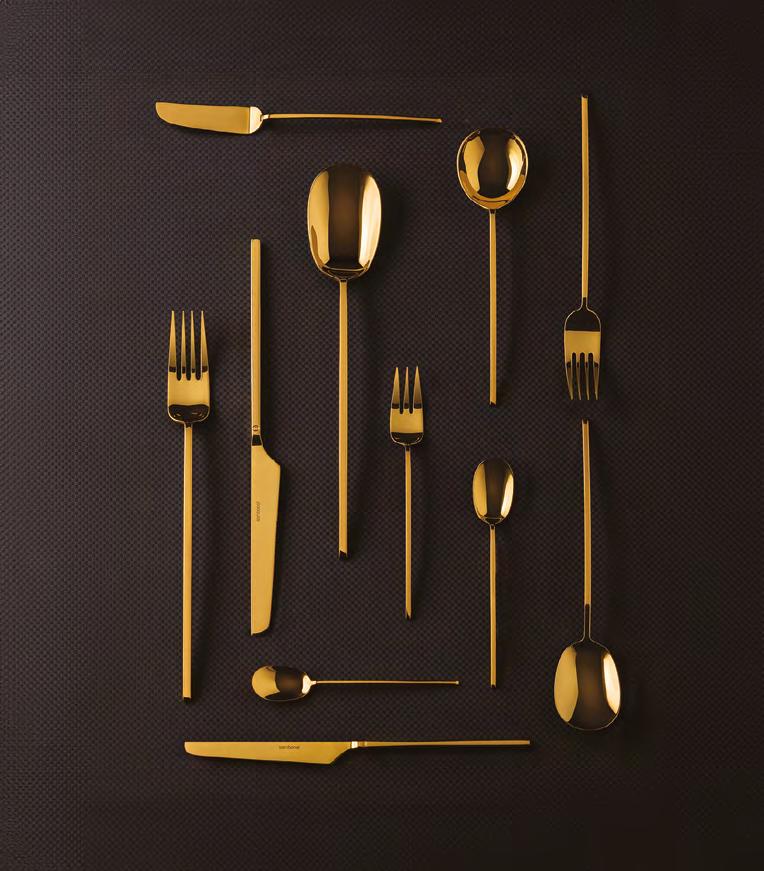
platforms to streamline ordering processes. Additionally, our e-commerce strategy must harmoniously balance traditional retail, which remains a business cornerstone. We are committed to delivering integrated experiences that effectively blend digital innovation with physical presence, thereby strengthening our brands.
Lastly, what are your keywords for 2025? I'd say "digital" and "brand." Digital platforms are essential for engaging today’s consumers, whereas our brands represent our distinctive value. The challenge lies in authentically narrating stories and fostering meaningful connections, all while preserving our brands' heritage.
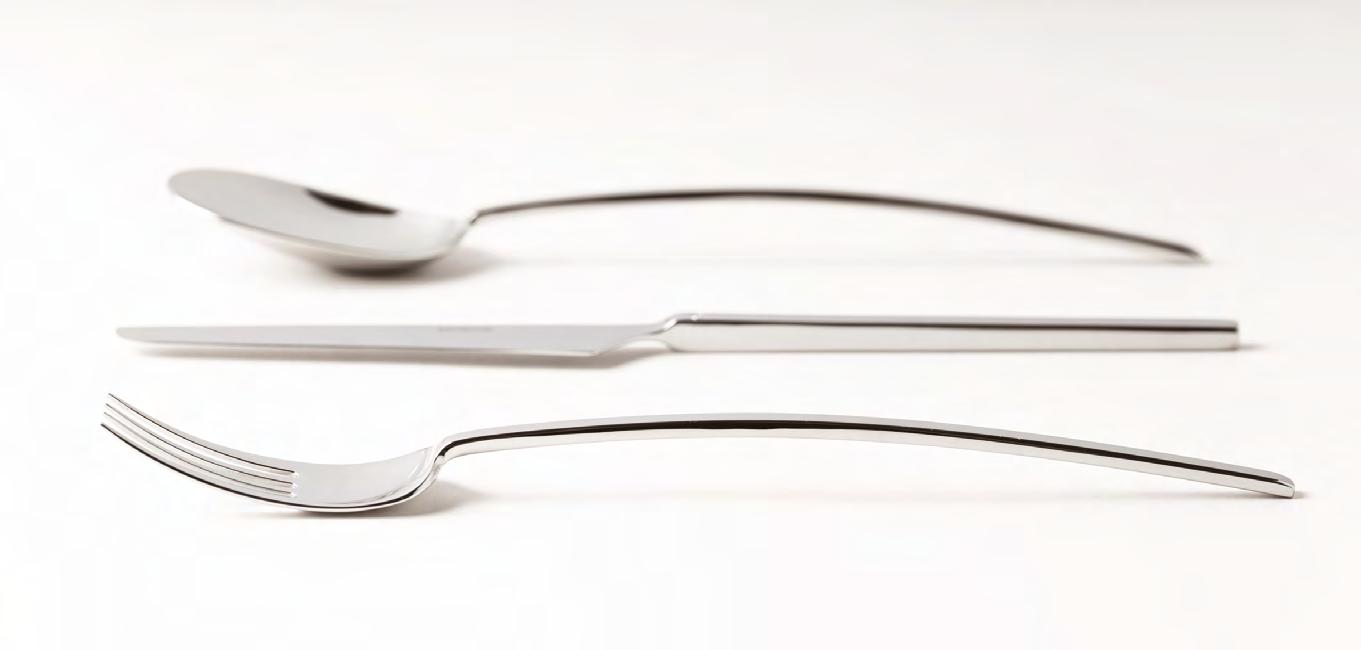

On the occasion of the 2025 edition of Milano HOME, ART collaborated with SPIN Confcommercio (Sportello Innovazione Digitale) to organize two specialized retail workshops held within the exhibition venue. Titled "Digital Strategies, Tactics, and Tools 2025: Enhancing Traditional Retail Sales through Artificial Intelligence," these sessions attracted a large and attentive audience. Led by Piercarlo Pozzati, Head of Innovation Desk – SPIN Confcommercio Milano, the workshops explored the latest digital strategies aimed at improving sales in physical stores. Specific attention was given to emerging tools and tactics, emphasizing the integration of artificial intelligence to enhance online presence, improve customer experience, and strengthen commercial operations. Practical ideas and solutions to effectively bridge the digital and physical retail worlds were also presented.
Pozzati discussed the evolution of digital tools available even for small businesses, provided a checklist for assessing a store's digital presence, and elaborated on fundamental aspects such as creating and managing mobile-optimized websites, leveraging Google tools for geolocation and promotional activities, search engine optimization, and digital advertising. The final part of the workshop focused specifically on the use of generative AI in retail.
ART continues to actively develop operational tools designed to support and accelerate the comprehensive digitalization of the retail sector.
According to ISTAT's data, retail consumption showed growth in December, prompting Confcommercio’s Research Office to recognize this as a positive sign and noting that, after a negative first semester, 2024 closed with a recovery trend: "The realignment process of consumption to the positive trend in real income is gradually emerging, although at a slow and moderate pace."
Meanwhile, Nielsen/GfK identified significant growth in specific product categories during 2024, notably Air Fryers (+29.7% in value) and Food Preparation Devices (+16%). For 2025, forecasts suggest stabilization in both large and small household appliance segments, driven by demand for products that simplify daily life.
ART’s regular economic report, released at the end of January, indicates continued economic instability marked by a challenging coexistence of positive data and highly tense socio-political scenarios. The ART Business Sentiment, recorded at the end of Q4 2024, reflects cautious yet significant confidence among companies: approximately 70% expect general economic stability, while 23% anticipate growth. This moderately optimistic outlook is supported by indicators on inflation, unemployment, and household spending power. Thus, 2025 opens with promising expectations, underpinned by hopes that positive economic indicators will ultimately prevail over increasingly complex internal and international political-social dynamics, allowing for improved growth conditions.

ART continues its research and analysis of the Italian market, benefiting associated companies. Ahead of next year’s scheduled biennial Consumption Observatory update, the 2025 research efforts concentrate on two distinct areas: a detailed assessment of cookware sales through large retail channels, entrusted to Nielsen, and a customized industry brand study conducted by Format Research. The latter investigates distribution channels, product categories, sales trends, and participation in specialized trade fairs.
The first trade fairs of the year have set a clear path: the home of the future will be increasingly sustainable, smart, and personalized. Design embraces technology without compromising the importance of quality and craftsmanship. With these premises, 2025 promises to be a year rich in developments and fresh inspirations for the sector
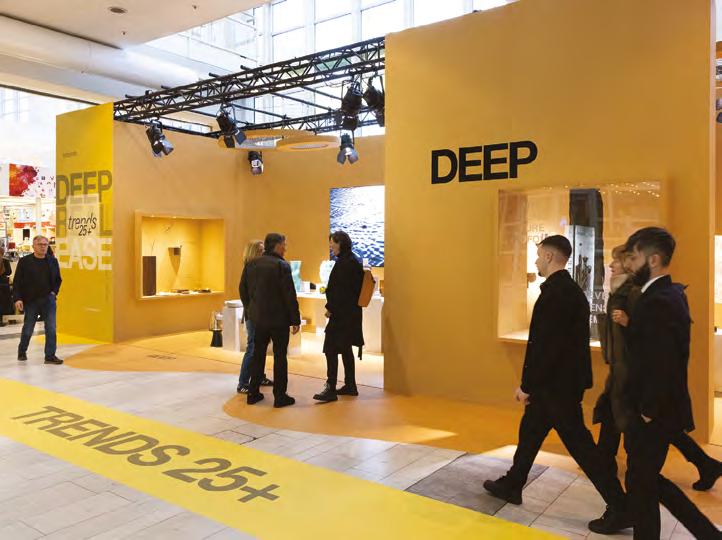
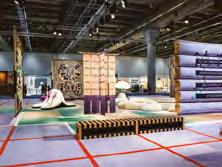


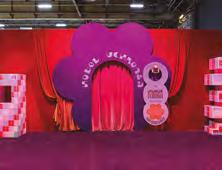






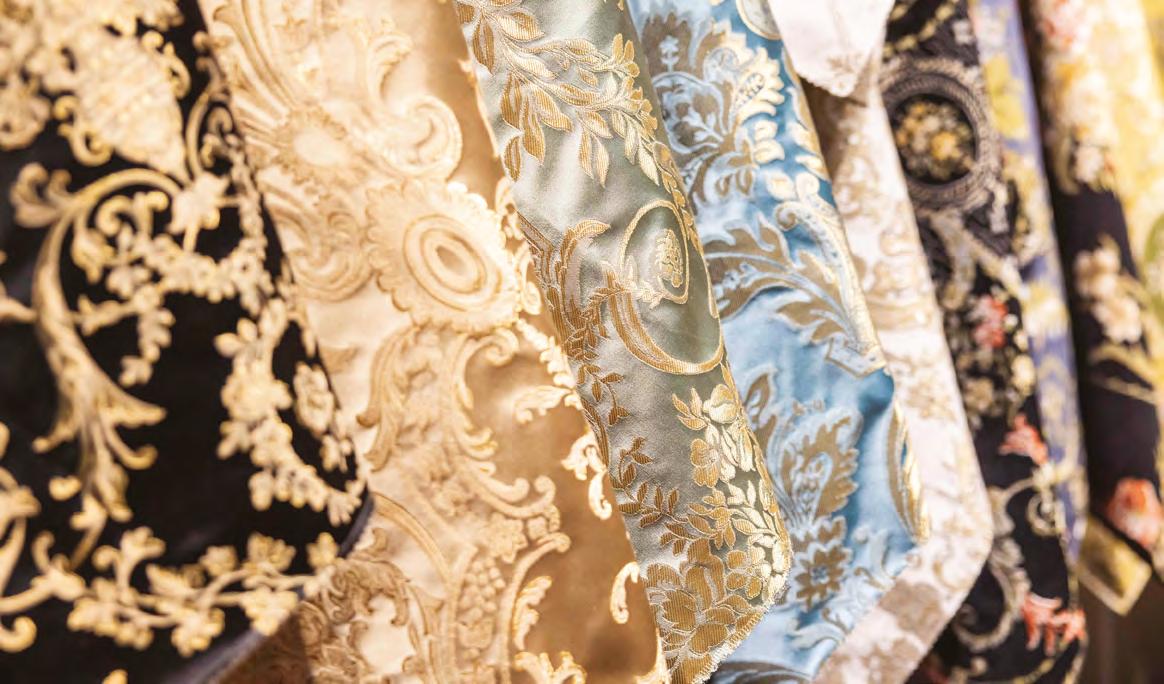
FRANKFURT, JANUARY 14-17
The world's leading home textile trade fair con rmed the industry's increasing focus on sustainability and new technologies. "Circular textiles" took center stage, with numerous companies presenting fabrics that are recycled, biodegradable, or derived from waste materials. Signi cant attention was given to advanced dyeing and digital printing technologies, which reduce water and chemical consum-
Next Event: JANUARY 13-16, 2026
ption. The integration of smart materials, such as thermoregulating textiles and photochromatic yarns that change color with light exposure, introduced innovative possibilities for interior design.
Color trends highlighted natural palettes— beige, sage green, terracotta—combined with soft, enveloping textures, ideal for creating cozy and relaxing environments.
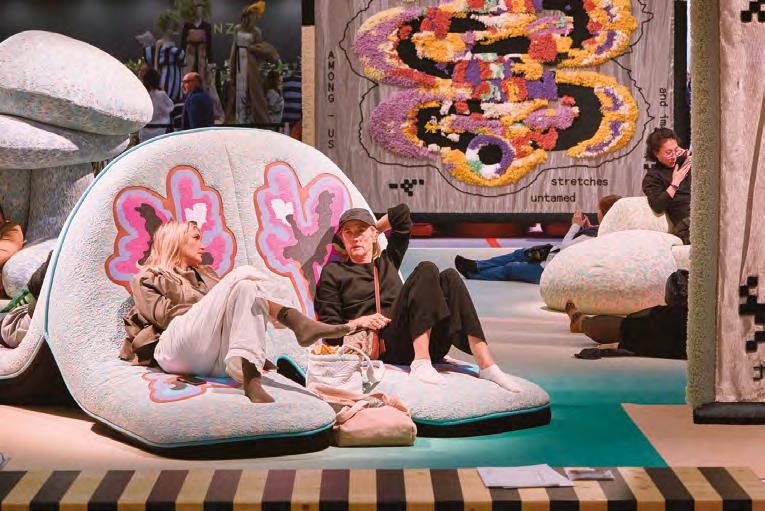
Atthe heart of Heimtextil 2025, designer Patricia Urquiola presented an exceptional installation titled 'Among-Us'. Merging design with sustainability, this installation captivated professionals and visitors alike through powerful visual and conceptual storytelling.
'Among-Us' explores the connections between humanity and the environment. Urquiola, renowned designer and architect, emphasized the importance of interaction between individuals and their surroundings, underscoring sustainability's essential role in contemporary design. The use of innovative materials and advanced techniques invites visitors to rethink the relationship between the individual and community.
Central to the installation were recycled and recyclable materials, showcasing the potential for reuse in textiles. Key elements included fabrics made from regenerated bers and eco-friendly solutions demonstrating how aesthetics and environmental responsibility can coexist. 'Among-Us' engaged visitors in an immersive sensory experience through integrated lighting, colors, and sounds, encouraging exploration of thematic areas that symbolized the bonds between humans, nature, and technology.
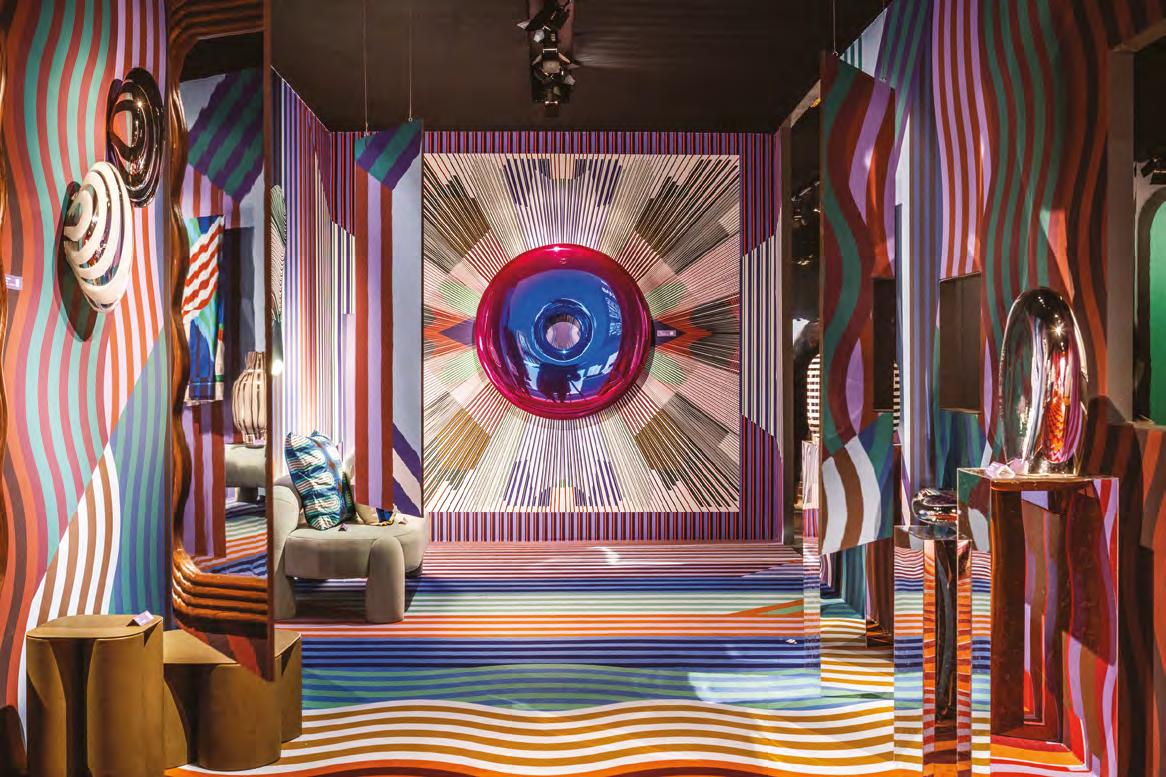
PARIS, JANUARY 16-20
The 2025 edition of Maison & Objet celebrated the synergy between design, technology, and craftsmanship, emphasizing uniqueness and personalization. The prominence of innovative materials, such as bioplastics and composites derived from industrial waste, demonstrated the sector's dedication to increasingly eco-friendly solutions. A standout trend was the resurgence of manual craftsmanship, highlighting pieces that value artisanal work and the beauty of imperfection. Numerous brands launched collections combining advanced modeling software with handcrafted techniques, illustrating how contemporary design can seamlessly integrate digital and artisanal elements.
Next Event: SEPTEMBER 4-8, 2025
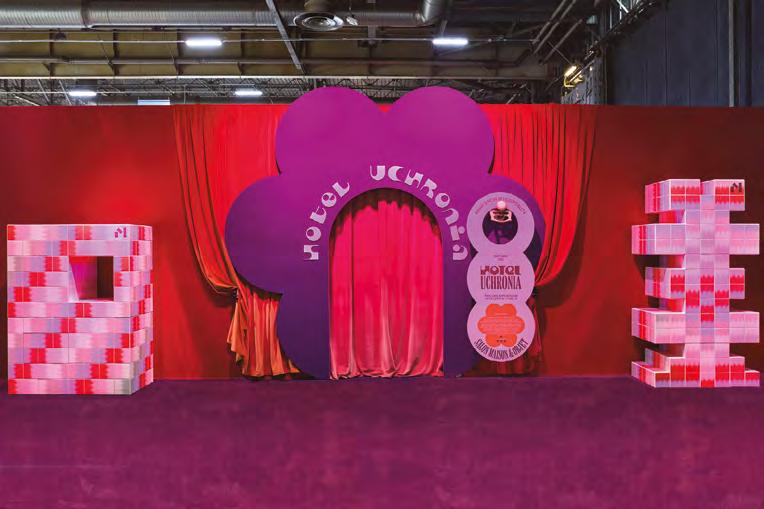
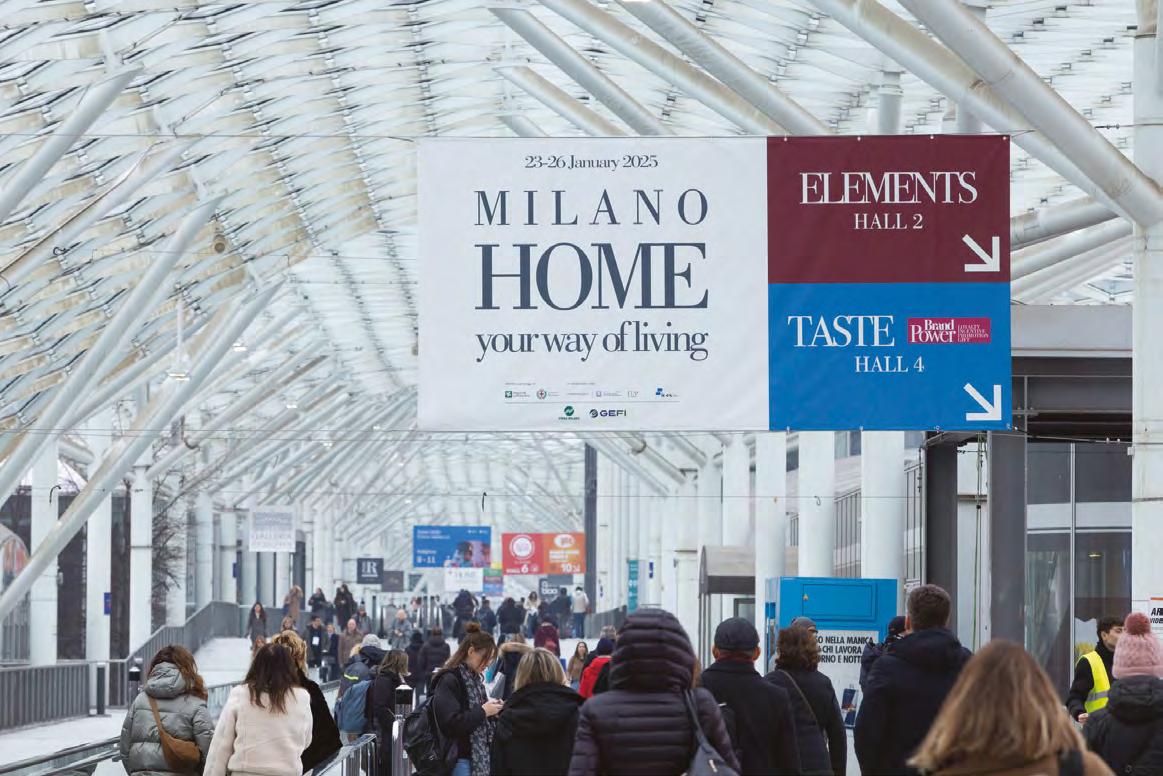
MILAN, JANUARY 23-26
Home, dedicated to home décor and lifestyle, showcased an edition strongly characterized by eco-friendly practices. Recycled materials and environmentally friendly production processes dominated the displayed collections, focusing particularly on certi ed wood, natural ceramics, and organic textiles.
A clear trend was the contemporary revival of handmade products, with brands emphasizing unique pieces and limited editions. Interest also rose in multifunctional furniture, re ecting increasingly hybrid and exible domestic spaces.
The emergence of bio-based materials, such as liquid wood and natural resins, presented novel applications not only in furnishings but also in lighting design.
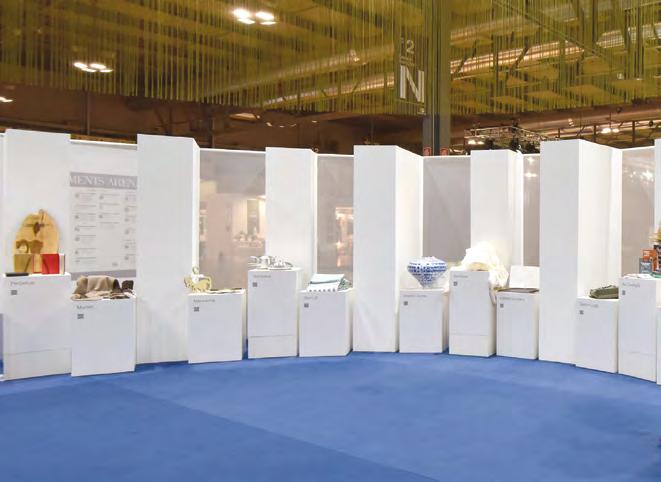
Next Event: JANUARY 22-25, 2026
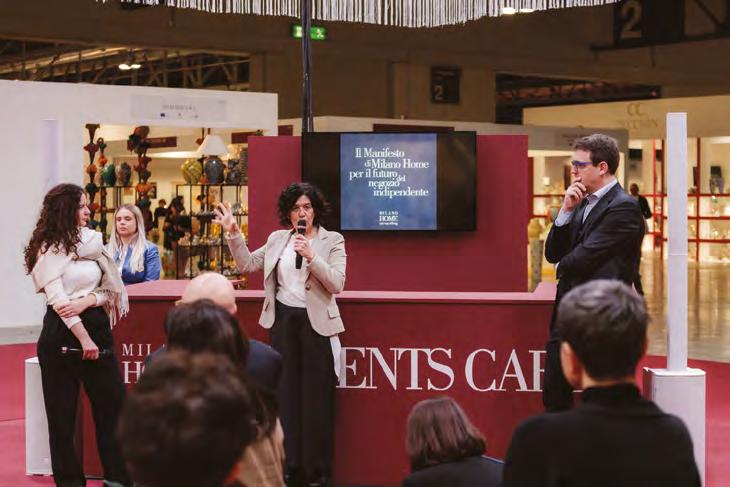
Next Event: FEBRUARY 6-10, 2026
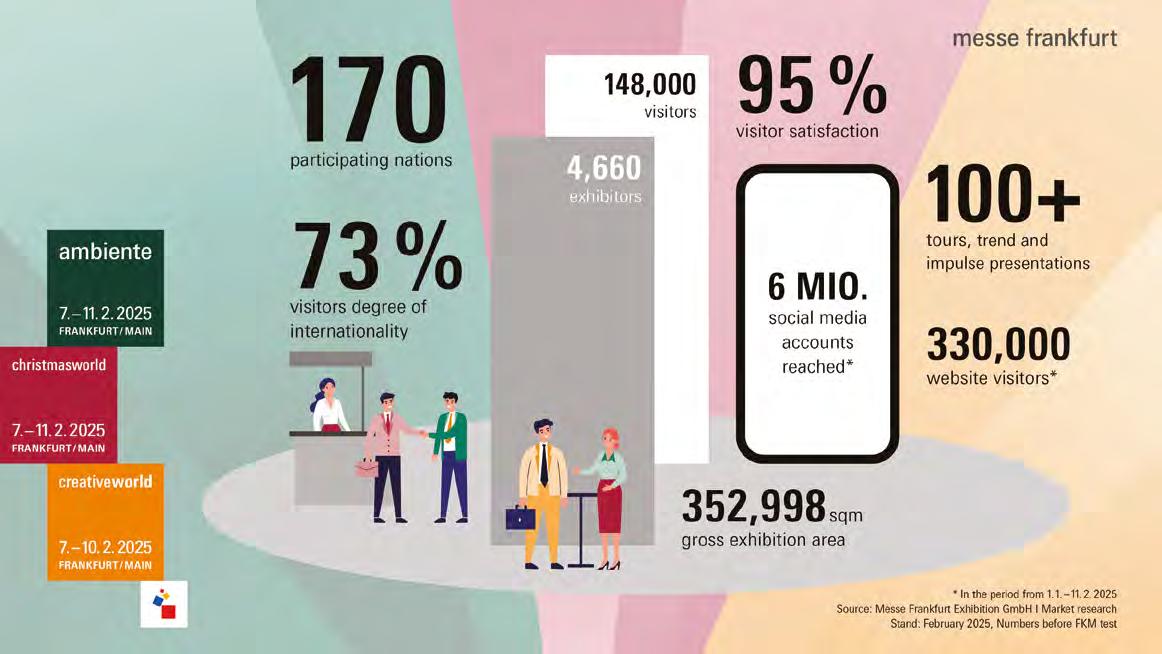
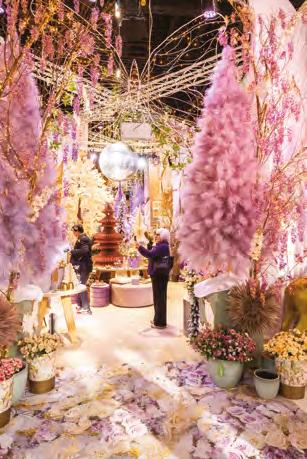
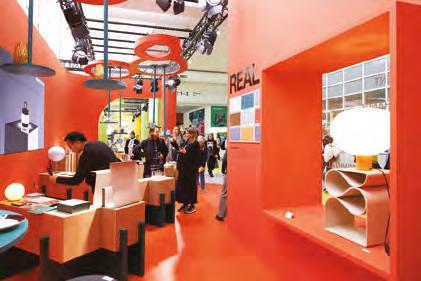
FRANKFURT, FEBRUARY 7-11
Combining Ambiente and Christmasworld created a unique exhibition panorama, showcasing trends in decoration, tableware, gifting, and lifestyle. The event’s common thread was the pursuit of new sustainable aesthetics, featuring reduced packaging, biodegradable materials, and reusable decorations.
In tableware trends, a mix-and-match approach combined natural and technological materials: porcelain enhanced with carbon ber details, recycled
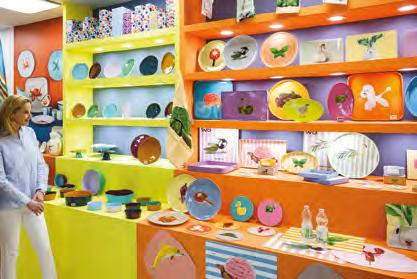
steel cutlery, and blown glassware with mineral inclusions enhancing luminosity. New collections moved away from pure white, embracing warm colors and nature-inspired patterns.
Christmasworld highlighted an increasingly green future for holiday decor, emphasizing durable decorations made from recycled or even edible materials, along with low-energy LED lighting and smart automation systems.
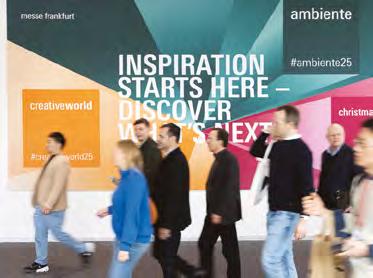
CHICAGO, MARCH 2-4
Chicago’s key home and kitchen event showcased a surge in smart home technology and domestic wellness. Remarkable innovations included AI-integrated appliances: ovens autonomously adjusting temperatures according to recipes, refrigerators analyzing contents and suggesting anti-waste recipes, and kitchen appliances communicating to optimize meal preparation times.
Wellness trends extended to kitchenware, emphasizing non-toxic materials, borosilicate glass containers, and antibacterial surfaces. Functional minimalism dominated design aesthetics, characterized by clean lines, neutral colors, and an emphasis on practicality combined with elegance.

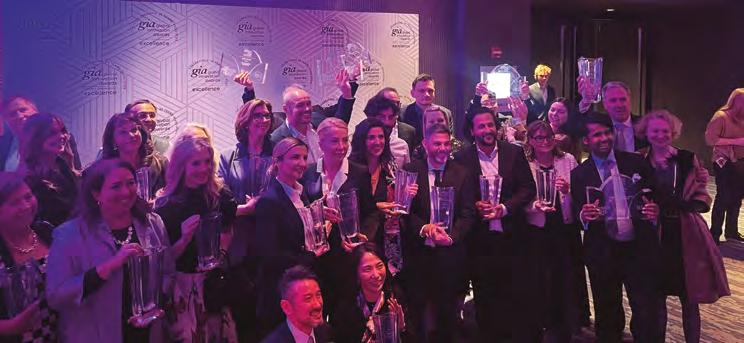
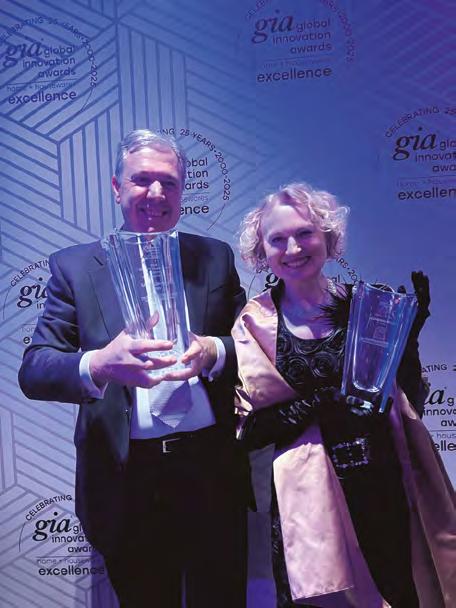
The Inspired Home Show, the Global Innovation Awards (gia), celebrating excellence and innovation in retail for home and kitchen products, recognized outstanding participants from 30 countries. Italy’s Morandin Regali was awarded the prestigious Martin M. Pegler Award for Excellence in Visual Merchandising, highlighting their commitment to creating captivating, innovative retail spaces that offer customers a unique and engaging experience.
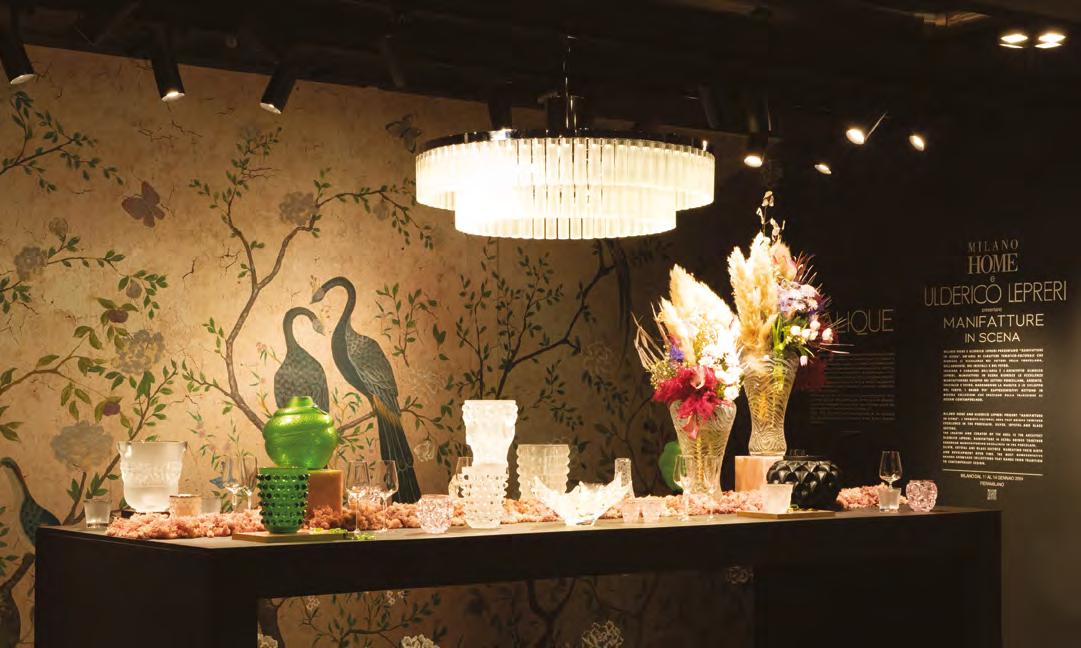
Lalique Theatre created for Manifatture in Scena 2024
A showcase of crystal collections styled with French elegance, illuminated by expertly calibrated theatrical spotlights
by Claudio Ravel
Milano Home hosted the second edition of Manifatture in Scena, a project conceived and promoted by architect and aesthete Ulderico Lepreri. For this edition, the stages were arranged to converge towards a central focal point—an ideal square that welcomed the theatrical displays of Italian and international manufactories. Following the ac-

claim and success of the previous edition, the initiative once again showcased European excellence in porcelain, crystal, and glass craftsmanship, narrating their history and evolution through evocative exhibition spaces.
The international elite of the Art de la Table participated, featuring brands with centuries-old legacies alongside emerging artisans, all united by the creation of globally celebrated pieces. “The selection of exhibitors was the result of meticulous curation,” explains architect Lepreri, “designed to offer visitors and buyers a comprehensive overview of the world’s most re ned and impactful creations.”
Architect Lepreri, could you give us a brief portrait of the highlights presented at Manifatture in Scena?
“With over 300 years of history, Meissen, a global leader in European porcelain, presented its exquisite creations. The display offered a historical journey through unique examples of deep and at plates in various colors and shapes, complemented by a three-dimensional dive into the history of their decorative archives, culminating
in contemporary designs. Meissen stands as the Empress among porcelain manufacturers worldwide.
Another prestigious name was Seguso Vetri d’Arte, a historic Murano glassworks founded in 1397 and still managed by the same family after 23 generations. Visitors admired the evolution of blown glass through unique pieces also displayed in major international museums.
Rogaska, a crystal manufacturer established in 1927 and a global leader in tableware and home décor, showcased collections distinguished by their unique color combinations. Noritake, the renowned Japanese manufacturer, illustrated the evolution of its designs and decorations, deeply intertwined with the history of Japan’s Imperial Household.
The Real Fabbrica di Capodimonte exhibited rened works re ecting the centuries-old mastery of its artisans. Baroni Porcellane, with its elegant hand-painted decorations, represents one of Italy’s most contemporary manufactories. Haviland & Parlon presented colorful Limoges porcelain compositions, blending modern designs with the brand’s rich heritage.”
What were the key innovations compared to the rst edition?
“The rst edition focused on the historical evolution of store design for homeware and wedding gift registries, with large theatrical window displays. This year’s major innovation was the scenic layout: while last year’s setting was linear, this edition featured stages facing a central focal point—an ideal piazza, with prosceniums directed towards the heart of the exhibition space. This layout revolution allowed for an immediate perception of the overall environment while preserving the individual identity of each brand within its dedicated frame. Micro-architectures with canopy displays rotated around a central hub, along a perspective promenade that uni ed the space.”
This experiential journey through beauty and exclusivity re ects Lepreri’s design philosophy: creating emotional spaces where the customer is no longer a passive consumer but a ‘new client,’ fully engaged in an ever-evolving atmosphere. Lepreri draws inspiration from the late Roman Baroque architecture of Borromini and Bernini, while the thinking of Christian Norberg-Schulz, architectural theorist and author of Baroque Architecture, has been instrumental in shaping his approach.
For the Romans, the Genius Loci embodied the inner spirit of a place. In architecture, this concept translates into carefully crafted design choices, material selections, and aesthetic principles that honor the history, traditions, and context of
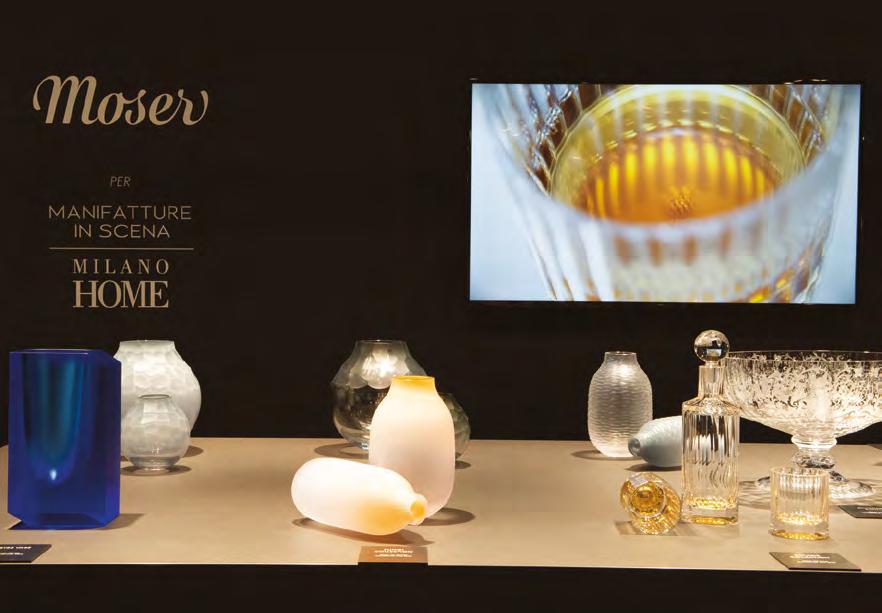
each project. Emotional spaces must spark a desire to purchase while creating an immersive reality that engages all the senses.
“I do not believe in retail spaces fragmented into discordant corners, which result in a dissonant effect. I favor a uni ed and harmonious environment, with consistent design and perceptual elements that narrate the identity of the store. Brand enhancement should occur through logos and a visually cohesive layout.” Manifatture in Scena also hosted mise en place demonstrations, which could be adapted as in-store window displays.
Founder of Ulderico Lepreri Design Project, based in Milan, Lepreri has designed over 250 retail spaces for the jewelry and homeware sectors since 1990, collaborating with prestigious Italian and international luxury brands.
He has curated signi cant exhibitions, including Tavole & Favole at Fortezza da Basso in Florence (later restaged at Palazzo Butera in Palermo),
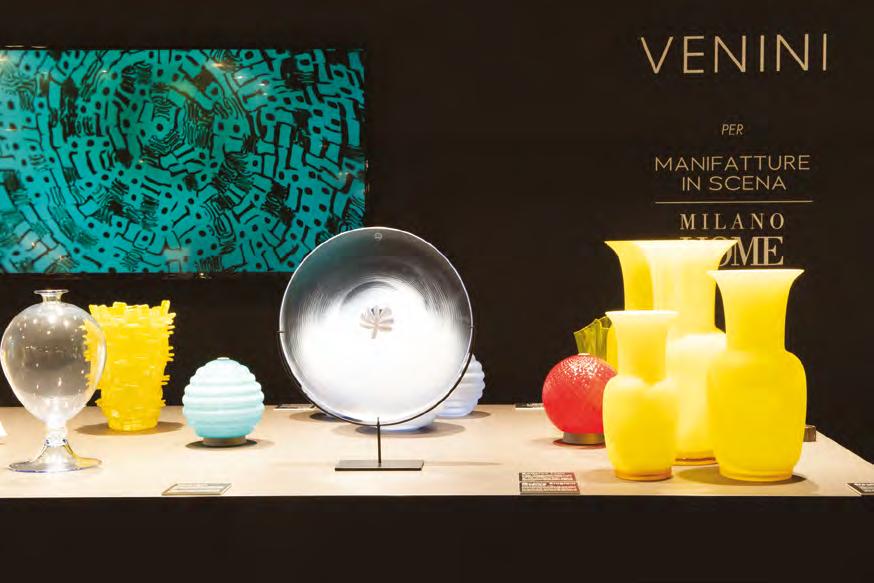
Le Tavole Verdiane at Galleria Manzoni in Milan, Artintavola during Palermo’s tenure as Italian Capital of Culture in 2018 and at Milan Design Week 2019, and Le Tavole della Storia at Fondazione delle Stelline in Milan.
How is the retail store evolving, and what should it offer to today’s buyer?
“The store will increasingly become an experiential meeting point, designed to transmit emotions and stimulate the senses. It will serve as a gallery that offers clients something they cannot nd online: a live experience, through paths created to captivate them.”
The signature of Lepreri’s projects lends retail spaces a strong stylistic identity, blending historical perspectives with innovative ideas for visual merchandising. The result is a harmonious symphony of forms, volumes, lights, colors, materials, and emotions.
Top: Exhibition stage dedicated to the crystal craftsmanship of Moser, featuring both historical and contemporary pieces within a theatre setting at Manifatture in Scena 2024 –Milano HOME.
Left: A chronological display of Murano glassworks by Venini, featured at Manifatture in Scena 2024.
Since its invention in 1710, MEISSEN porcelain has been synonymous with masterful craftsmanship and exclusive aesthetics. Today, MEISSEN creations are among the most sought-after porcelains worldwide. The pursuit of new and innovative creative paths is deeply rooted in the rich heritage of the manufactory. From its own mine, MEISSEN extracts the pu-

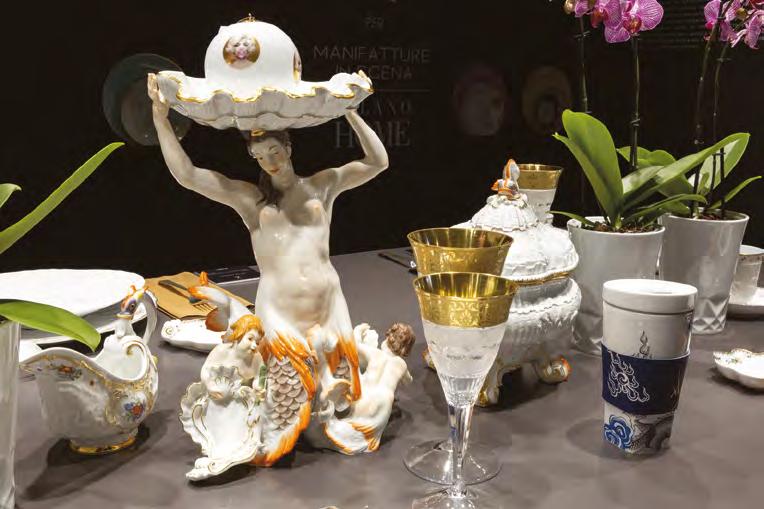
rest kaolin, which is blended with quartz and feldspar to create the raw porcelain paste. Yet it is only through the skilled hands of expert artisans that this material is transformed into extraordinary forms and colors. Every creation originates from the manufactory’s mould archive—the largest and oldest collection of its kind in the world—becoming a contemporary interpretation of European art and culture.
“Mise en place” on the Meissen manufactory stage. Polychrome porcelain pieces and Art de la Table creations, featuring both historical and contemporary decorations, displayed under the spotlight. Iconographic narratives adorn the walls of the theatre at Manifatture in Scena.
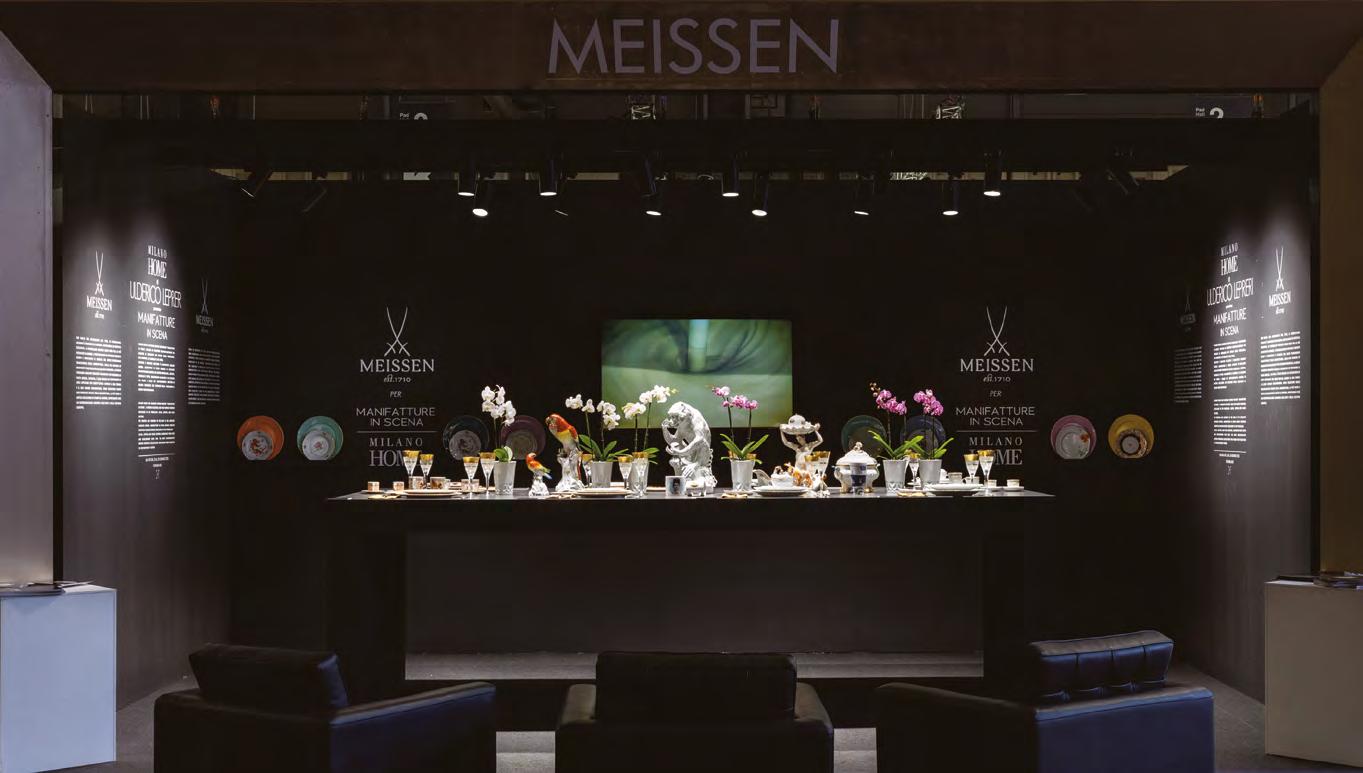

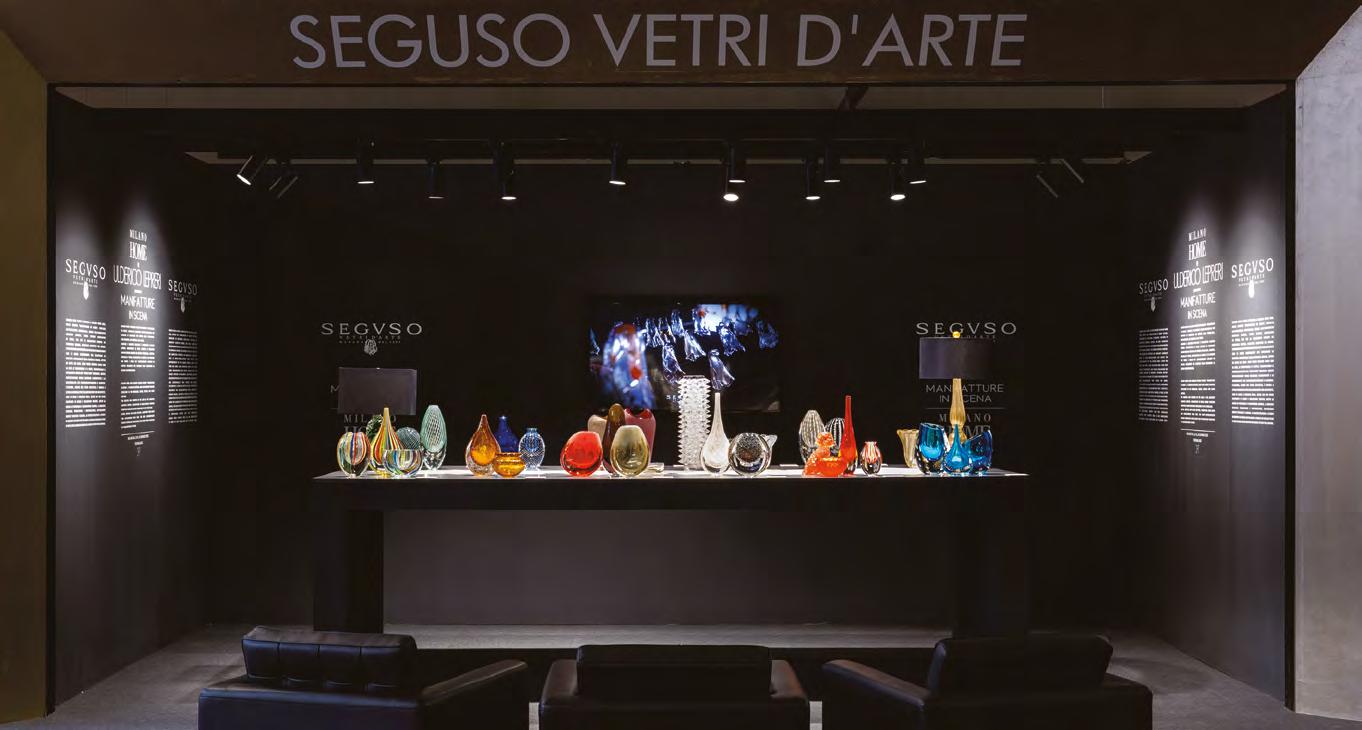
Seguso Vetri d’Arte takes part in Milano Home 2025 within the “Manifatture in Scena” section, dedicated to artisanal excellence. Curated by architect Ulderico Lepreri, the area showcases glass masterpieces, including a collection by Pierpaolo Seguso, the brand’s Artistic Director. The exhibition depicts an imaginary landscape with 12 micro-installations, each re ecting the Seguso family’s craftsmanship, honed over more than 600 years. Every piece interacts with light, transparency, and touch, enhancing the unique heritage of Murano glassmaking.
This participation celebrates the brand’s commitment to authenticity and sustainability. A global
Seguso Vetri d’Arte Theatre
A suspended stage showcasing a play of colors and lights. The collections from the historic Murano glassworks were curated by themes and forms, brought to life through immersive video and sound projections. A complete synesthetic experience of symbols and sensations within Milano Home 2025.
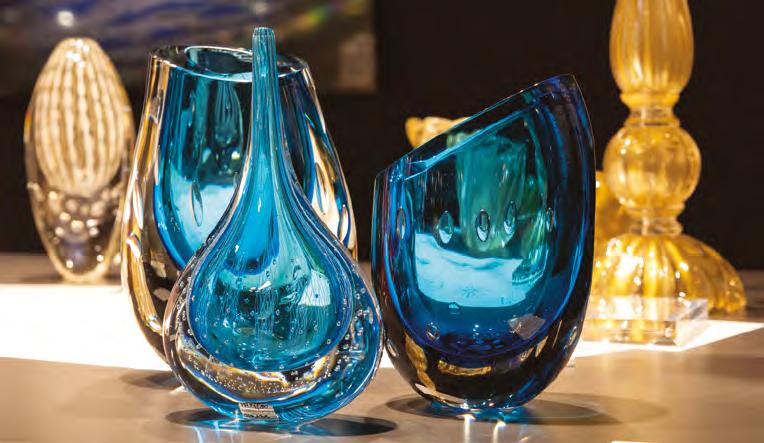
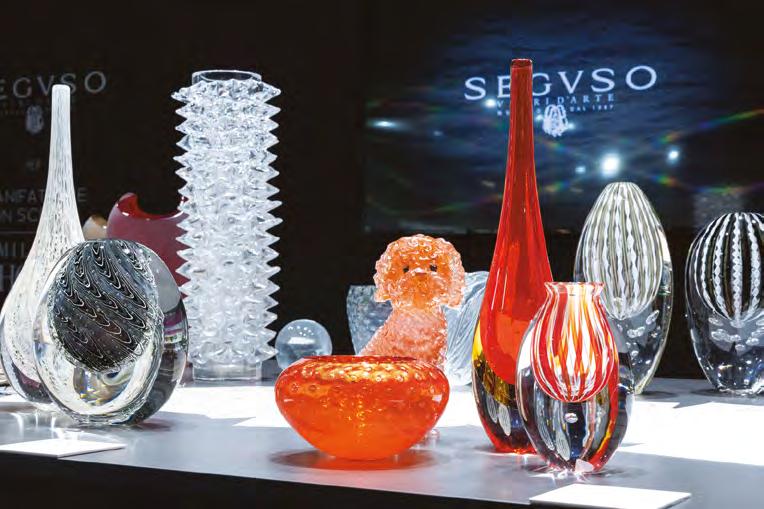
leader in artistic glass, Seguso Vetri d’Arte is renowned for collaborations with architects, fashion houses, and royal families, as well as for works displayed in museums and private collections worldwide. Under the guidance of Pierpaolo and Gianandrea Seguso, the brand seamlessly blends tradition with innovation, constantly exploring new techniques and design languages. Taking part in such prestigious events reaf rms Seguso Vetri d’Arte’s role as an ambassador of Made in Italy excellence on the international stage.
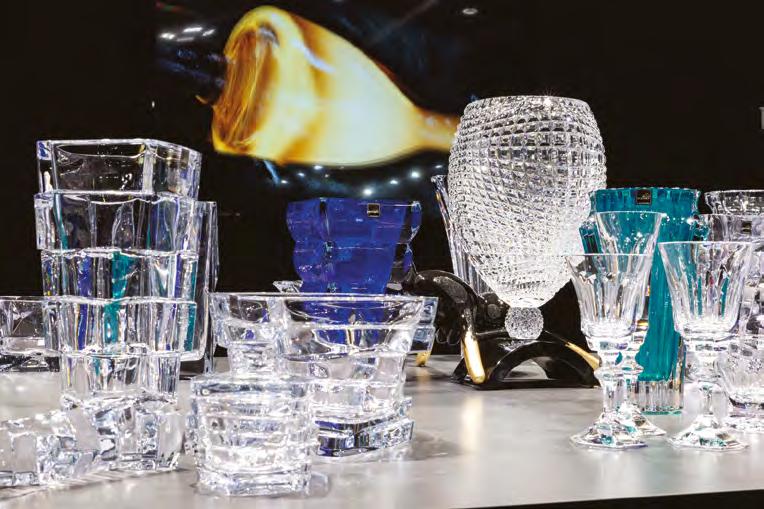
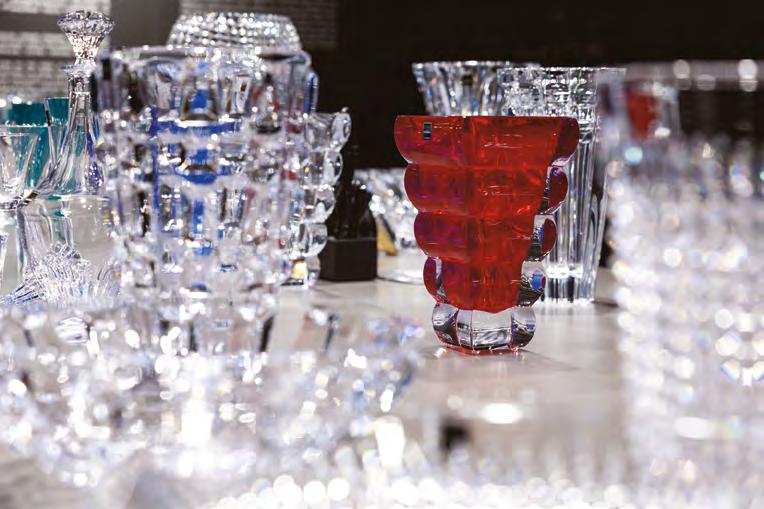
Rogaska-branded products have been crafted for over 350 years at one of Europe’s oldest and most prestigious crystal manufactories, located in the renowned spa town of Rogaska Slatina. Crystal—an exquisite material celebrated for its transparency, play of re ections, and versatility—reaches one of its highest expressions of quality within this manufactory. Here, it is shaped using age-old, intricate techniques that demand not only the artisan’s skill but, above all, the artistry of the Master glassblower.
The tradition of crystal production and craftsmanship is deeply embedded in Rogaska’s history and has long been recognized as an outstanding form of art, carefully preserved and passed down through generations of master artisans.
Theatre dedicated to the Rogaska manufactory: shimmering lights dance on transparent and colored crystals, narrating the story of the finest glassmaking art. On the proscenium, video and sound projections recount the tale of the installation.
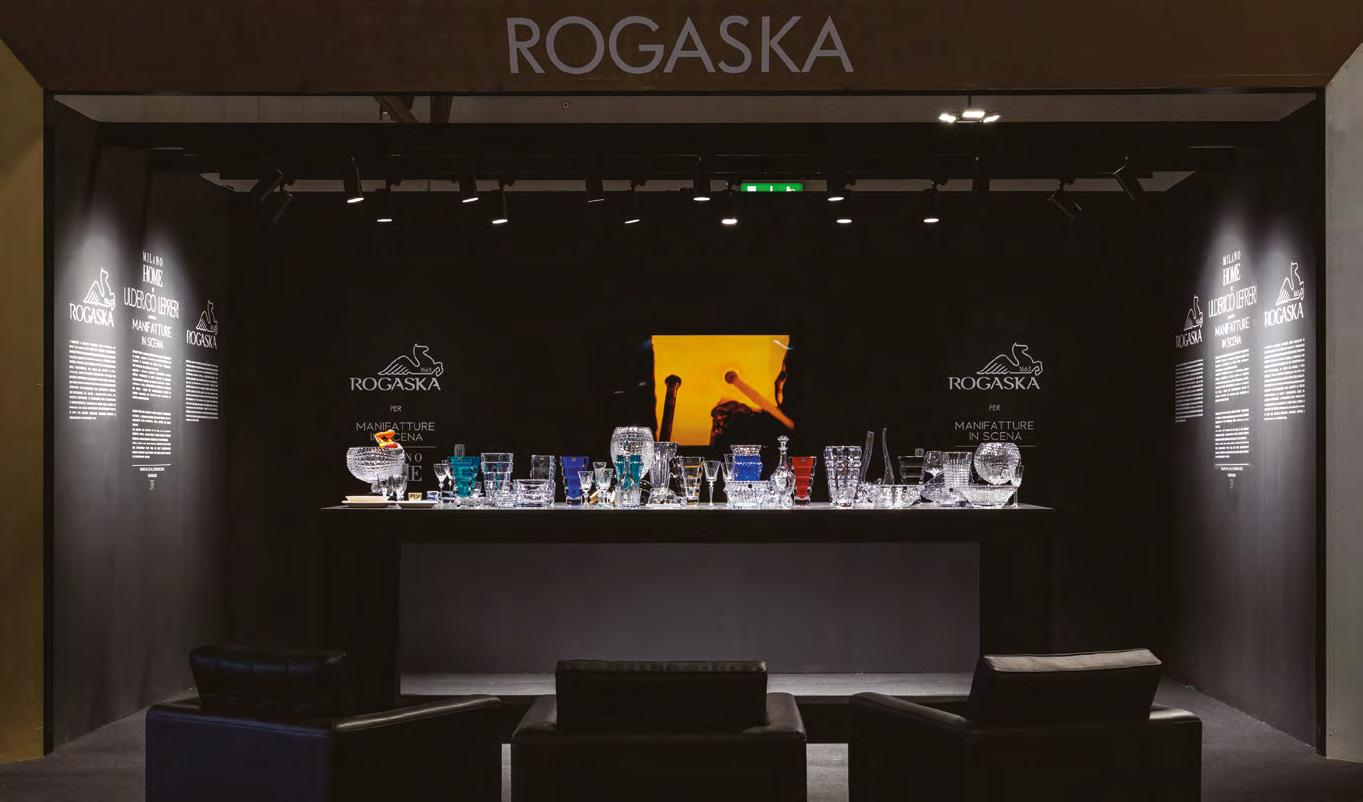
Royal Capodimonte Manufactory, a symbol of the history of Italian porcelain craftsmanship. Soft hues with golden accents stand out against a backdrop skillfully illuminated by the iconographic narratives of the historic Factory.

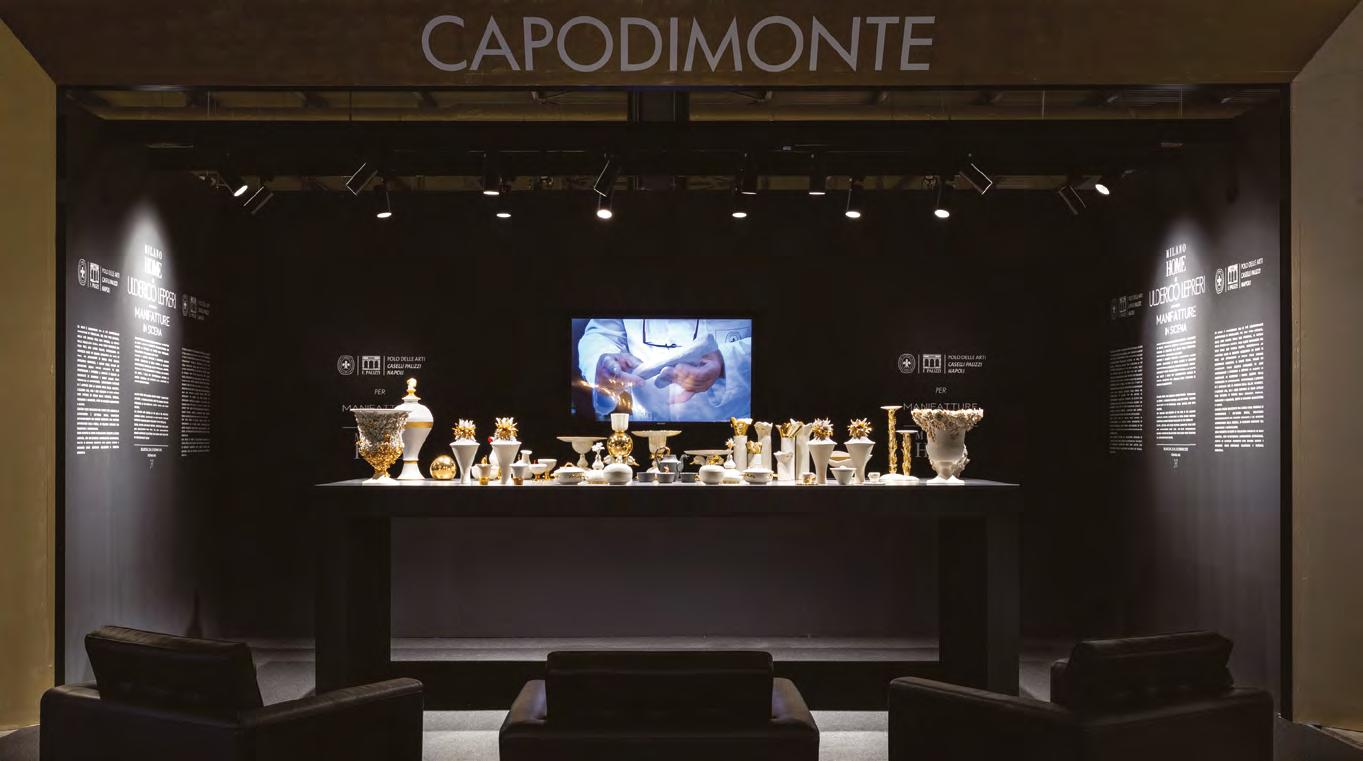
The Royal Porcelain Factory of Capodimonte, founded in Naples in 1743 by King Charles of Bourbon, is widely regarded as one of the most extraordinary porcelain manufactories in history. In 1961, the Caselli Porcelain School was established within the historic premises of the Royal Factory. Today, it forms an integral part of the Caselli Palizzi Arts Hub, of cially recognized as a rare and prestigious institution of Made in Italy craftsmanship. The school proudly bears the original Bourbon coat of arms—the royal eur-de-lis— and plays a vital social role by operating in disadvantaged areas, offering talented young people the opportunity to become the next generation of Capodimonte porcelain masters. Recently, its scope has expanded with the creation of the Ma.De. Academy, a post-diploma higher education program that connects
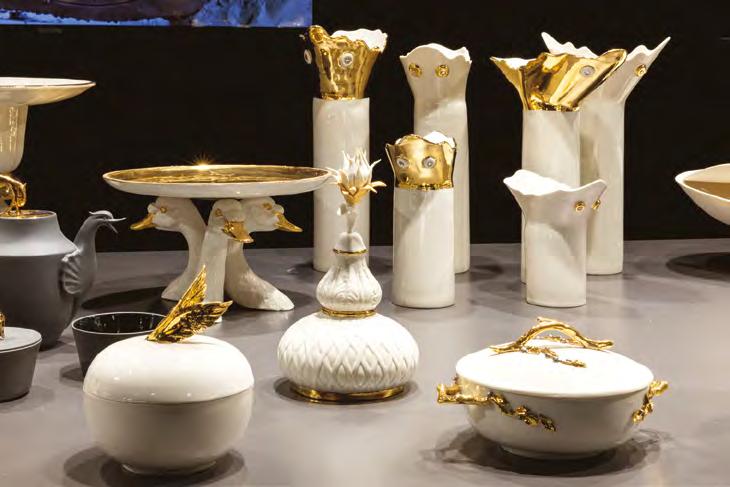
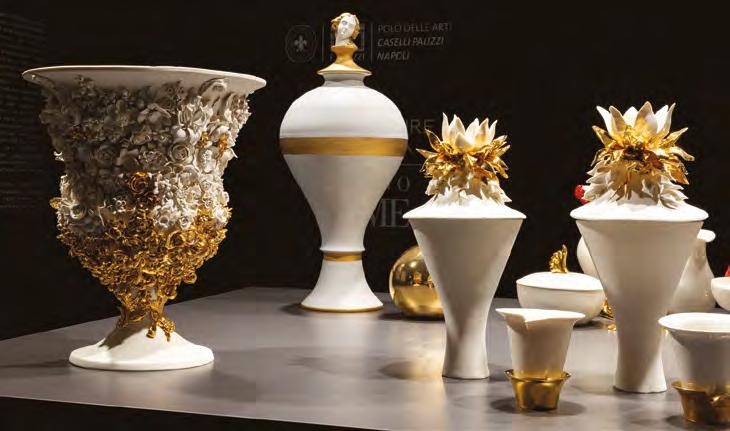
craftsmanship with design through specialized courses in ceramic design, jewelry, landscape, and garden design. Each piece produced by Caselli Real Fabbrica di Capodimonte is a unique work of art, handcrafted by master ceramicists and young Artidesigners from the school, in a constant dialogue between tradition and innovation. Every object belongs to limited-edition collections, meticulously handcrafted and born from collaborations with renowned artists and designers such as Santiago Calatrava and Patricia Urquiola.
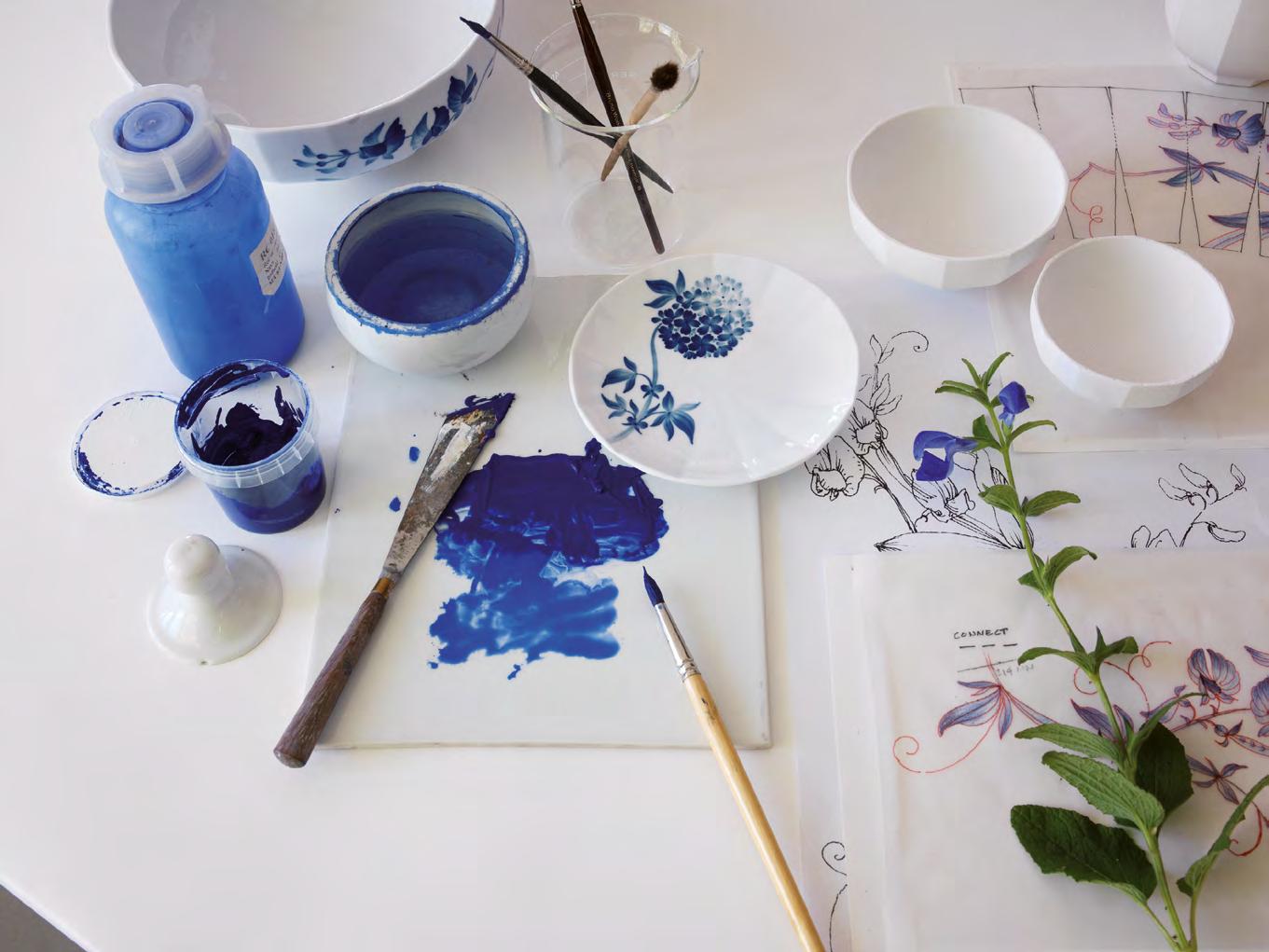
rends come and go, but iconic objects endure. In today’s complex landscape, heritage marketing develops and communicates a series of strategies that, for long-established and prestigious brands, serve to reinforce and perpetuate a strong image of quality, reliability, and expertise
becomes a
by Patrizia Pagani
In the premium segment, a long-standing manufacturing tradition often re ects a unique philosophy and set of values that can serve as reassuring pillars, helping brands navigate the current climate of uncertainty—regardless of the inevitable generational shift within their target audience. In this respect, a heritage strategy aims to strengthen the brand’s market presence by drawing on its most distinctive assets and intangible attributes: longevity, reputation, artisanal excellence, and unmistakable design.
In a mature industry such as homeware, this strong legacy continues to capture the attention of both intermediaries and end consumers. It is a market approach based on tradition, yet capable of constant reinvention. Many companies strive to communicate their identity and brand personality by drawing inspiration from their history and reinterpreting it through a contemporary lens.
This can range from re-launching iconic products in a refreshed version to social media initiatives and consumer campaigns designed to evoke familiarity or nostalgia, thereby strengthening the bond between consumer and brand.
Everything works seamlessly when paired with well-established partnerships with selected retailers. A quali ed and knowledgeable retailer plays a crucial role—especially when dealing with high-end collections—by being able to narrate the brand’s story through curated displays and evocative iconographic materials that enhance the craftsmanship behind each masterpiece.
Barazzoni: a legacy projected into the future A manufacturing company like Barazzoni Spa—with over a century of history, fully Italian production, and family ownership still in place—naturally conveys values of solidity and trust.
“We have long held the status of ‘Historic Enterprise of Italy,’ and some years ago we also applied for and were granted the designation of ‘Historic Trademark,’ as con rmed by the logos now included in most of our institutional communication materials,” explains Silvina Felici,
the company’s Marketing Manager.
“In today’s economically challenging climate, consumers pay close attention to the origin of the products they purchase and take pride in choosing the best of Italian craftsmanship, which guarantees reliability and durability. Another key factor is the company’s long-standing expertise: the connection to our past and heritage offers something unique, distinctive, and inimitable—an emotional anchor that brings security and a sense of belonging. Sadly, longevity has become an increasingly rare asset in our sector.”
Another de ning feature of Barazzoni is its long-standing focus on design. For instance, the Tummy pot—launched in 1969 and awarded the Compasso d’Oro in 1979—remains the company’s best-selling stainless steel product.
Emphasizing the values that shape the company’s history and brand helps convey a sense of continuity between the past, present, and future.
“The link between tradition and innovation, preservation and evolution, is a hallmark of our brand. We’ve remained in step with the times, responding to contemporary market needs while staying true to our core identity. We have always sought to consistently communicate the values on which our brand identity is founded, recalling the origins and experience that have shaped our company over the years.”

This is re ected in Barazzoni’s use of its founding year (1903) in the logo, in dedicated sections on the company’s website and packaging that tell its story and highlight its strengths, and in the catalog featuring photographs of the four generations of entrepreneurs and historical production sites. “A brand’s heritage cannot be fabricated—it either exists or it doesn’t—and it remains a key differentiator from competitors.”
The Tummy pot, winner of the Compasso d’Oro in 1979, is a signature creation by Barazzoni
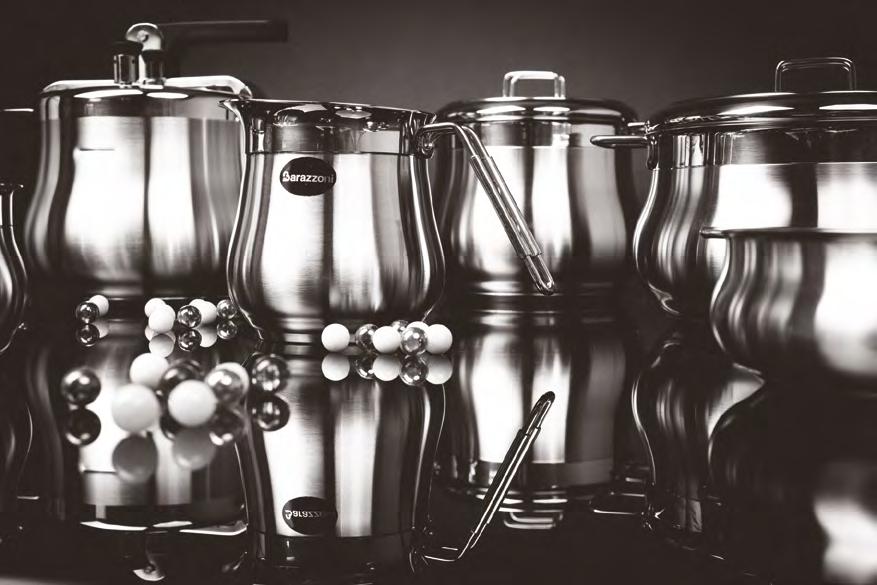
Sambonet: brand values as drivers of success
For Sambonet, heritage is a powerful tool to stand out from competitors and af rm the brand’s credibility and authority.
“Today’s consumers are well-informed and discerning. They seek not only products but also a meaningful connection with the brand and the aspirational world it represents,” explains Valentina Guatelli, Marketing Manager of Sambonet Paderno Industrie Spa, a leading company in high-quality tableware and kitchenware for both home and Ho.Re.Ca. sectors. “This is why brand history and values can be highly effective and differentiating drivers.”
While Sambonet’s heritage and artisanal expertise remain fundamental, addressing modern consumers also means framing these values in line with current priorities. “For us, sustainability is key to demonstrating both innovation and reliability. It is a forward-looking approach, but one that is rmly rooted in recent history. This is why we not only communicate our commitment—publishing a sustainability report for 12 consecutive years—but also embed it into our corporate DNA.”
Alongside sustainability, Sambonet emphasizes quality, tradition, and Italian ingenuity. “In a world where everything seems eeting, what sets us apart is our sense of history and continui-

ty, our ability to adapt without compromising on quality—offering lasting reassurance to those who choose us.”
In-store communication further strengthens these brand values and the company’s institutional image. Sambonet has long supported its collections with explanatory materials and offers retailers streamlined solutions to enhance product displays. “We also prioritize retailer training and relationship-building, as retailers are essential brand ambassadors. Building loyalty and attachment to the brand is the rst step toward gaining consumer trust, especially in a fragmented and traditional channel like ours.”
Lamart: heritage strategy for leading brands
A strong example of heritage strategy can be found at Lamart Srl, an Italian design company distributing prestigious brands such as Riedel and Royal Copenhagen, while also marketing its own label, Palais Royal Torino, known for its artisanal approach, attention to detail, and timeless elegance.
“With Riedel, a company with over 265 years of experience in crystal glassware and decanters, we are dealing with a legacy that is both a distinctive hallmark and a powerful marketing asset,” says Maurizio Cassardo, Co-Owner of Lamart. “In an era where consumers seek authenticity and quality, Riedel’s tradition becomes a guarantee of expertise, know-how, and reliability.”
Riedel’s past is intrinsically linked to its drive for innovation: “Telling this story offers a unique experience where heritage and modernity come together to enhance the sensory qualities of any wine or spirit.” Excellence, functionality, and design are Riedel’s core values: every product is scienti cally designed to elevate the organoleptic properties of beverages, blending aesthetics with performance. Craftsmanship and sustainability also play a central role: many Riedel pieces are still handmade using time-honored techniques, with a strong focus on reducing
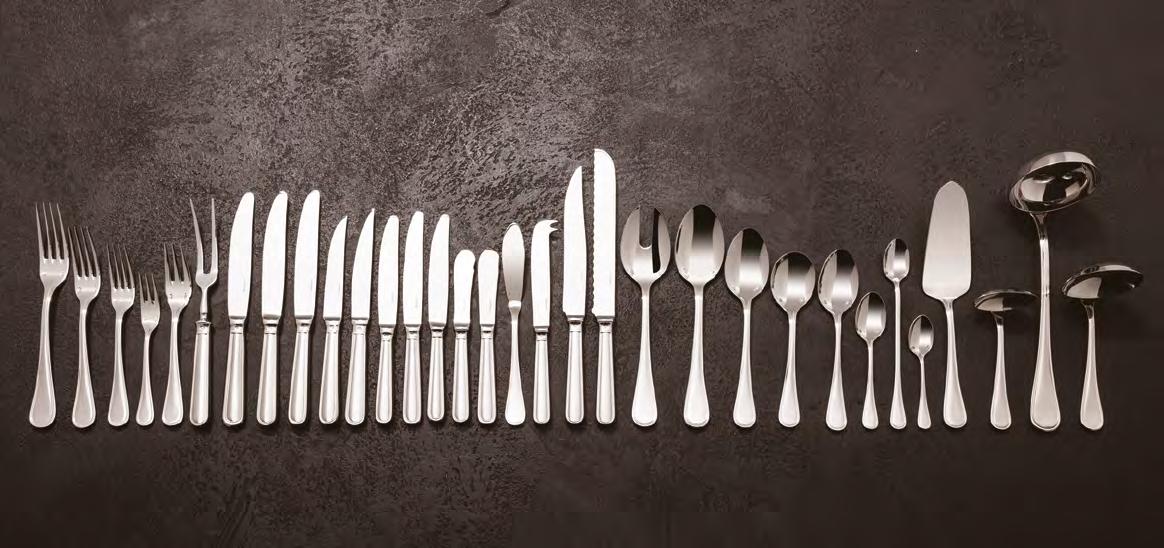
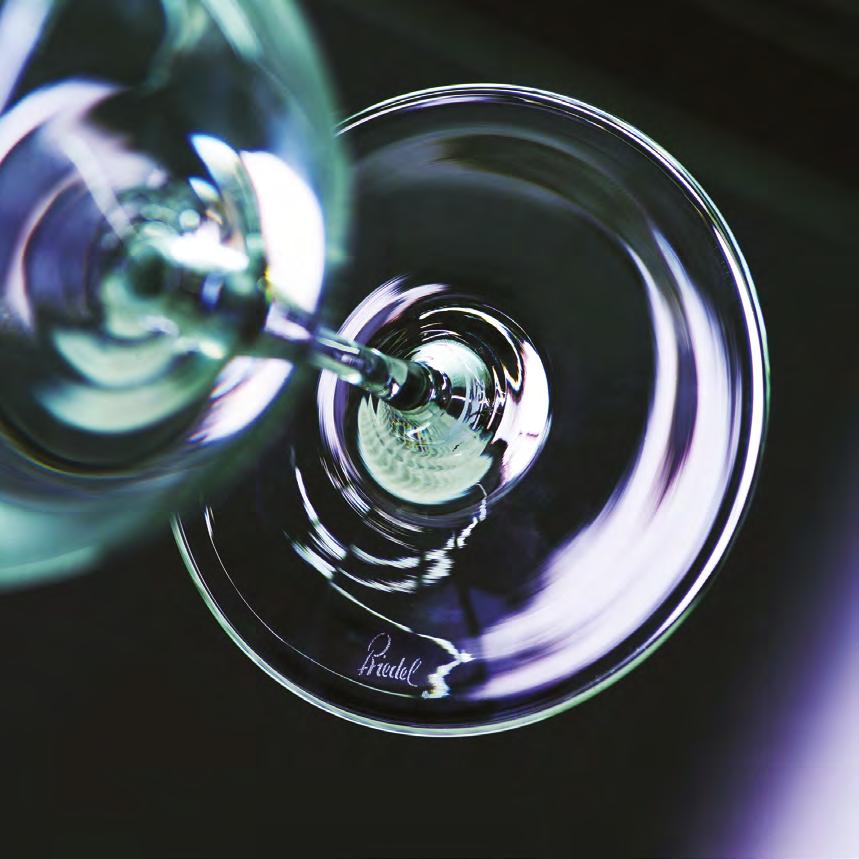
environmental impact.
Royal Copenhagen shares a similar philosophy. Since 1775, it has been renowned worldwide for its handcrafted Danish porcelain. “Its historical legacy is not only an asset to protect but a constant source of inspiration and renewal. In today’s market, where authenticity and storytelling are increasingly valued, the brand’s herita-

ge is a compelling narrative: each collection reects centuries of craftsmanship, culture, and design.
Royal Copenhagen’s DNA also embodies the concepts of slow living and hygge, the Danish idea of comfort and coziness, where objects are designed to last and be passed down through generations. To effectively communicate these values to retailers, Lamart leverages specialized training, experiential materials, and visual storytelling. “For Riedel, we focus on elegant displays and clear narratives, supported by materials that explain the brand’s history and technical expertise, and we organize tasting sessions where participants experience rsthand how glass shape affects wine aroma and avor.”
“For Royal Copenhagen, we curate thematic displays that highlight the brand’s iconic designs and purity of form, accompanied by storytelling that brings each collection to life, inspiring and engaging the end consumer.”
Social media also plays a crucial role: “Through platforms such as Instagram, Pinterest, and Facebook, we showcase the brand’s values with evocative imagery, behind-the-scenes videos of the craftsmanship, and editorial content exploring each line’s unique features.”
Mirabello Carrara: a legacy of strong values In today’s global and digital landscape, heritage is a key asset that allows brands to remain recognizable within an increasingly competitive marketplace.
“Younger companies can certainly carve out space through sharp communication and wellplanned marketing,” says Claudia Galimberti, Digital Marketing Specialist at Mirabello Carrara Spa, a leader in premium Italian home linens, with roots dating back to the mid-20th century. “However, having a historical legacy helps brands preserve authenticity and consumer trust. In today’s world, where credibility and transparency are paramount, heritage is a crucial advantage.”
The brand’s positioning focuses on clarity and reliability: “Whether it’s products or services, acting transparently and communicating sincerely are essential to earning customer appreciation and loyalty.”
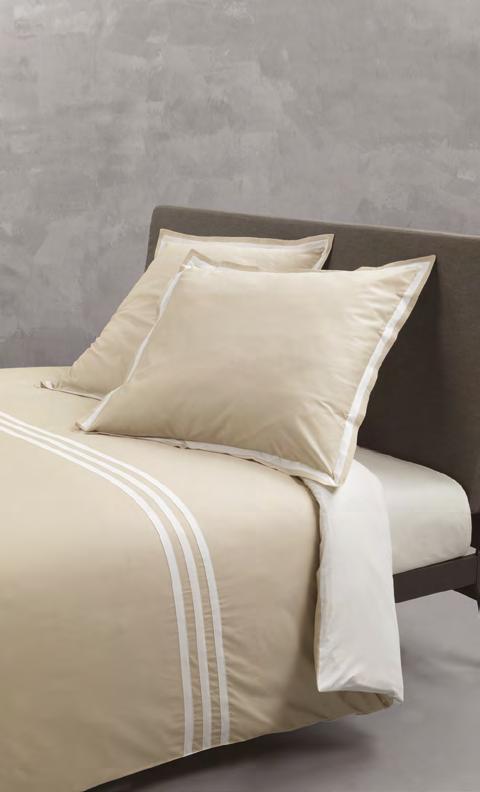
Mirabello Carrara’s collections combine timeless craftsmanship with a contemporary touch, paying tribute to the brand’s heritage, which originated in Milan’s historic and artistically vibrant district. “To achieve our communication goals, we rely on a strategic synergy between digital tools—such as newsletters, websites, and social media—and physical materials like catalogs, in-store displays, and window signage, all designed to capture the attention of our target customers.”
“Storytelling and the creation of POP materials must re ect our brand values and tone of voice perfectly. In this sense, well-trained personnel are an invaluable asset, as are sales associates who play a decisive role in conveying information and inspiring trust through engaging and effective communication.”
Lanerossi: authentic tradition, constantly renewed
In a globalized and digitized market, heritage becomes a crucial element in strengthening brand identity and creating emotional connections with consumers.
“Today, people don’t just buy a product—they buy the values and story behind it,” says Marta Marin, Marketing Manager at Lanerossi (Marzotto Lab Srl). “Founded in 1817, Lanerossi boasts a unique legacy, representing a wealth of marketing value, deeply rooted in authenticity: quality, reliability, know-how, innovation, craftsmanship, and design, to name a few.”
“Our story is credible because it is real—backed by two centuries of excellence and passion. This enables us to engage consumers transparently and authentically, building strong and lasting emotional ties.”
Lanerossi masterfully balances tradition and innovation: with two centuries of experience in textiles and wool, the brand offers superior products thanks to its artisanal and technological expertise, managing the entire production chain to ensure quality and sustainability. “Innovation and research are at the heart of our DNA, constantly enhancing comfort and product durability, while our deep-rooted connection to design gives our creations elegance and character.”
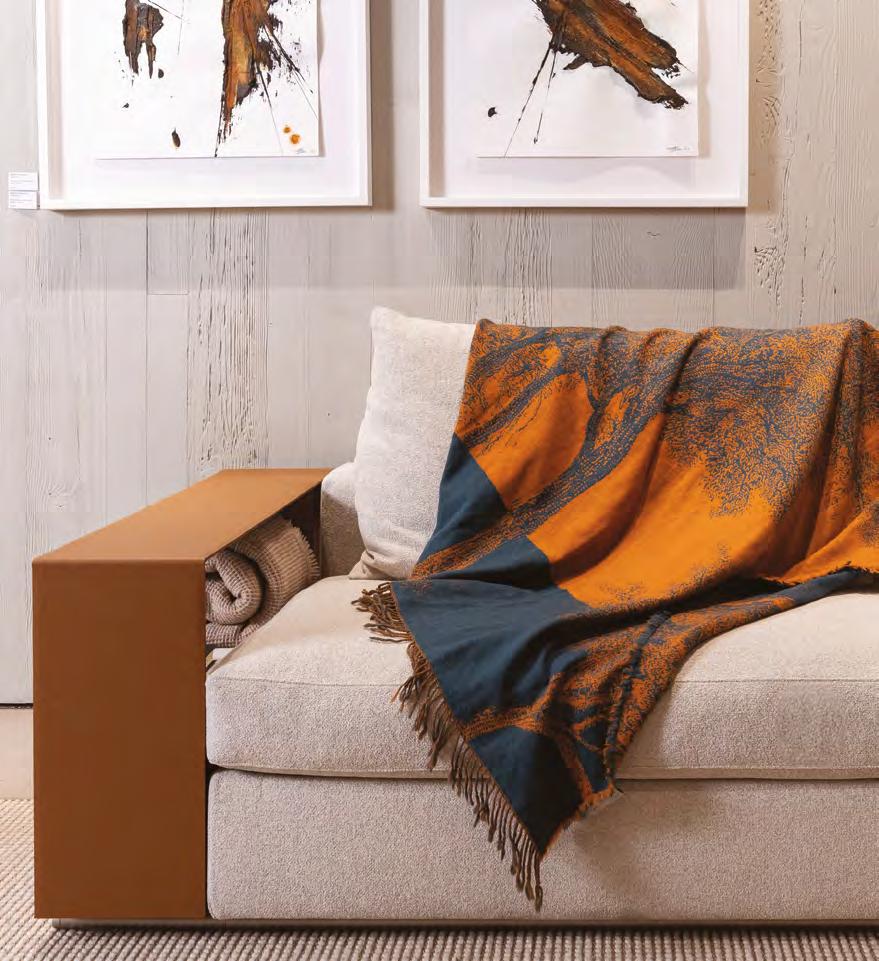
Lanerossi’s mission goes beyond furnishing homes with style: “Our products are symbols of protection and well-being, evoking the warmth of home as a safe haven. The domestic space is not just a physical place but a sanctuary where we can be ourselves and live according to our emotions.”
This strategic positioning is strongly supported by retailer engagement: “We aim to transform our retailers into true brand ambassadors, offering them experiential activities—such as visits to our company or agship store—to deepen their knowledge of Lanerossi’s history and product excellence.”
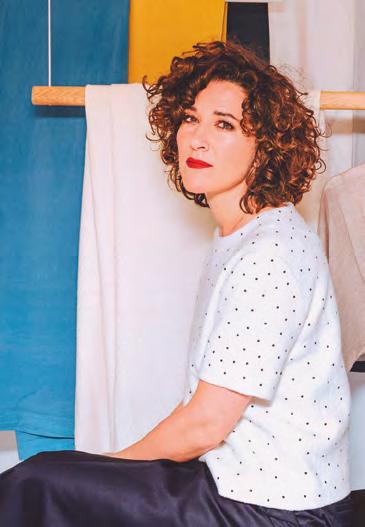

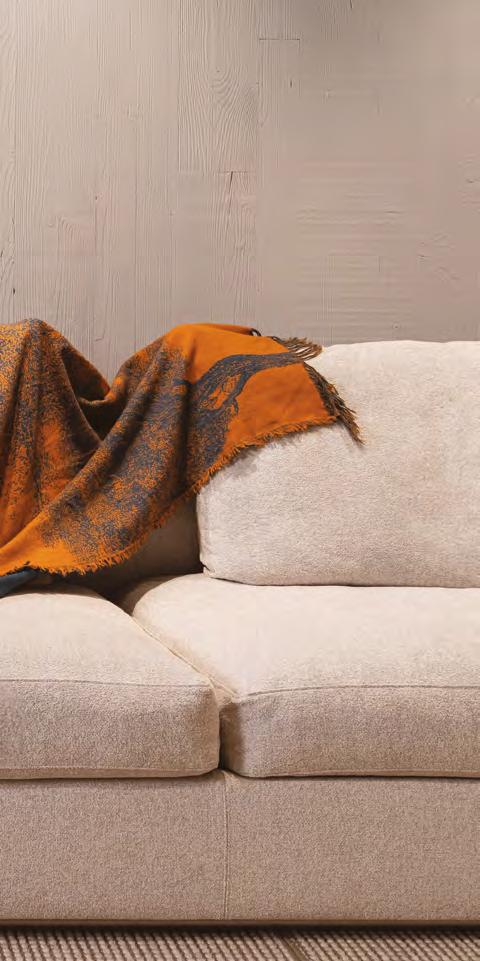
“We also organize in-store events to engage end customers and convey the essence of the brand through sensory and narrative experiences. In our stores, we invite customers to become part of our world, with displays of raw materials, emotional videos, interactive installations like video mapping, and dynamic setups to create immersive experiences.”
Heritage as a means to convey emotion, tradition, and quality. “Through a strong historical identity, we communicate values of craftsmanship, exclusivity, and innovation, meeting the growing consumer demand for authenticity,” says Silvia Damiani, President of Venini Spa and Vice President of the Damiani Group. “By telling the story of our roots and the guiding principles behind our business, we foster a deeper connection with our audience, enhancing the perceived value of the brand and turning our heritage into a bridge between past and future.”
With over a century of expertise in glassmaking, Venini stands out for its ability to preserve a strong link to its historical roots while remaining highly attuned to market trends. Its guiding principles are twofold: a commitment to artisanal excellence and the ability to continually innovate. Innovation— where tradition meets research—has enabled the brand to remain relevant over time.
“To effectively communicate these assets to retailers, we believe an integrated approach is essential, combining a range of tools. Our qualified team can passionately share the story and value of our craftsmanship, while in-store displays and window setups create the perfect balance between the brand’s tradition and modernity. This is complemented by refined, elegant packaging that underscores the products’ excellence and further elevates their prestige.”
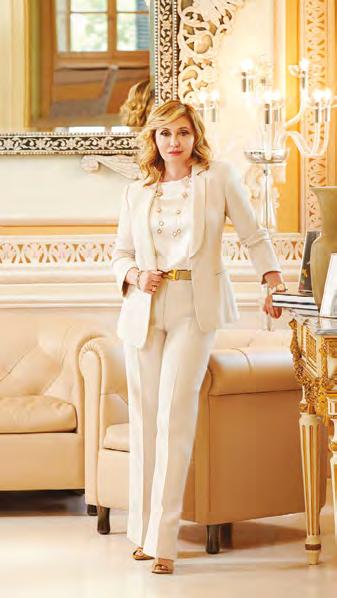
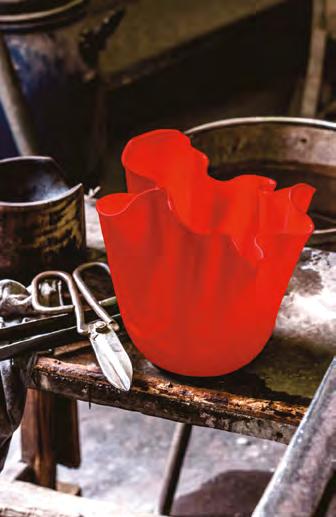
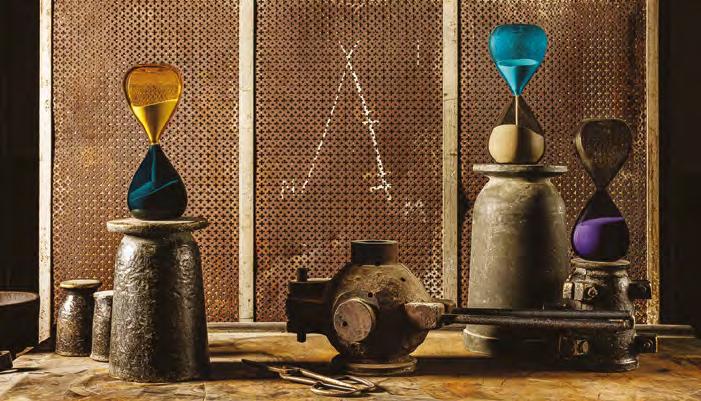
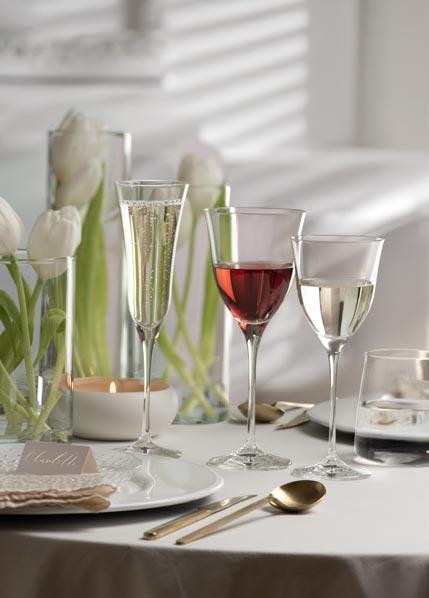
Rby Giulia Arrigoni
enowned globally for its production of glassware and tableware for dining, mixology, and wine tasting, RCR Cristalleria Italiana SpA stands as a shining example of the nest Made in Italy. The company manages the entire production cycle, from design to nished product, in the heart of Tuscany, within a CO2 Neutral area certi ed by Siena Carbon Free. With 300 employees and an additional 200 in its supply chain, RCR produces 38 million pieces annually, exported to 110 countries worldwide, generating €50 million in revenue, 80% of which comes from international markets.
Following the Ambiente trade fair, RCR’s CEO Roberto Pierucci sat down with Casastile.
What are your overall impressions from Ambiente, and what major trends have you observed in the industry?
Ambiente once again con rmed itself as a key event for the market, although many exhibitors, myself included, felt that the ve-day duration might be too long. That said, the sentiment at the fair re ected a European market currently in a holding pattern, though showing slight improvement compared to 2023. While 2024 had a slow start, even a downturn, we’ve seen a modest rebound since August. However, uncertainty persists, driven by various geopolitical factors impacting the global economy. Nonetheless, there is a growing awareness that 2025 will be a year of stabilization, allowing companies to plan their strategies more clearly.
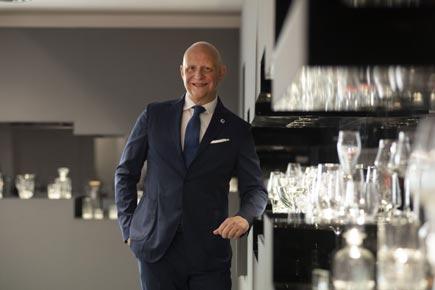
How did RCR experience the event?
We are very pleased. Our booth, featuring a large hot air balloon rising from a mixology-themed counter, drew considerable attention and curiosity. We wanted to convey a message of lightness and innovation. Lightness, in today’s complex economic and social climate, has symbolic value for us: shedding the weight of uncertainty to face the future with optimism. We also launched our “RCR Around the World” project, through which we will present our products in 80 countries, strengthening ties with international partners.
Is the shift in consumer habits in uencing the glassware sector as well?
Yes, and signi cantly. Twenty years ago, purchasing glasses and stemware was mostly tied to wedding registries and specialty stores. Over time, consumers have leaned more toward practicality and functionality. This led us to develop more versatile product lines, tailored to speci c uses: mixology, wine tasting, table setting, and home décor. Moreover, glass has become increasingly popular with younger generations, thanks to its sustainability and the sense of transparency and safety it conveys.
Has the cocktail and mixology trend impacted your market?
Absolutely. The growing cocktail culture, both in bars and at home, has elevated the role of glassware as a de ning element of the experience. This has fueled demand for dedicated mixo-
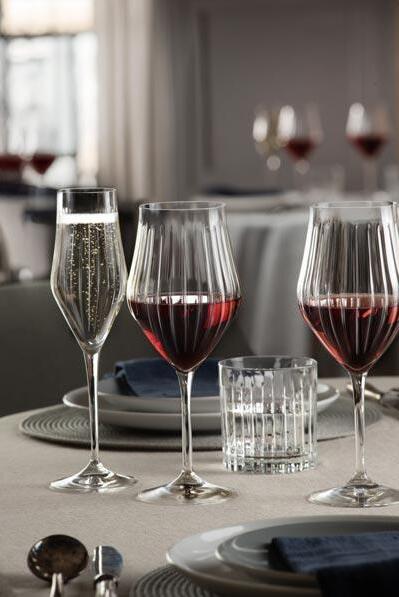
logy products. We are also closely following the rise of “mocktails,” alcohol-free cocktails gaining popularity among a broadening audience. It’s a trend that promotes inclusiveness and sociability, allowing everyone to enjoy the mixology experience, regardless of personal or cultural choices.
What’s your view on how distribution is evolving?
Distribution is the sector undergoing the most profound changes, not only in Italy but across Europe and the U.S. The streamlining of specialty stores, alongside the decline of department stores, has signi cantly altered purchasing behavior. Today, consumers are less likely to plan for a full set of glassware and more inclined to buy pieces within broader shopping contexts. At the same time, mid to low-tier stores are evolving, improving their product offerings and overall quality. At RCR, we are adapting to these shifts by maintaining high-quality standards and carefully selecting our distribution channels, while limiting our presence in mass retail to loyalty campaigns only.
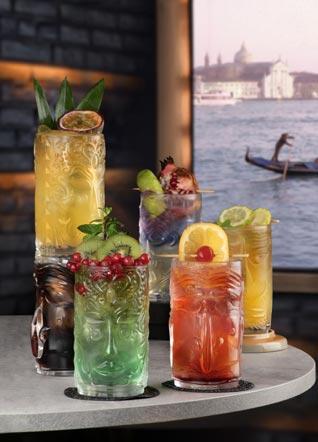
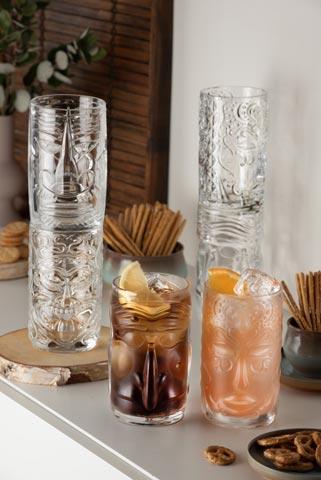
What projects and innovations does RCR have in store for 2025?
We will continue to innovate in response to market needs, focusing on two key areas: sustainability and space optimization. We are developing stackable collections to reduce clutter in increasingly smaller living spaces and expanding our mixology product lines. We are also committed to replacing less sustainable materials with glass, as we’ve done with the Tiki collection, inspired by regional Italian masks from Sardinia, Tuscany, and Campania, originally made of ceramic but now produced in glass. After the success of two lines launched last year, we’ve introduced two additional ones. Furthermore, we have reimagined traditional mixology tools: we replaced the classic stainless steel jigger with our glass Tattoo model and introduced a glass version of the copper Moscow Mule mug—glass being an in nitely recyclable material in line with the values of new generations. For us, innovation is a balance of tradition and modernity: preserving the elegance and quality of glass while making it more accessible and suited to evolving consumer needs.
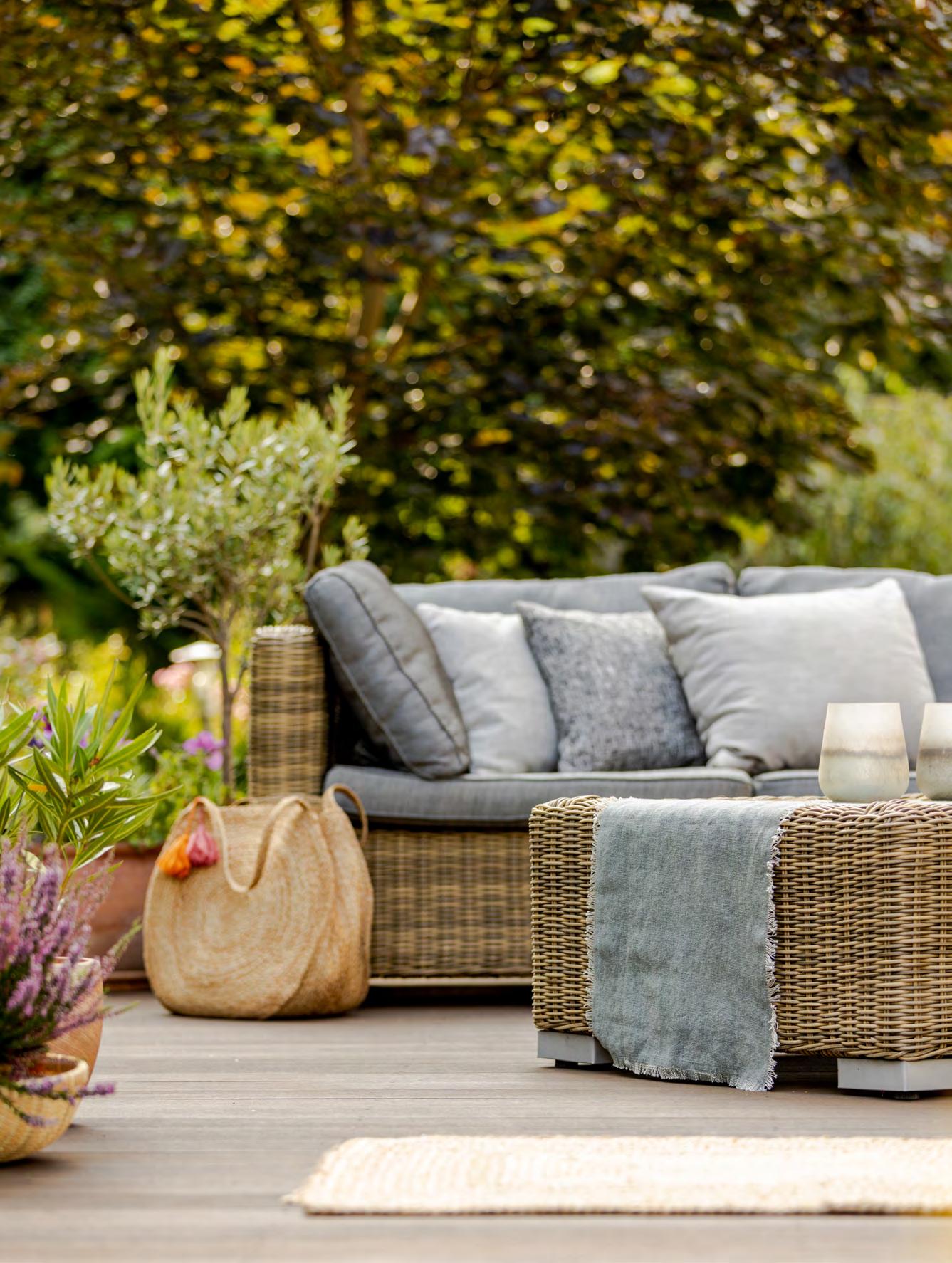
- L’arredo e il designComfort and design without borders: new textiles and furnishings for every space
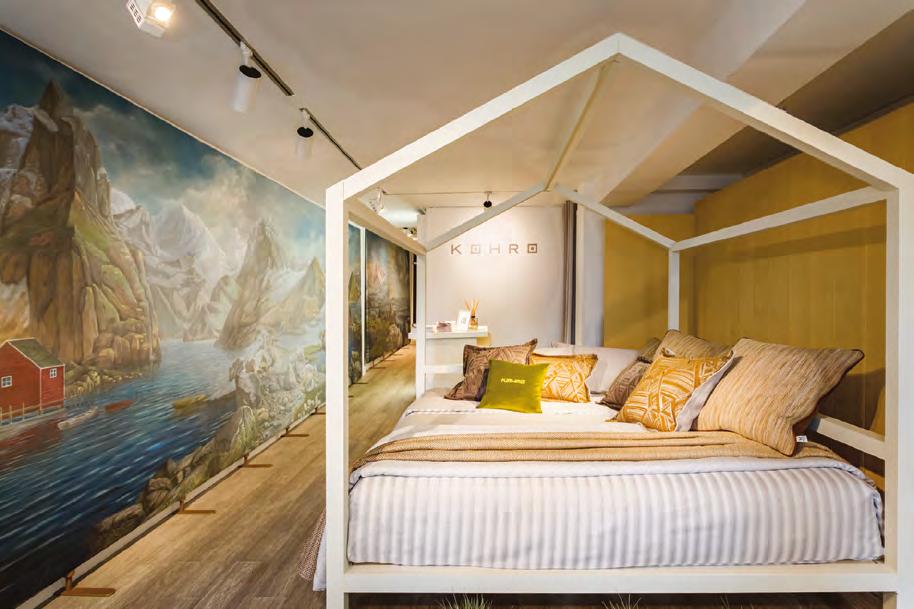
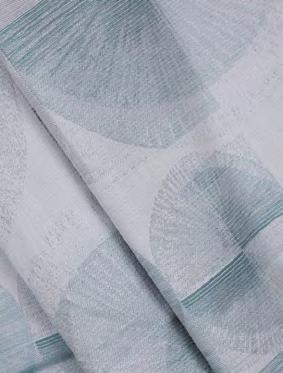
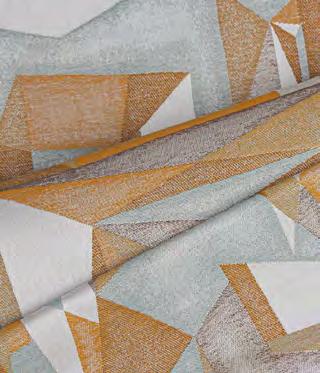
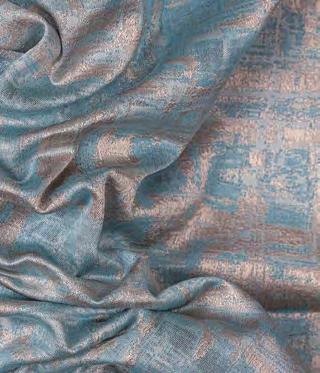
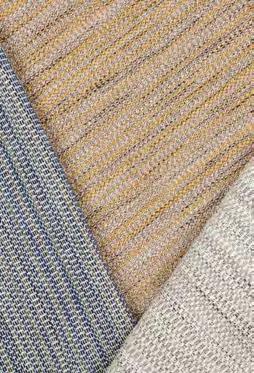
Cold, silent, arctic. Inspired by the extreme North, KOHRO’s new home textile collection, ARTARCTIC, evokes a sense of wonder drawn from the marvels of the frozen wilderness. These new fabrics are narrative compositions where nature and art converge, capturing both the micro and macro wonders of the natural world. The vast and enchanting landscapes of the Far North inspire this collection: the intricate arabesques of ice, snow dust, polar ice oes, icebergs, and tundra. In nite skies and waters dance with wind and light, shaping a fa-
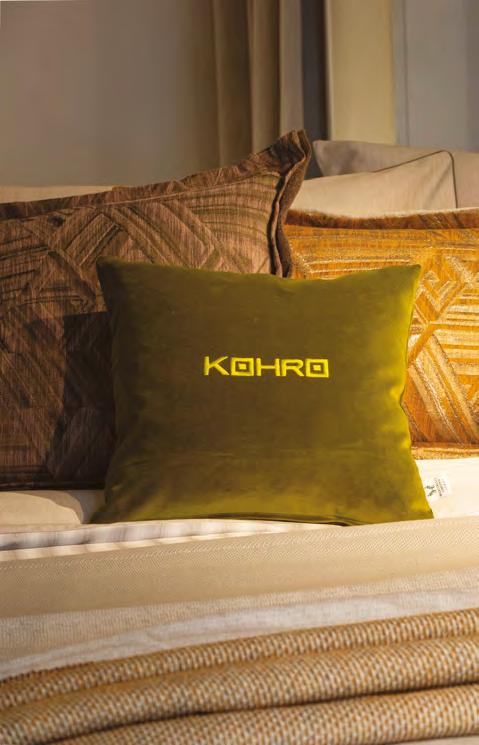
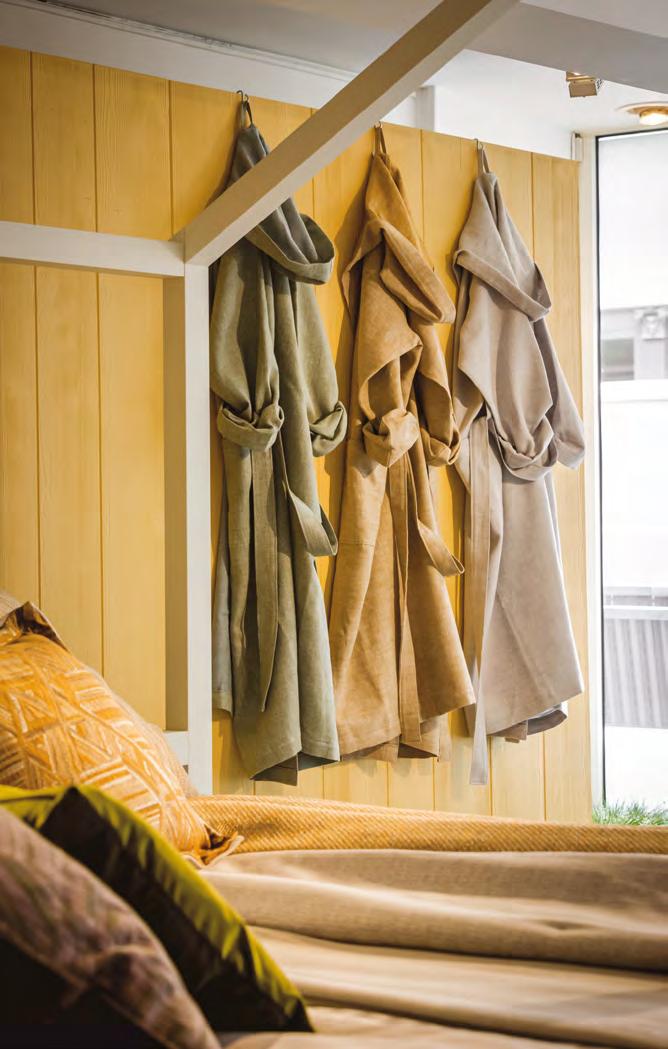
Discover KOHRO at the Fuorisalone in Milan
APRIL 7-13
PIAZZA SAN MARCO 3 – BRERA DISTRICT

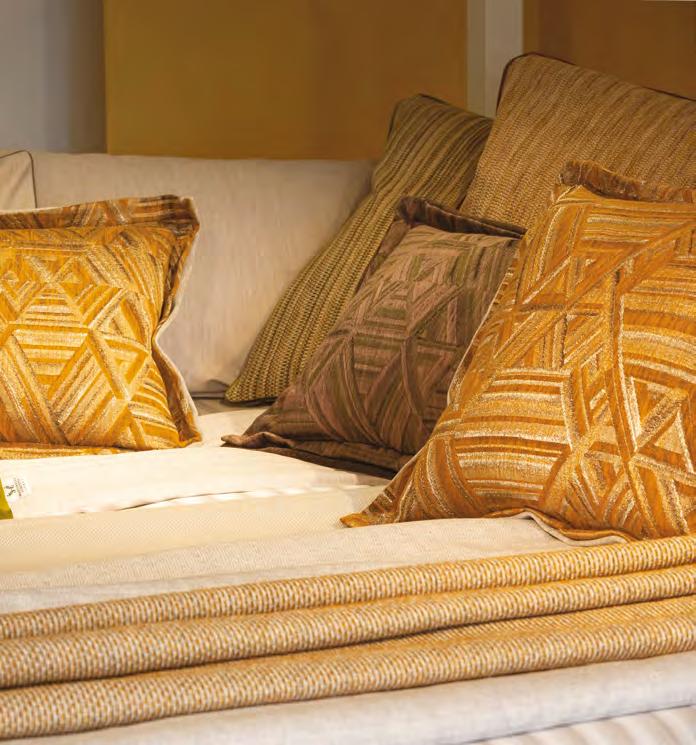
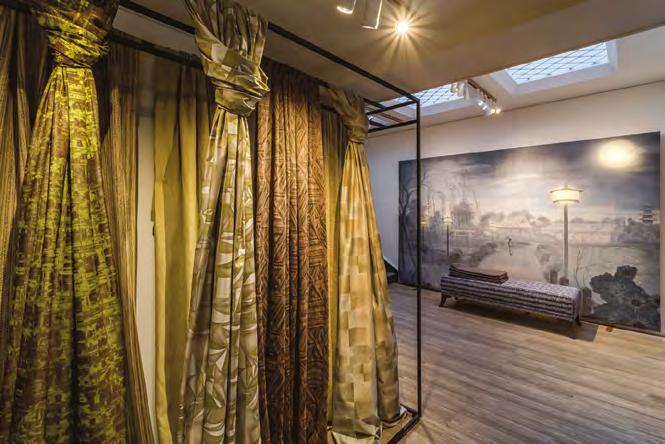
scinating, primordial, and unique nature. Forms that become patterns of striking visual re nement – true works of abstract art.
Exquisite designs and ultra- ne fabrics crafted from precious naturalbers such as linen, silk, and cotton, presented in a rich palette. The hues of Arctic seas and lands ow into this new collection: the crystalline blues of icy waters; the whites, greys, blues, and soft neutral tones of tundra lichens and peat bogs; and the charming yellows, oranges, and reds of shermen’s houses nestled among fjords and inlets.
KOHRO inspires architects, decorators, and interior designers on prestigious furnishing projects worldwide, across residential, hospitality, and yachting sectors. The brand offers an extensive range of ne fabrics –plains, prints, and jacquards – all available in double width and a full array of weights, textures, bers, and designs, ideal for coordinating every area of interior decoration: upholstery, drapery, wallcoverings, bedding, and bespoke linens. www.kohro.it
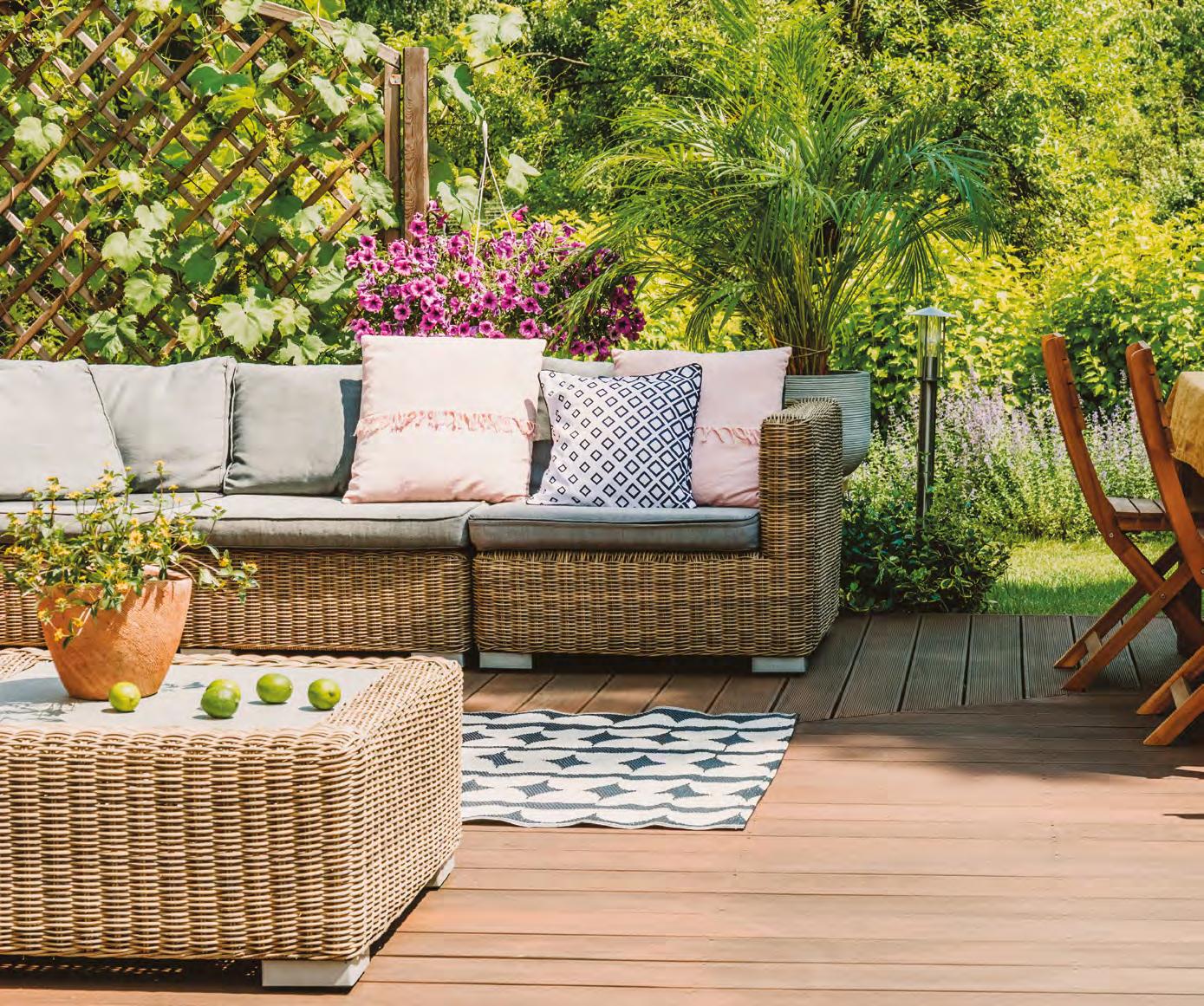
by Fabio Destefani

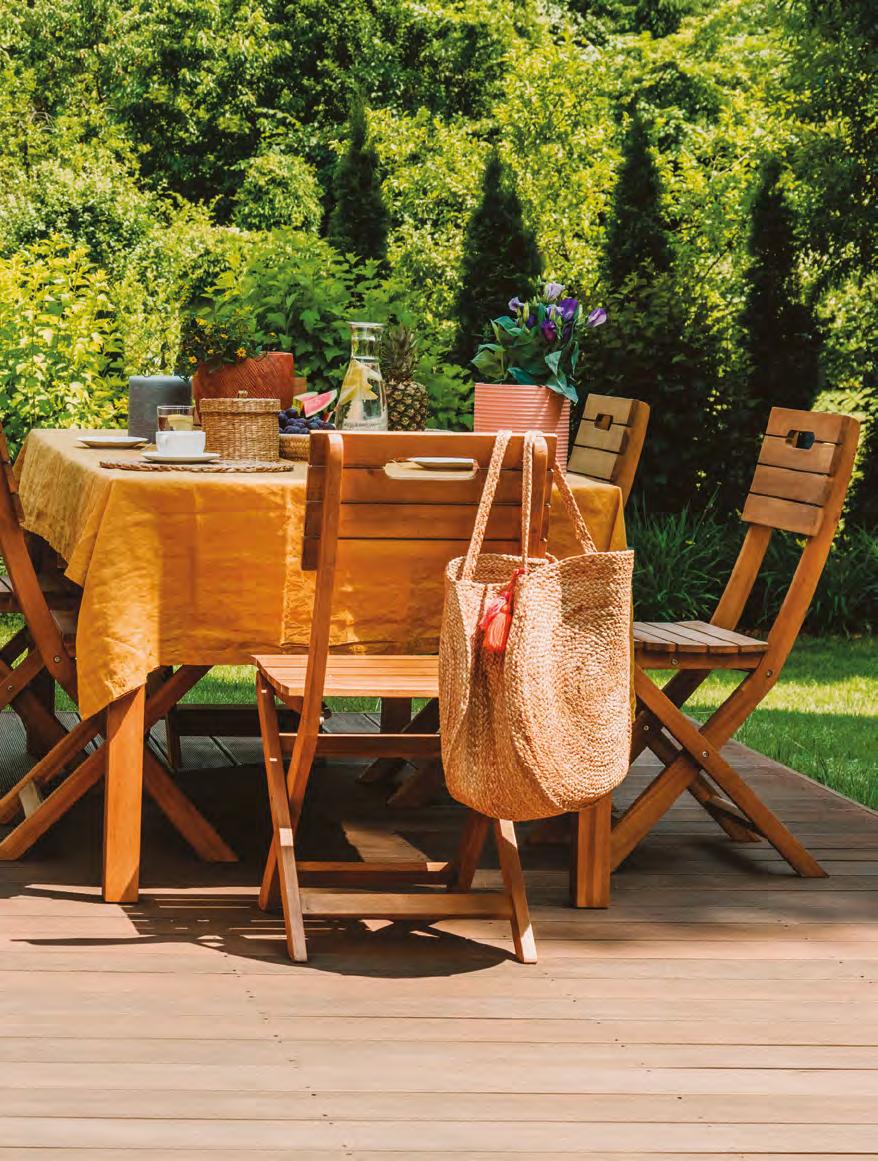
From curtains to wallcoverings, to weather-resistant cushions and furnishings
Curtains, sheers, seating, cushions, trimmings, and wallcoverings help de ne spaces and create atmospheres that meet both practical and aesthetic needs. This is true for both indoor and outdoor settings, with the latter experiencing strong growth. Following the pandemic, which kept us con ned indoors for months, people now feel a strong urge to reconnect with nature and spend more time outside—whether in a garden, on a terrace, a veranda, or even a small balcony.
To ful ll this need, more and more homeowners are transforming their outdoor areas into welcoming, comfortable spaces that serve the entire family and offer a relaxed setting for entertaining guests. As a result, there is growing demand for outdoor furnishings and accessories that are not only functional and visually appealing but also increasingly sustainable, aligning with a more natural and effortless lifestyle. For outdoor spaces, the textile industry offers innovative, high-performance solutions, thanks to advanced technologies and specialized materials that ensure cushions, curtains, sofas, armchairs, and rugs are weather- and UV-resistant, preserving their colors and properties over time. The range includes acrylic, ole n, and PVC fabrics, among others.
Acrylic fabrics, known for their lightness, durability, and breathability, are ideal for outdoor cushions, sofas, and curtains. Thanks to speci c
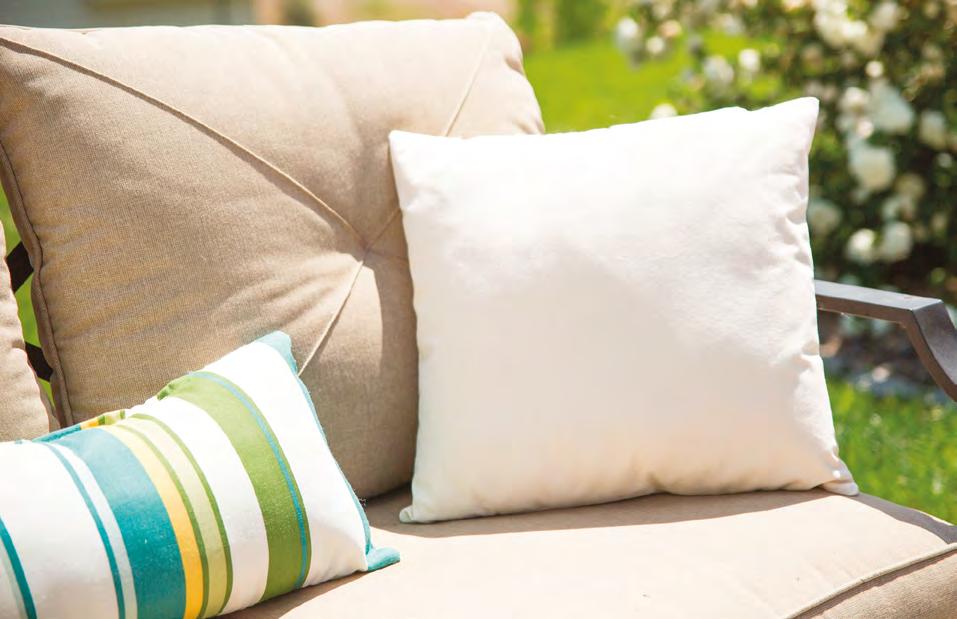
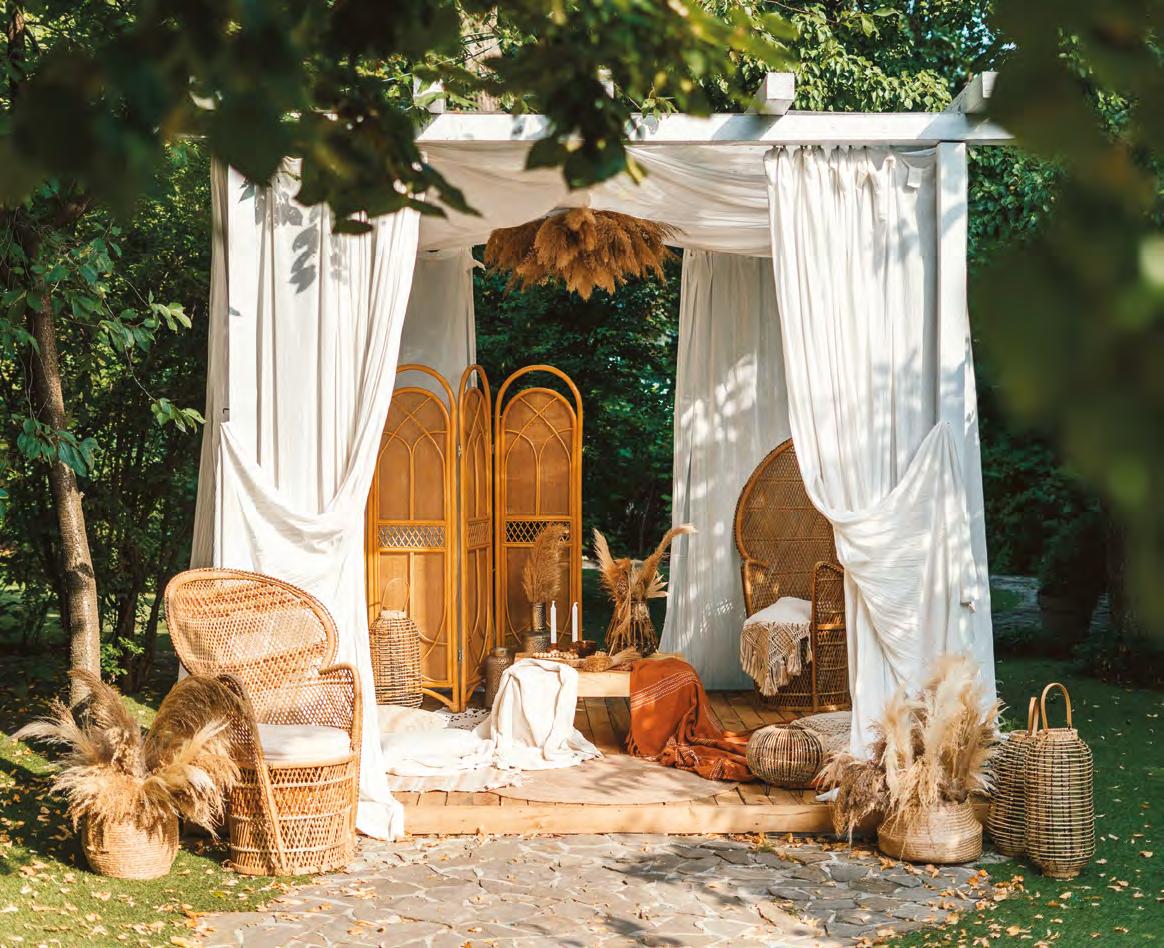
treatments, they retain vibrant colors and resist moisture. Ole n fabrics, made from synthetic bers, offer excellent resistance to water, stains, and UV rays. Perfect for outdoor sofas, armchairs, and rugs, they are prized for their longlasting performance. PVC fabrics, on the other hand, are completely waterproof and UV-resistant, making them ideal for outdoor curtains and coverings. They are easy to clean and maintain, though they may be less breathable than other options.
Selecting the right fabric depends on the specic needs of the outdoor space as well as personal preferences regarding aesthetics and functionality.
Indoors, curtains play a key role in enhancing the elegance of living spaces. Current trends favor practical, high-performance products—soft, easy to clean, visually minimal, lightweight, and monochromatic in light tones or muted shades such as dusty blue. Materials range from linen and hemp to cotton, silk, and increasingly, eco-friendly and recycled fabrics.
In terms of performance, sound-absorbing and blackout curtains are in high demand. Solar shading for outdoor curtains and related energy certi cations are also crucial, as are ame-retardant fabrics.
The blurred line between indoor and outdoor design has led companies to develop versatile
products suitable for both environments—fabrics that are highly resistant to sunlight, weather, humidity, mold, bacteria, chlorine, stains, and that are ame-retardant and hypoallergenic. Finally, it’s worth noting the importance of ongoing research in the curtain industry, which has led to the development of nishes that are antibacterial, mold-resistant, dust-mite-proof, and customizable according to diverse project needs.
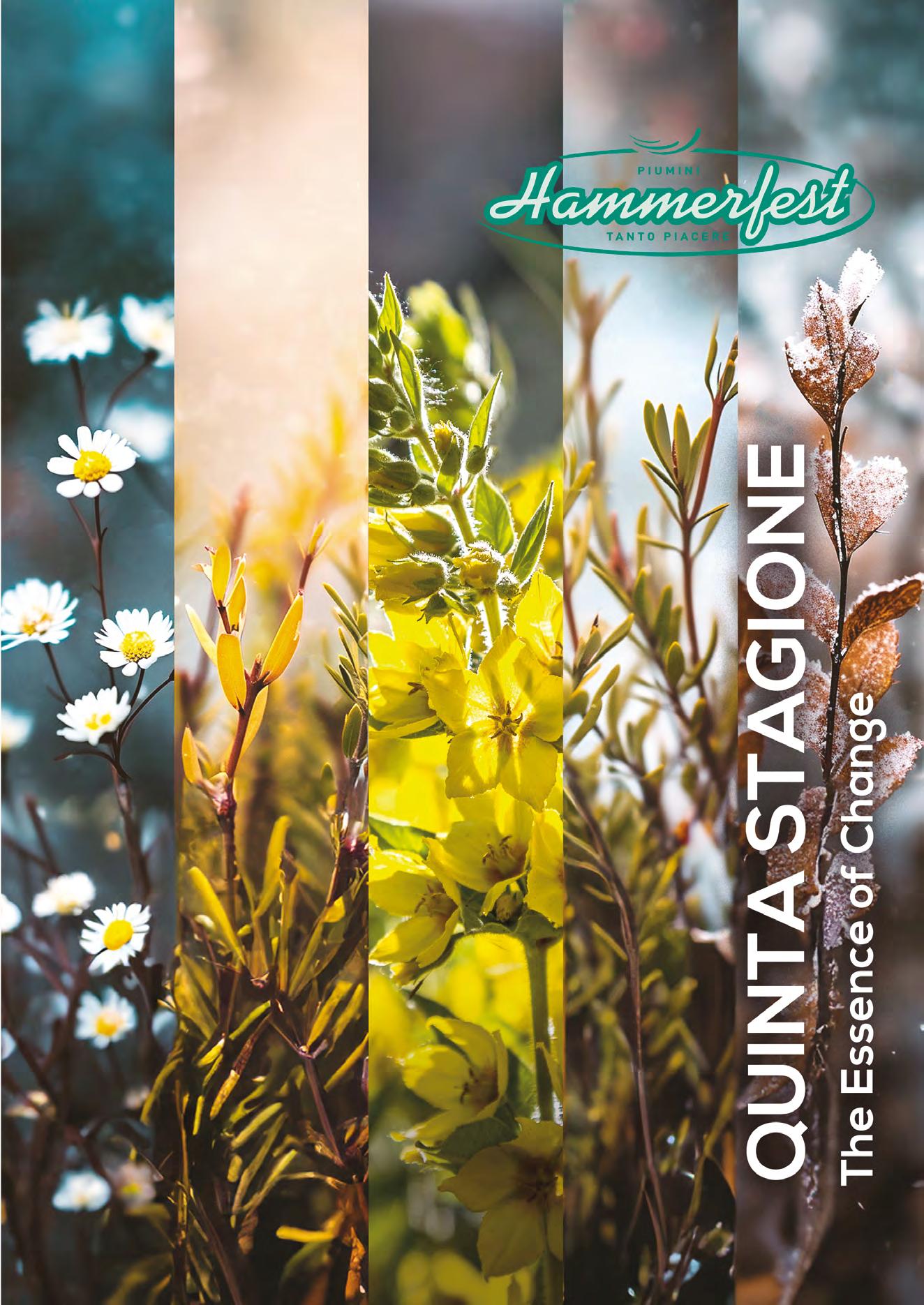
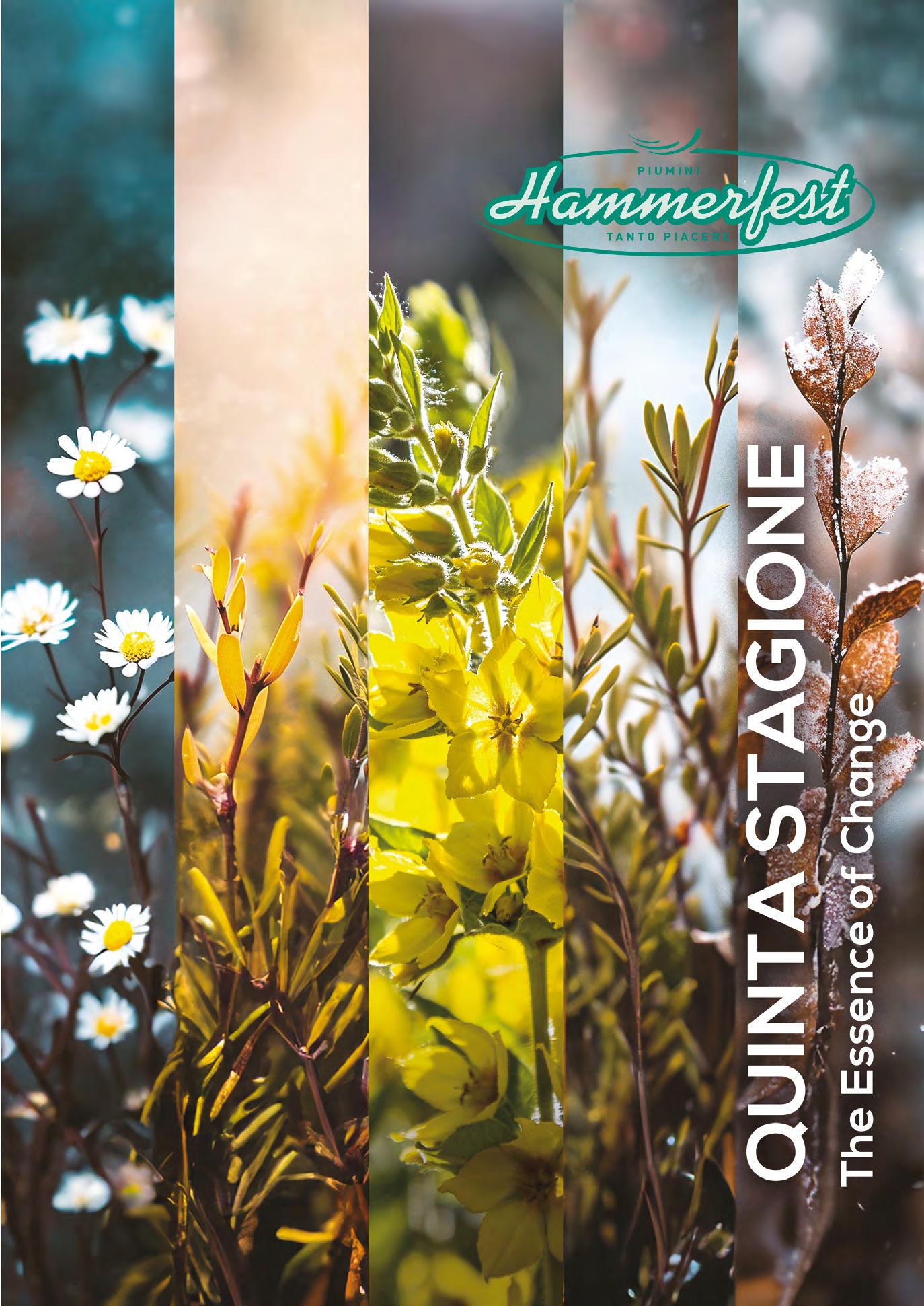
Hammerfest, a craft-based company specializing in the production of high-quality bed linen, presents the "Quinta Stagione" collection, designed to ensure comfort and functionality throughout spring, summer, and autumn
With a long-standing artisan tradition and a philosophy rooted in sustainability and quality, Hammerfest introduces Quinta Stagione, a product line conceived for the non-winter seasons. This collection captures the essence of continuous change, offering versatile solutions that adapt perfectly to the unpredictable climates of spring, summer, and autumn.
Each item is crafted using premium materials from certi ed suppliers, complying with standards such as Oeko-Tex, Nomite, GRS, and RDS. From natural cotton fabrics (percale, sateen, organic) to linen and hemp, and from feather to wool llings, Hammerfest blends craftsmanship and technology to deliver products that are beautiful, functional, and durable.
The collection offers a wide range of comfort solutions suited for milder climates. The various lines are distinguished by materials and weights, ensuring optimal thermal performance in every season.
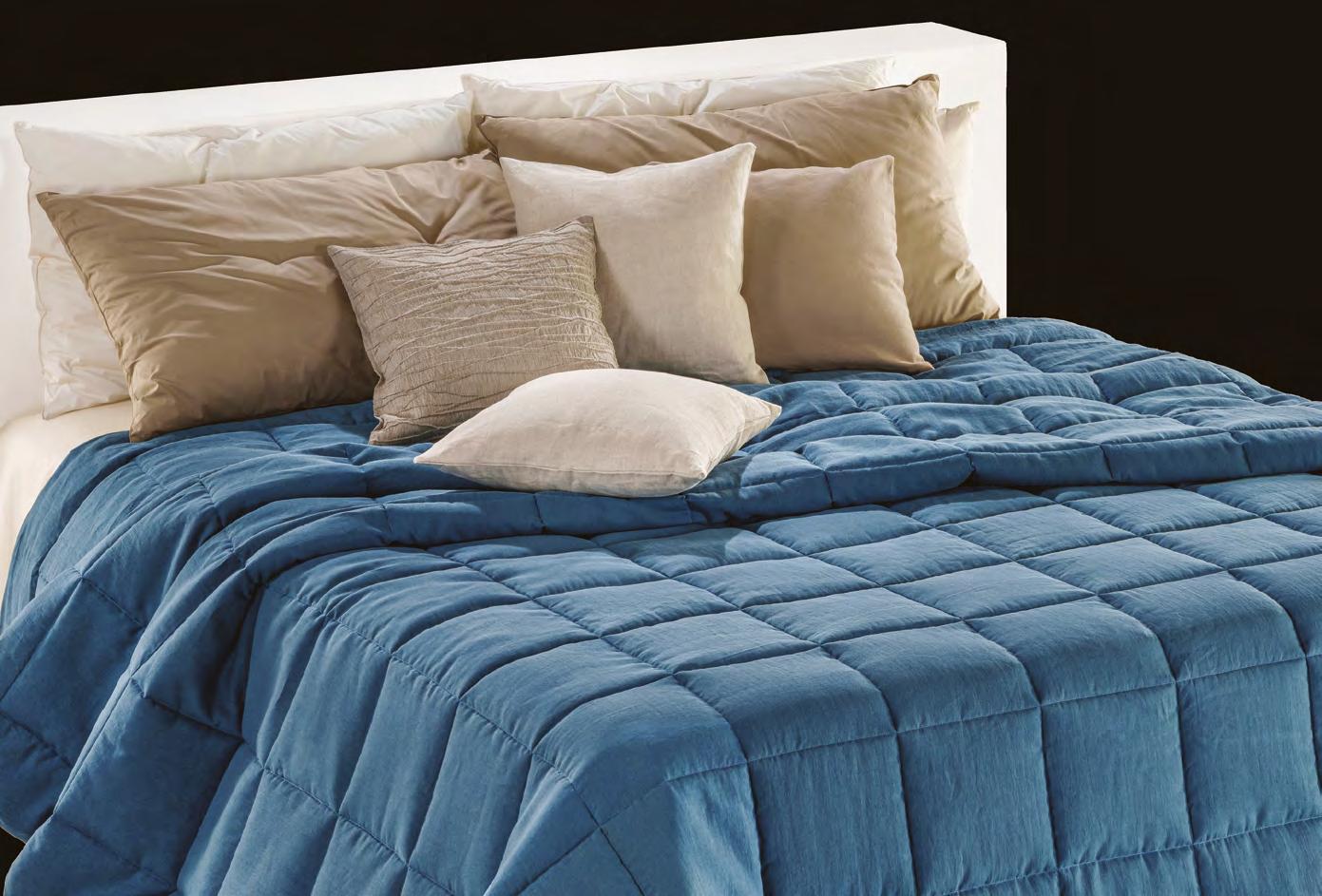

The InCot line is designed for those seeking maximum nighttime comfort. Made from natural cotton, it includes lightweight 100-gram llings, ideal for duvet inserts and quilts for those who prefer sleeping with sheets. Breathable and absorbent, cotton keeps the skin dry, providing freshness and wellbeing even on the warmest nights. For midseasons or mild winters, the 250-gram version ensures warmth and lightness, adapting perfectly to varying climate needs.
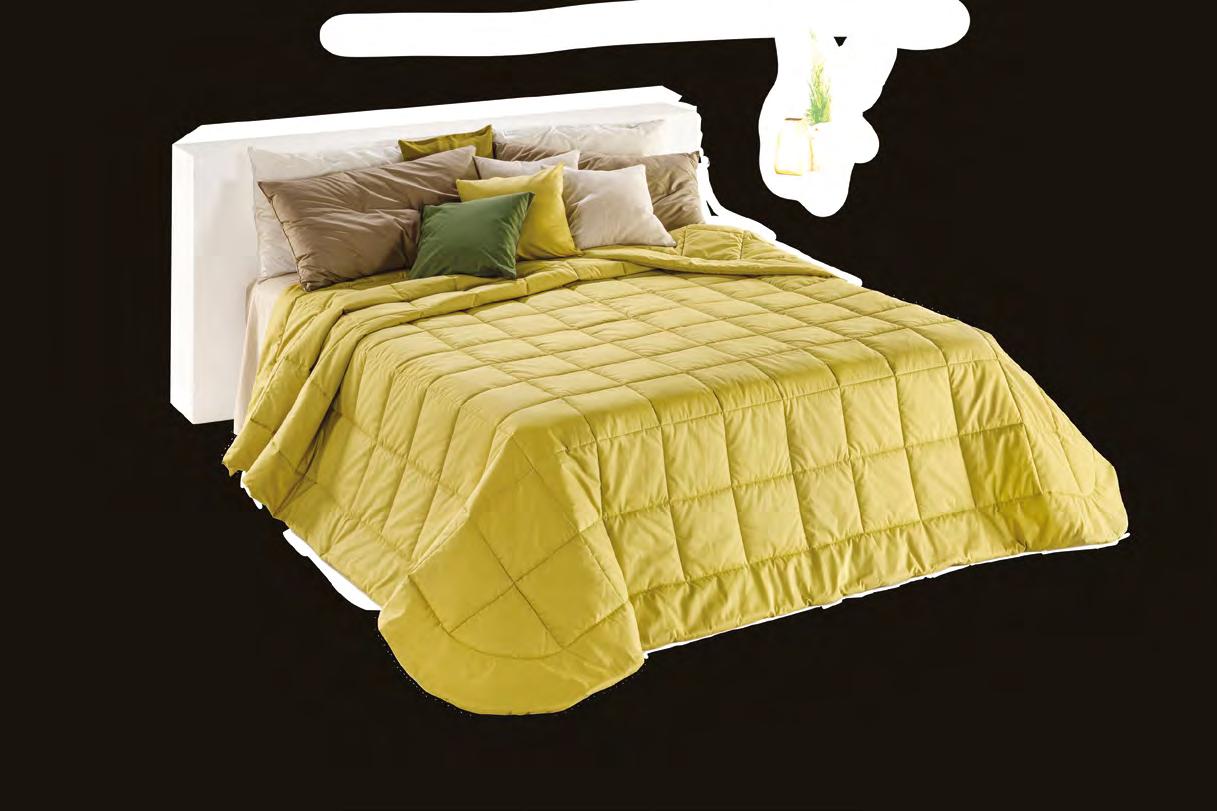

InWool celebrates wool as a sustainable and innovative ber. This line offers lightweight 100gram llings, perfect for duvet inserts and quilts. Wool is breathable and allows the skin to breathe, absorbing moisture and gradually releasing it into the air. InWool products are crafted in Italy using recycled, reclaimed, or surplus natural bers, following an innovative process that eliminates the need for additional chemicals. The result is an elegant, functional, and eco-friendly product.
The Iglù line combines the value of natural down with a versatile design for every season. Iglù Light items and Nuvola quilts are perfect
for summer or temperate climates thanks to their unique lightness. For transitional seasons and milder winters, the Iglù Medium and Clima quilts offer the ideal balance between warmth and breathability. The Iglù Twins down duvet, with four different weights, is an all-year-round solution, adaptable to any weather condition. Each product is designed to ensure comfort and longevity, using carefully selected materials that respect nature.
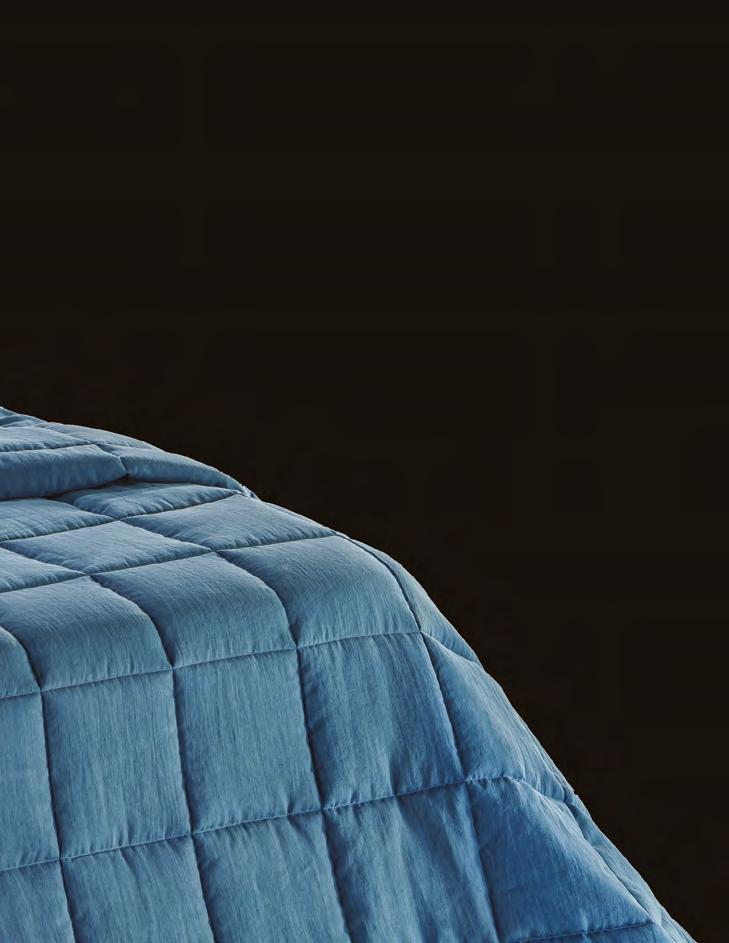
The InSof quilts, light quilts, and duvet inserts feature a soft and lightweight padding made with 75% regenerated
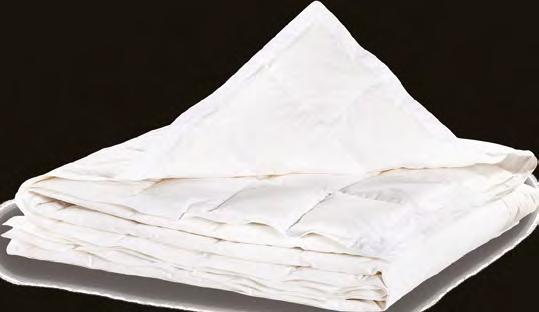
Iglù, a box-stitched quilted duvet, available in various filling qualities, a range of fabrics, and different sizes and styles.
InSof is a highly versatile, multi-season offering. The duvet inserts and quilts are available in 100- and 200-gram weights, ideal for mild climates, while the 300-gram version is perfect for colder winters. The “4 seasons” option combines multiple weights for modular use. The line features a soft padding made of 75% regenerated bers, blending lightness, sustainability, and meticulous artisanal care in every detail. www.hammerfest.it


Métamorphose by Lelièvre, the maison that has embodied French style since 1914 with its collections of fabrics, wallcoverings, and bespoke rugs, is the new collection that plays with patterns to define a different style each time. Take Halo, for example, which, with its gradients of color on extra-wide 100% cotton prints, evokes the hues and light of the sunset.
by Francesca Guerini Rocco
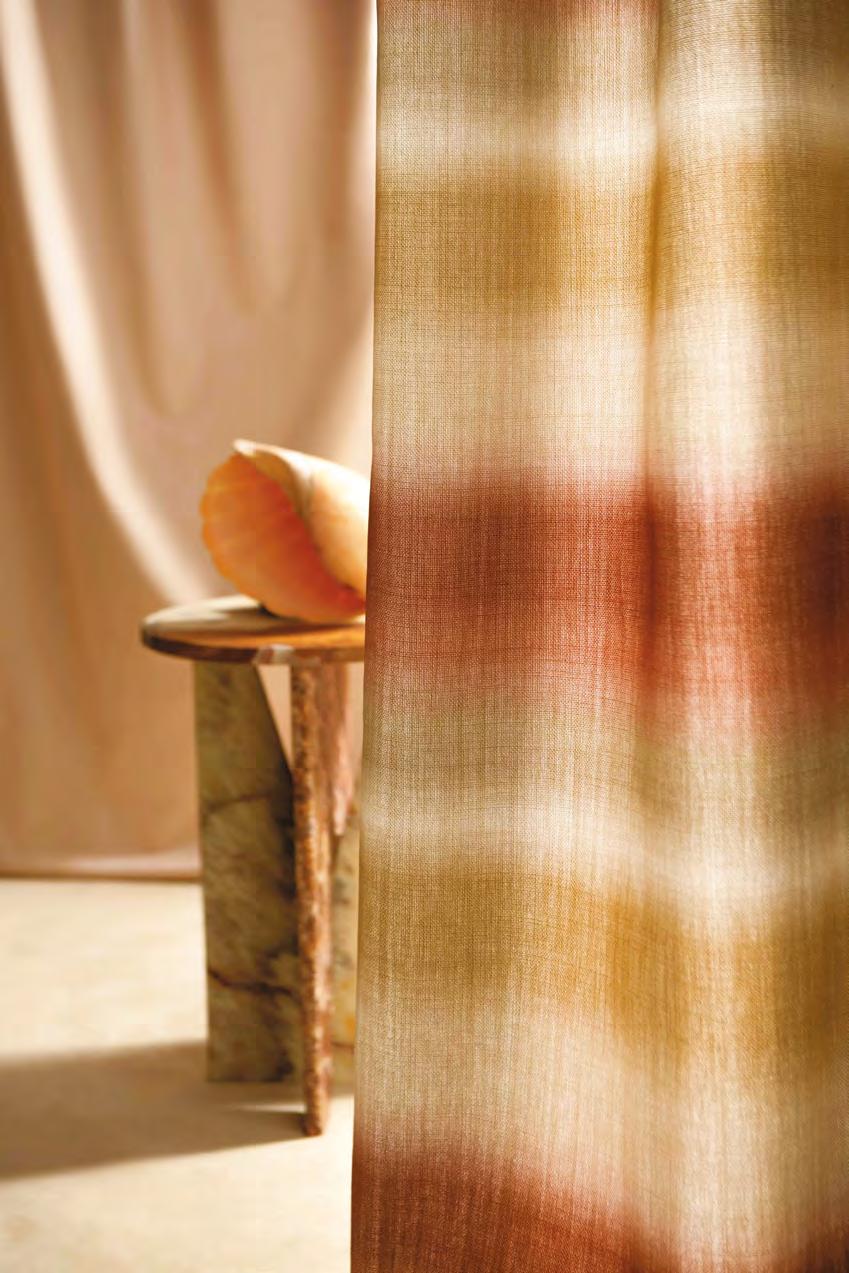

As usual, the new year kicked off with a series of trade fairs dedicated to the world of textiles (Déco Off, Déco Home, Heimtextil, as well as Maison&Objet and Ambiente), showcasing a wide array of offerings for both interiors and outdoor spaces. Chic, sophisticated, surprising, yet highly functional, the 2025 textile trends combine technical innovation with sustainability, while placing a strong emphasis on material research. The goal is to ensure awnings, wallpapers, cushions, and rugs perfectly meet the needs of contemporary living, both in the living room and on the terrace
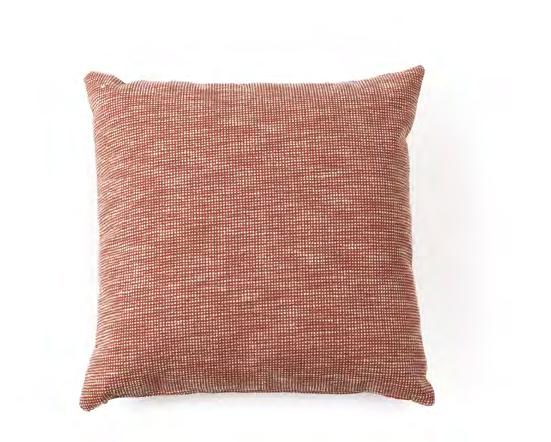
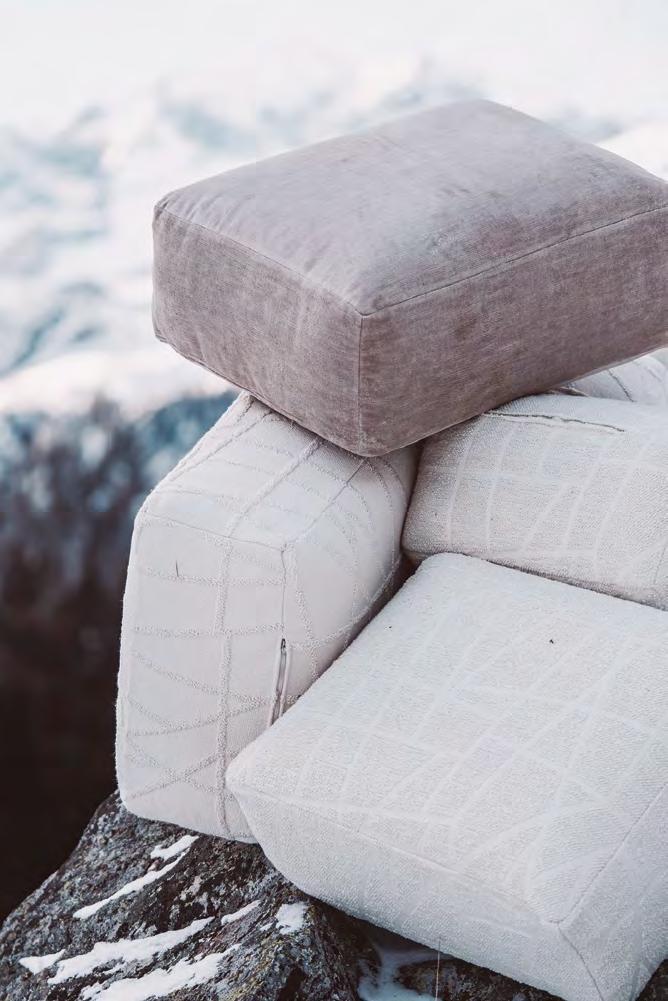
Brochier Como, the premium brand of Clerici Tessuto Group dedicated to high-end interior fabrics, unveils its new Liaison collection, celebrating the harmony between seemingly distant seasons and styles, summer and winter. These two moods are expressed through a variety of fabrics, from lightweight and airy to dense and textured (including linen, jacquard, and fine wool bouclé), ideal for contemporary, year-round curtains and upholstery.
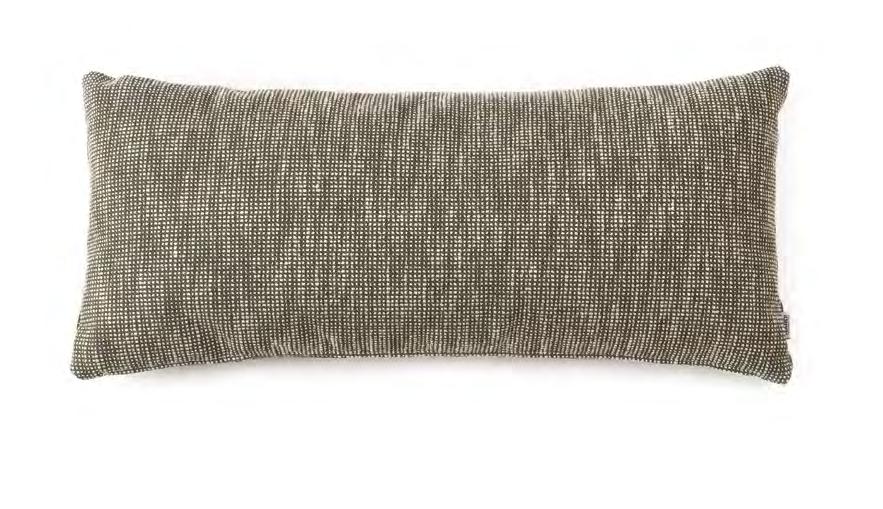
Nardi enhances outdoor relaxation areas with its new decorative cushions designed for the modular Maximo sofa. Made of 33% recycled Sunbrella® Acrylic, 65% Sunbrella® Acrylic, and 2% Polyester, they are available in four colors—cinnamon, pearl, thyme, and lava—and three sizes: 50x50 cm, 60x40 cm,
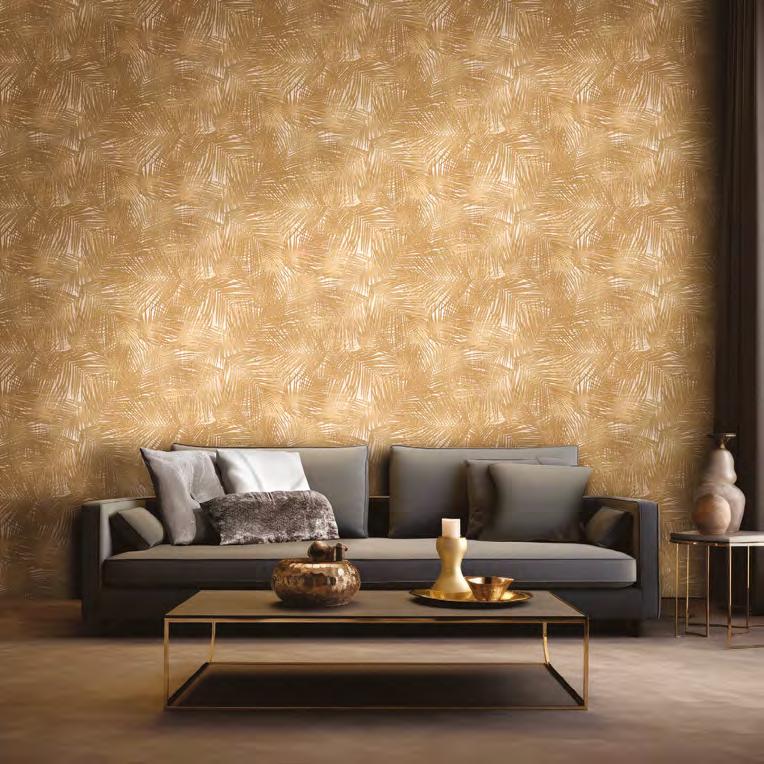
Zambaiti Parati renews its collaboration with Automobili Lamborghini with the launch of the new Automobili Lamborghini Wallpaper Collection: Vol. III. Featuring wallpaper rolls covering 7 sqm each, the collection draws on the iconic colors of the automotive brand and showcases a series of natureinspired graphics, from tropical foliage to stucco-effect textures, all enhanced with 3D patterns.
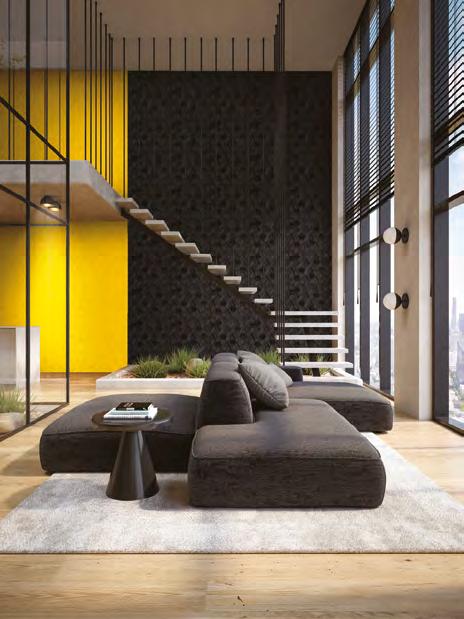
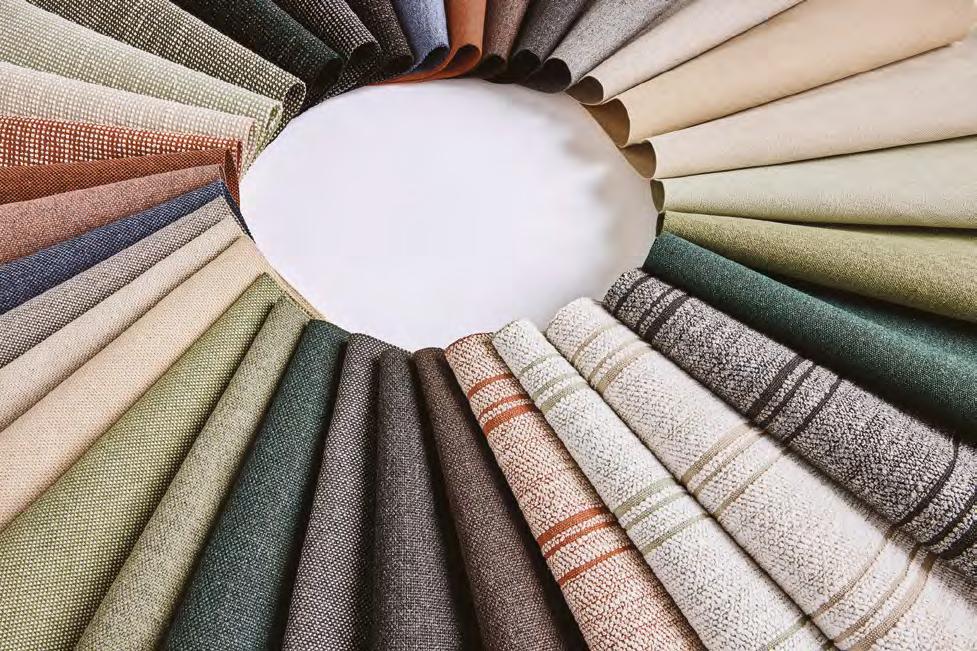
Among the leading brands in technical fabrics for indoor and outdoor use, Sunbrella has been producing recycled textiles for over 10 years and now introduces a collection fully dedicated to recycled yarns: Endless Stories. Composed of up to 50% recycled fibers from its production process blended with virgin Sunbrella fibers, the collection offers softness, vibrant colors, and outstanding performance. It includes the Heritage family in new shades, Source, inspired by the timeless Natté weave, Slow, featuring a knitted texture, and Harvest, with contemporary stripes.
The new L’Echappée collection by Métaphores (part of the textile division of the French maison), designed by art director Emilie Paralitici, conveys refined elegance through a blend of English landscapes, exotic moods, and oriental inspirations. Among its wide array of designs, six models are specially crafted for outdoor use, made with carefully selected European fibers that are resistant to UV rays, salt, and chlorine.
Meticulously hand-woven or knotted by skilled artisans using Olyna® yarn — a fully eco-friendly, high-tech man-made fiber meeting the highest standards of durability and sustainability — Nodo rugs ensure maximum performance in any weather condition, thanks to their resilience, longevity, and ease of maintenance. Their sophisticated design and variety of shapes and sizes make them ideal for both outdoor and indoor settings.
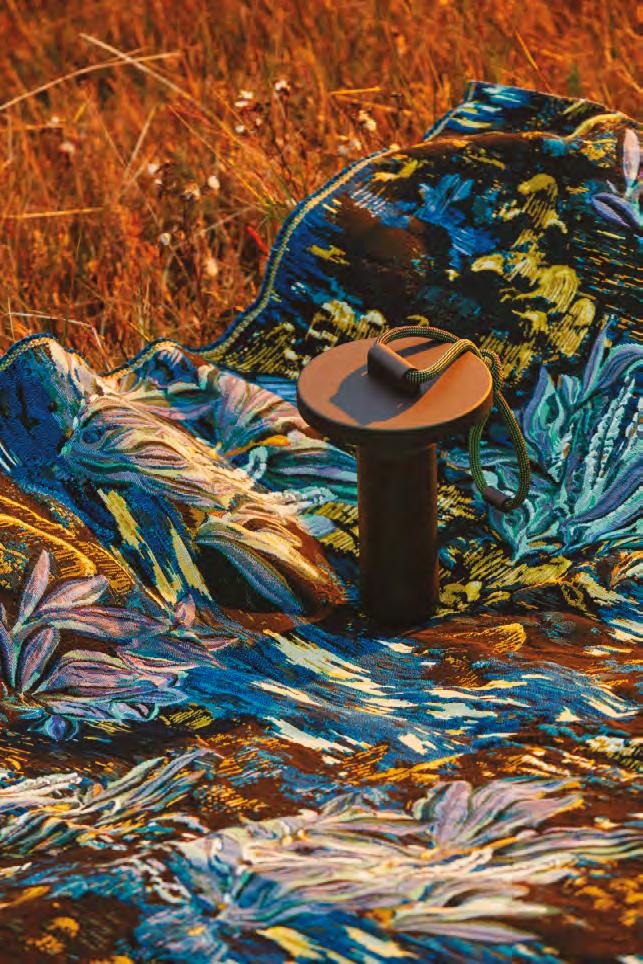
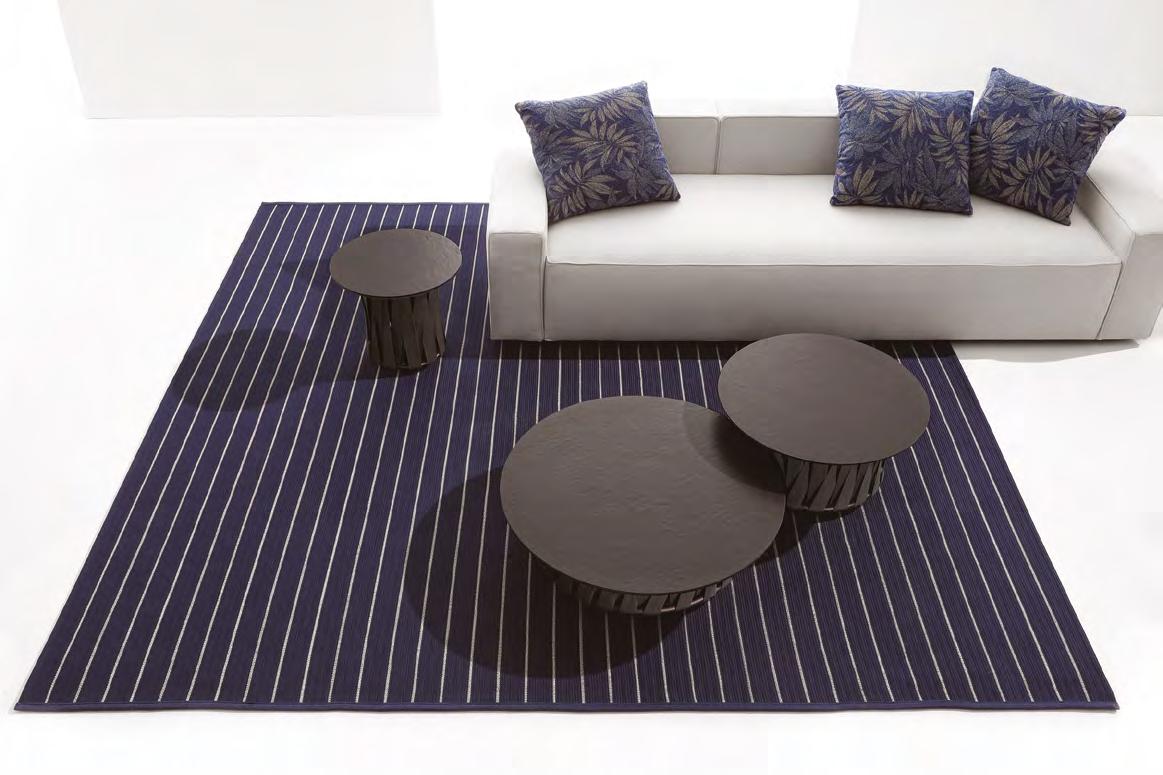
Dickson, the French textile brand that has been creating highperformance, design-driven technical fabrics since 1836, introduces two new collections: Infinity and Opera. Infinity is a large-width solution that adapts to any solar protection system thanks to its four available widths (165 cm, 200 cm, 250 cm, and 320 cm), allowing for custom-made sun protection without seams. Opera, on the other hand, is a jacquard fabric for awnings with a strong decorative appeal: the patterns are printed on both sides.
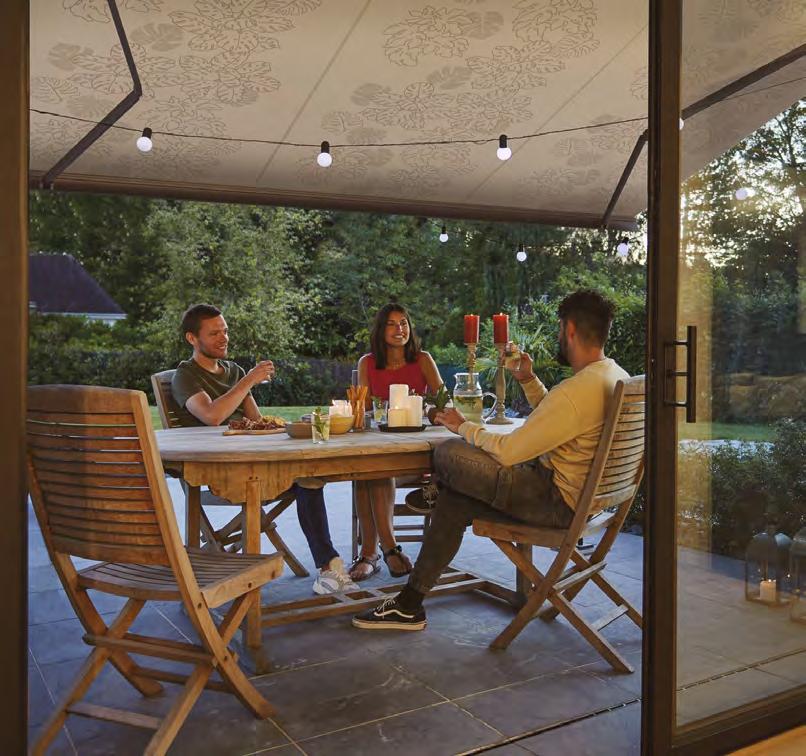
Renowned for its silk and luxury fabrics, Rubelli expands its offering with Teorema, a collection designed by Formafantasma. It blends wool warps, chenille wefts, reimagined chevron patterns, and more technical yarns tailored for contract applications, creating an eclectic and innovative style. Among its many visionary designs: Sophie Frank’s 3D-effect motifs, the geometric patterns of Zigzag, and the nature-inspired designs of Leyla.
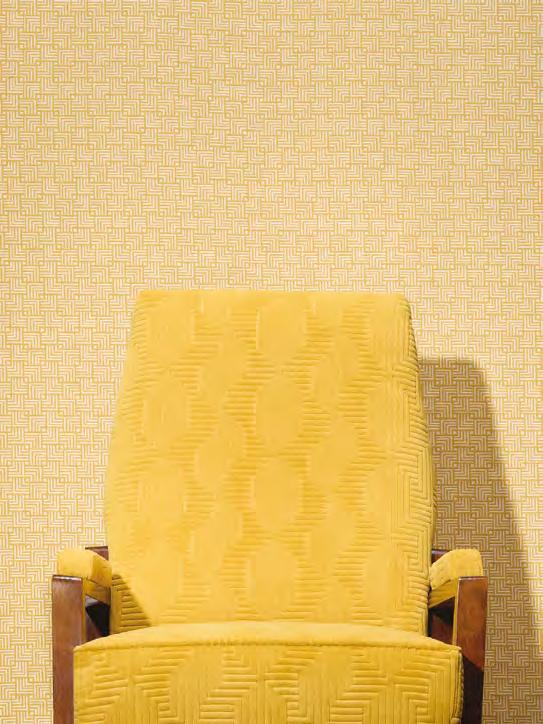
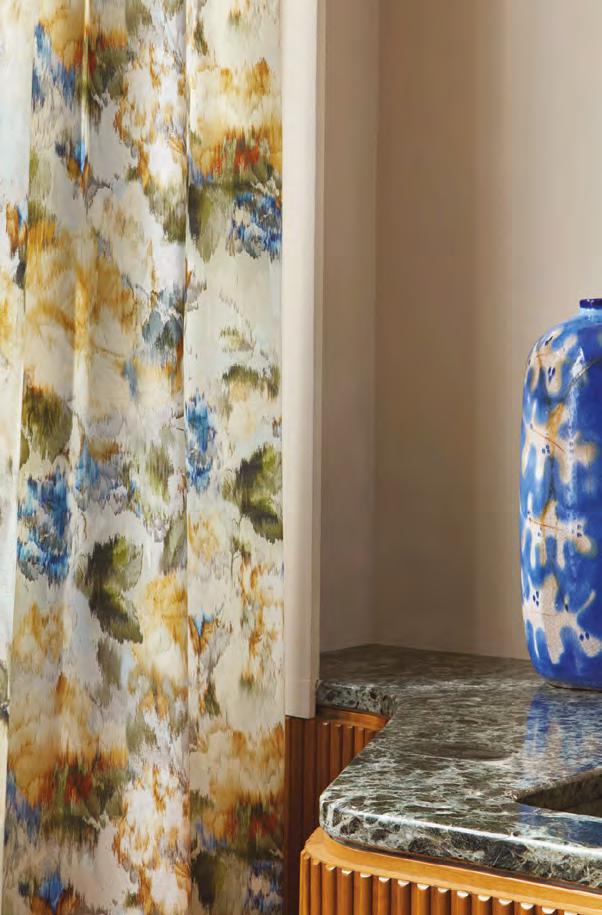
Fischbacher 1819, in collaboration with designer Marcel Wanders and artist Caterina Roppo, presents Ancient Memories, a fusion of textile history, archaeology, creativity, and pure experimentation. A standout piece from the collection is Pastoral Wave, a glamorous and contemporary curtain featuring a faux-fur effect created with long hemp threads woven into a delicate silk warp.
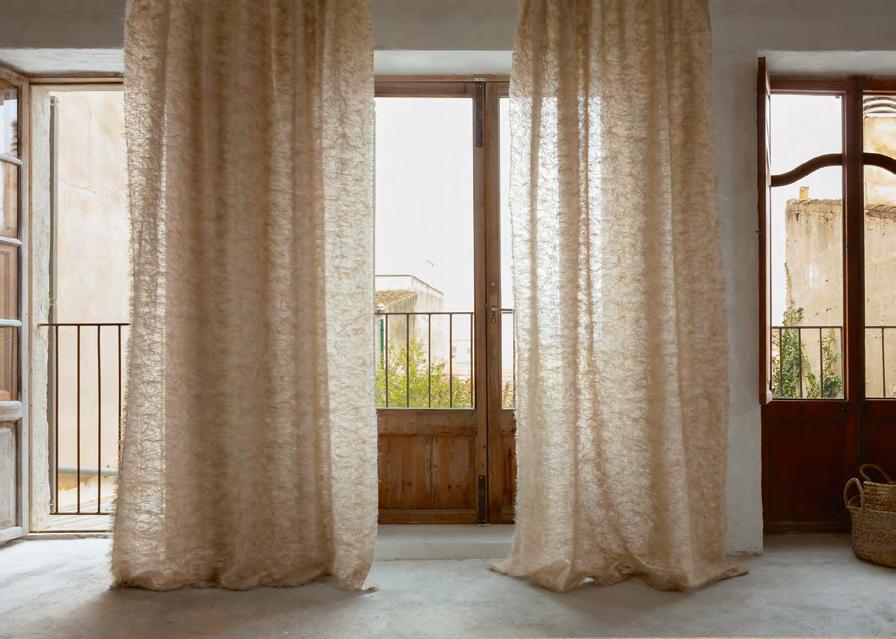
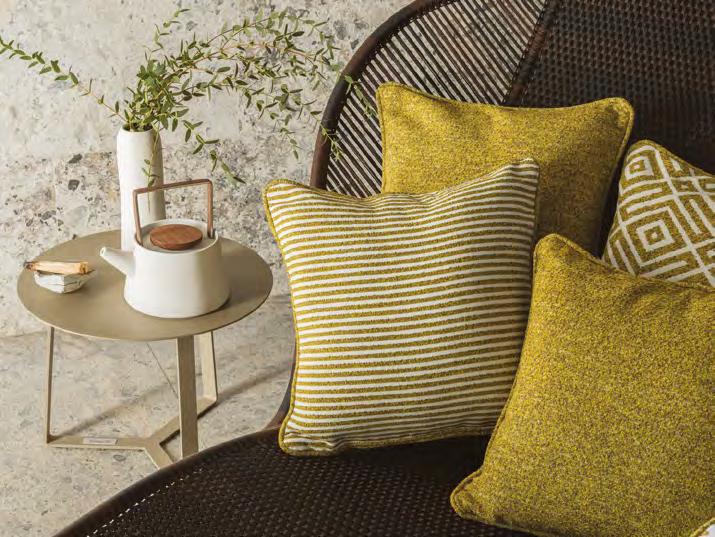
Alessandro Bini, the Florentine company specialized in premium furnishing fabrics, launches the new Cap Ferrat collection, curated by Palomba Serafini and Associati, designed for both indoor and outdoor spaces. The collection features three coordinated fabrics: the geometric Emerald, the solid Plain, and the striped Stripe, all with a bouclé effect made from mélange yarns and treated with a “fluoro-free” finish, increasingly requested by the US market.
Exclusive fabrics designed with a focus on technology, craftsmanship, and sustainability; endless colors and outstanding performance that ensure superior durability, certified recyclability, and easy maintenance. To dress outdoor spaces, Paola Lenti offers a range that spans from the deliberately irregular, three-dimensional bouclé textures of Moss and Whim, to the multicolored gradients of Rope T mélange, and the new nature-inspired patterns of Roseto, Felce, and Jabel. Artisanal yet highly technical, these fabrics are also ideal for nautical applications.
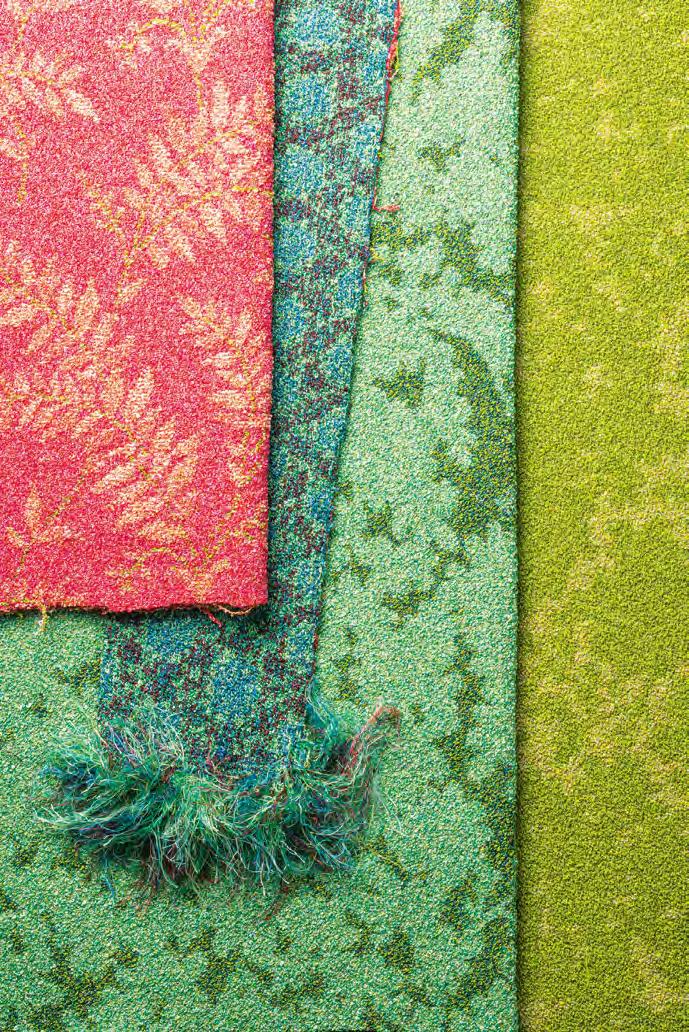
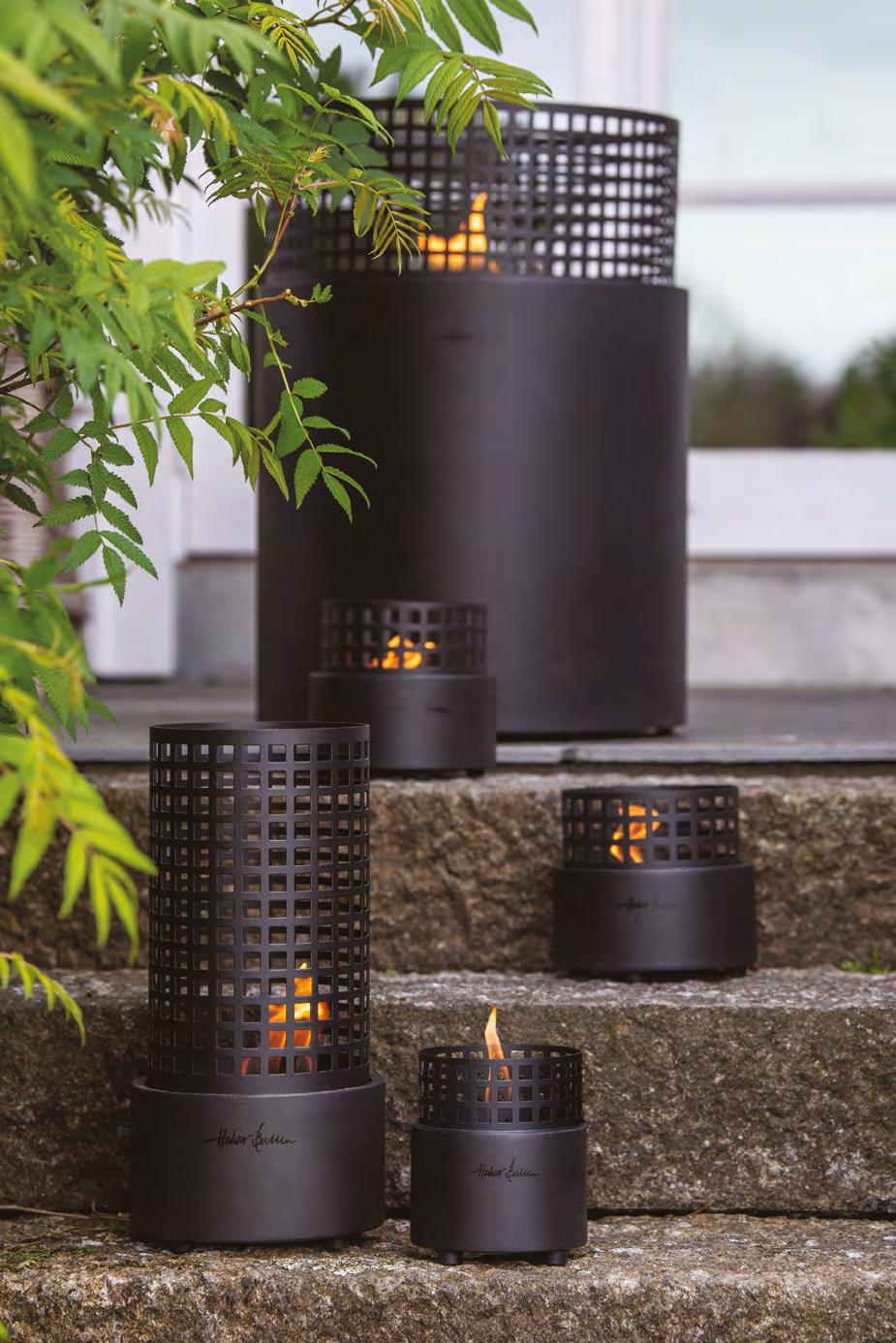
A classic plant pot, a small table that can double as a seat, a lamp to create the perfect summer evening atmosphere, and even a playful, unexpected pet accessory. Whether it's a small balcony or a spacious garden, making an outdoor space welcoming is all about choosing the right accessories. Here are some new arrivals: weather-resistant, easy to move (indoors and out), and always with a touch of design
Tenderflame, part of the Kunzi group, draws inspiration from South African landscapes and the traditional colonial architecture of Cape Town to present a collection of candles, lanterns, and outdoor fireplaces. They are refillable with TenderFuel, a non-toxic and eco-friendly liquid that burns safely and cleanly, only when in contact with the wick, producing no odor or soot. Available in five different sizes.
di Francesca Guerini Rocco
Folia, the original stool-table designed by Luca Nichetto for Ethimo, takes cues from traditional wrought iron gates and reinterprets the craft into an outdoor furniture piece perfect for balconies and terraces. Durable, stackable, and available in several colors.
To meet the need for decorating small green spaces, both indoors and out, S-CAB presents its plant holder collection, designed for wall or floor use and paired with matching pots, also available in a limited-edition color. Designed by Ionna Vautrin, the Mimosa collection is made of powder-coated steel and is fully disassemblable and recyclable.
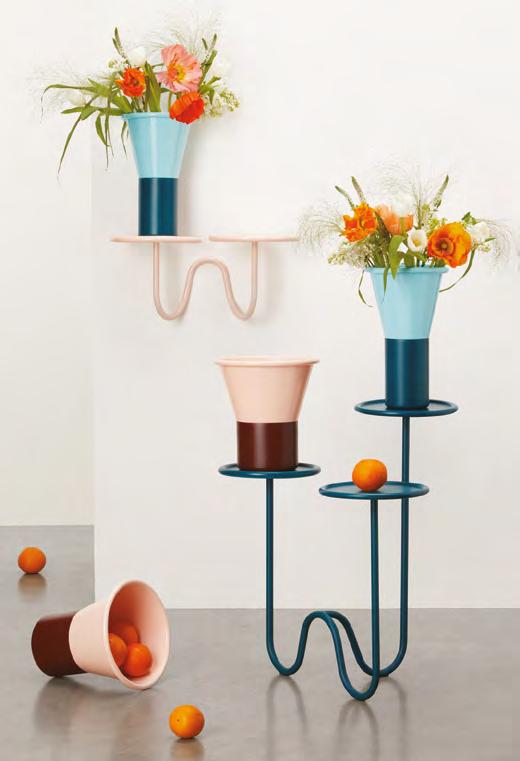
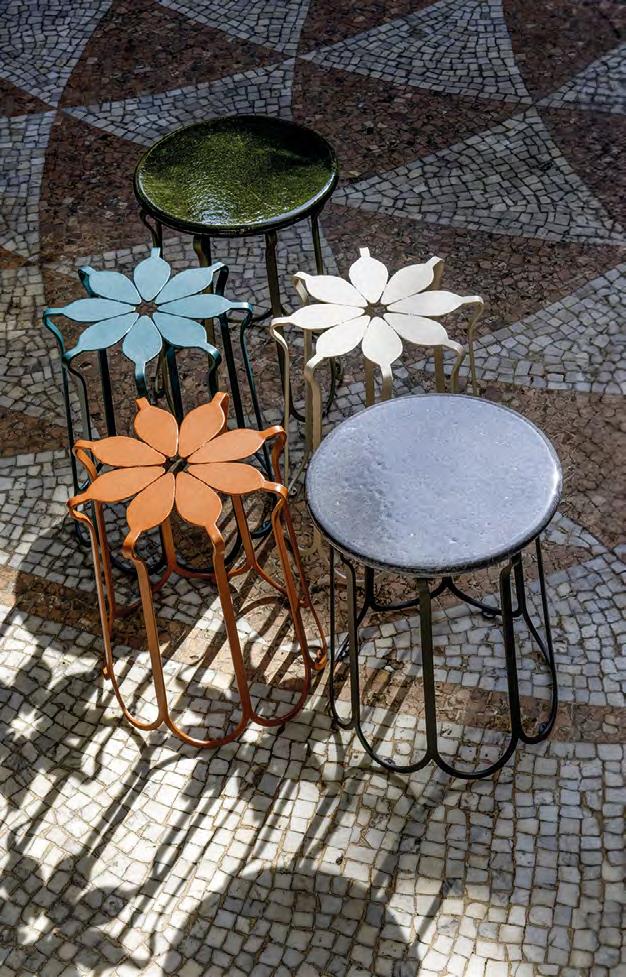
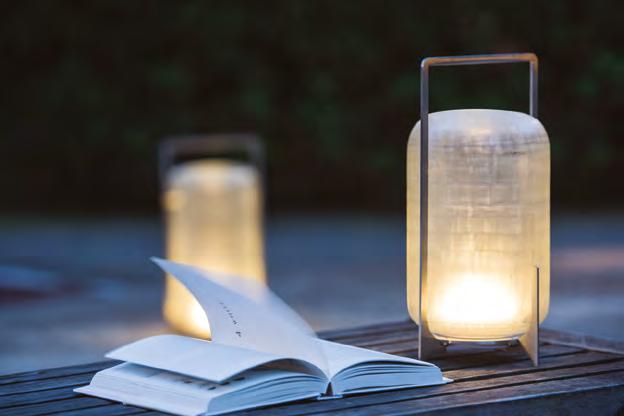
Dimmable and supplied with a remote control, the Twilight outdoor lantern by Warli features an opaline blown glass diffuser, finely handcrafted with engraved detailing, a stainless steel structure—either satin-finished or powdercoated—and a wireless induction charging base with mini USB port. It offers up to 6 hours of autonomy and comes in three sizes.
Slide celebrates the tenth anniversary of the calligraphic bench designed by Giò Colonna Romano with Amore Ocean, a new eco-friendly edition. It comes in two shades: Pacific Green, made from marine ropes, and Atlantic Blue, created from recycled fishing nets.
Practical, playful, and multifunctional: Fatboy’s trolley is a true Jolly in name and nature. Suitable for both indoor and outdoor use, it is made of powder-coated aluminum and features a handy 5watt dimmable lamp with a rechargeable USB battery lasting up to 12 hours. It can be used as a serving cart, étagère, or side table.
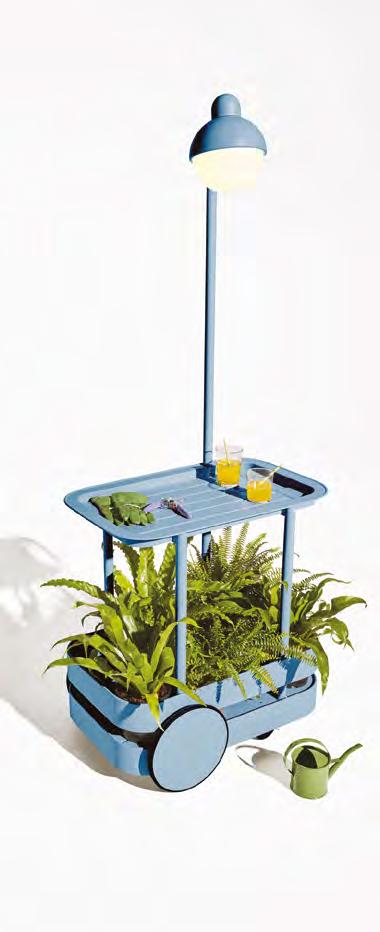

An eternal classic: the iconic garden gnome reimagined by Philippe Starck for Kartell. Attila combines humor with functionality: crafted from ultra-resistant thermoplastic technopolymer, it’s designed to serve as a side table or stool. The collection also includes the Napoleon and Saint-Esprit versions. Dimensions: 34x41h cm.
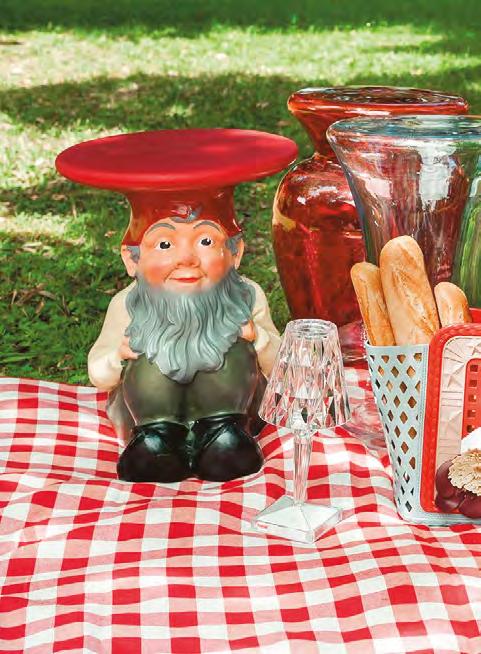
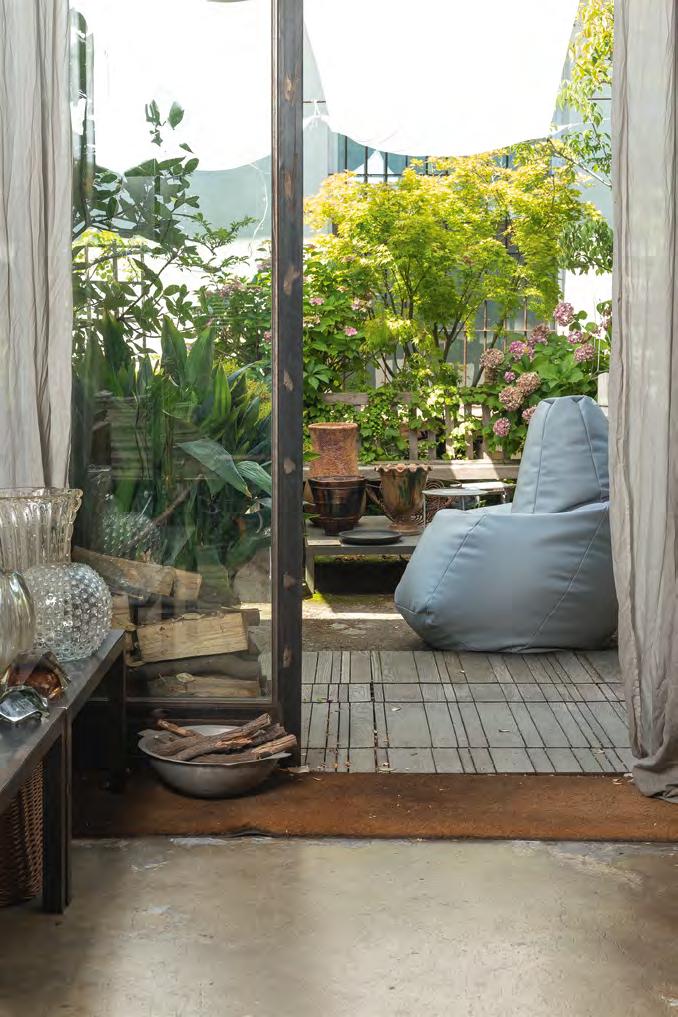
Since 1968, the iconic Sacco armchair by Zanotta—designed by Gatti, Paolini, and Teodoro—has been a design icon, still proudly on display both indoors and out. The outdoor version features a Vip cover, antibacterial thanks to Silverguard® treatment and stain-resistant with Permablock 3® finish.


Romantic and delicate, the Lilli rechargeable table lamps by Zava feature a base, top, and handle available in various metals (iron, aluminum, brass, copper) and a pleated-effect glass diffuser. The LED light source is dimmable and solar-rechargeable. Available in two sizes: 17x34 cm and 17x47 cm.
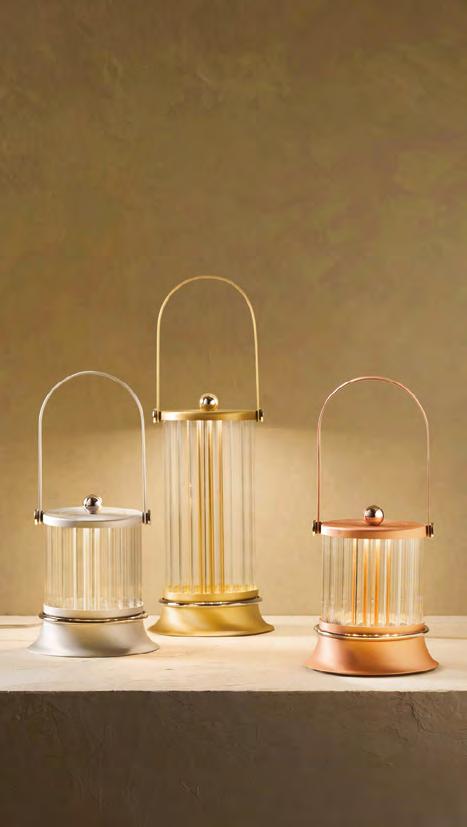

Looking for an alternative to the classic garden or poolside pathway? Sassopasso by Il Giardino di Corten offers elements made from corten steel sheets in various shapes (oval, elliptical, heart-shaped, irregular “footprint,” and rectangular), also available custom-made. Perfectly flush with the ground, non-slip, lightweight, and weather-resistant, they even allow lawnmowers to pass without needing to be moved.
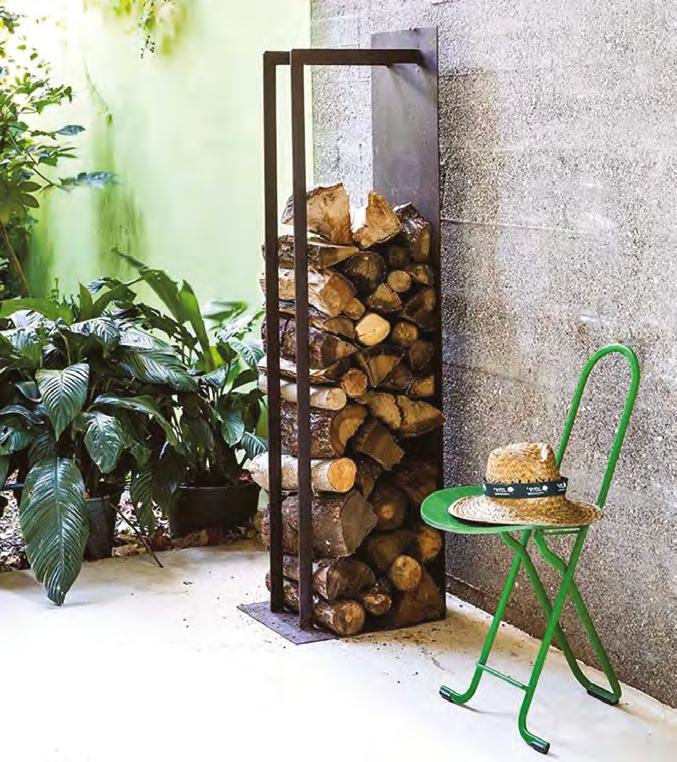
Poppy by Tenderflame is the perfect table lantern for creating a cozy and intimate atmosphere indoors, on the terrace, or under the porch. Refillable with TenderFuel, even while lit, it features a lively flame that burns safely and cleanly. Available in two sizes and two color options.
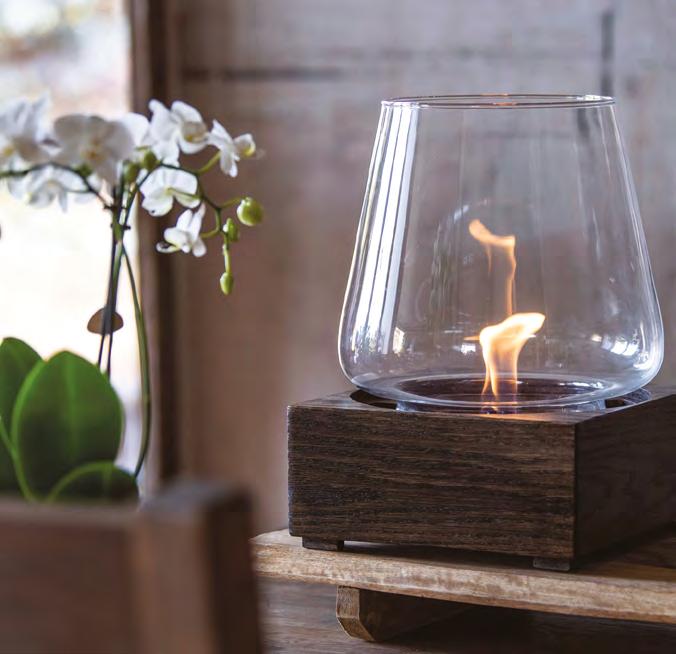


A woven totem that lights up your outdoor space: Susy is the new lantern from Nodo Italia, designed by Antonio Marras. Lightweight and easy to carry thanks to its aluminum frame with handle, it’s made from Olyna™ ropes, an innovative and 100% recyclable yarn. The lantern can be customized by combining three different sizes.
Eracle by I Giardini di Corten is a sturdy, spacious, and compact log holder that turns stacked firewood into a decorative feature, whether under a porch or on a terrace. Made from robust corten steel, it withstands all weather conditions and is available in two sizes.
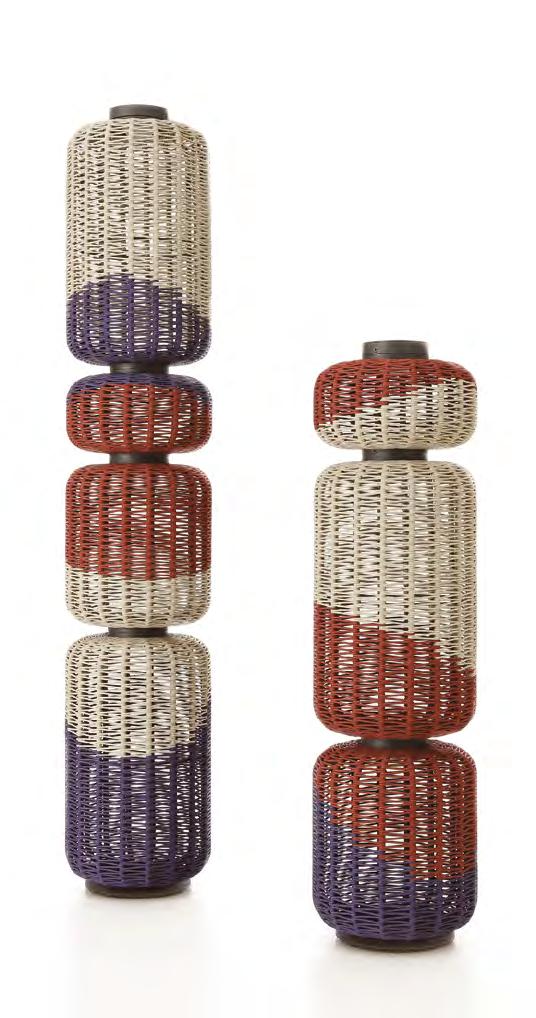


Seletti dresses outdoor spaces in cobalt blue with Magna Graecia, a collection created in collaboration with Antonio Aricò, inspired by the style of the ancient Greek colonies of southern Italy. Entirely made of terracotta, the vases, bowls, amphorae, and capitals are designed to decorate gardens, terraces, verandas, as well as entryways and living areas.
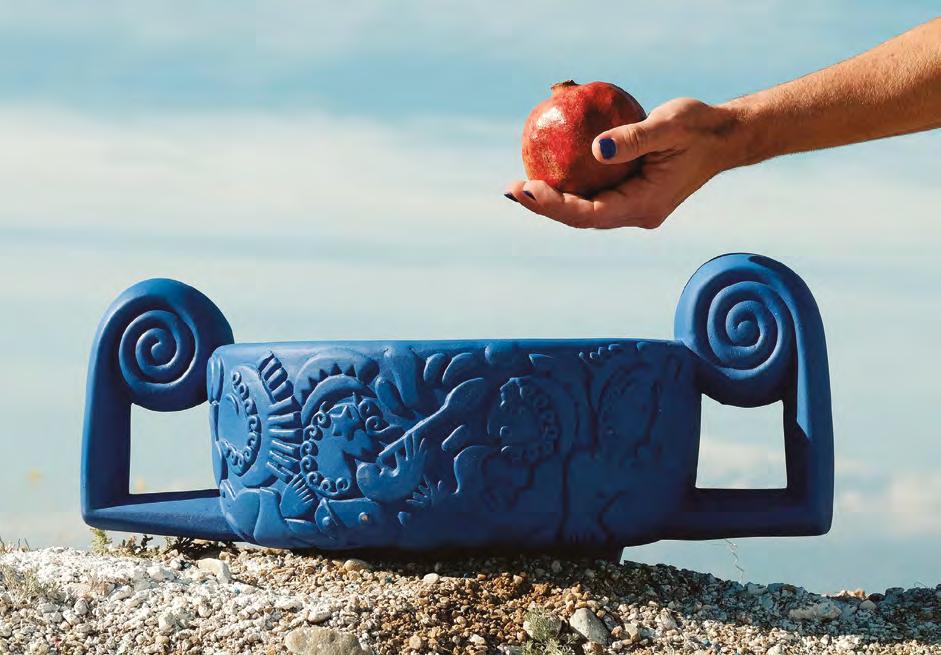
A sweet garden dweller, Bonnie the hedgehog by Alessandra Baldereschi joins bird Paloma and dogs Otto and Doggy to keep us company. Made of 100% recyclable low-density polyethylene, it is resistant to all weather conditions (from -35°C to +80°C), UV rays, and impacts. Also available as a light-up version.
Among the standout outdoor proposals for 2025 are the Ripple lamps by Gervasoni, available as both floor and pendant models. Made from Tyvek®, a surprisingly light yet durable material, these lamps feature a texture reminiscent of crumpled paper but with the strength to withstand outdoor use. The circular, floating shade is supported by a metal frame for added stability.
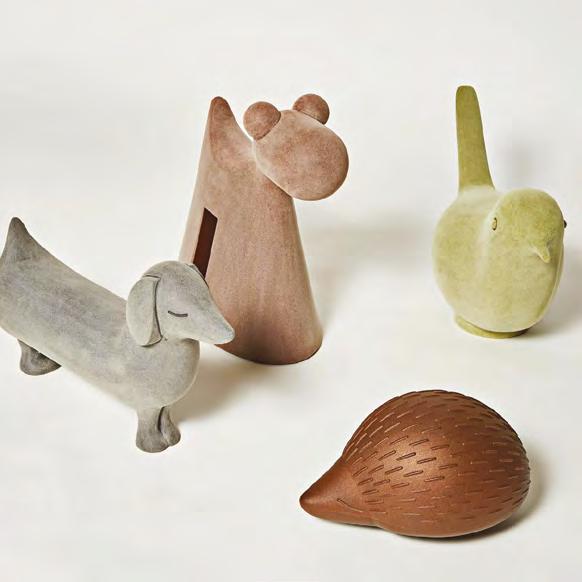
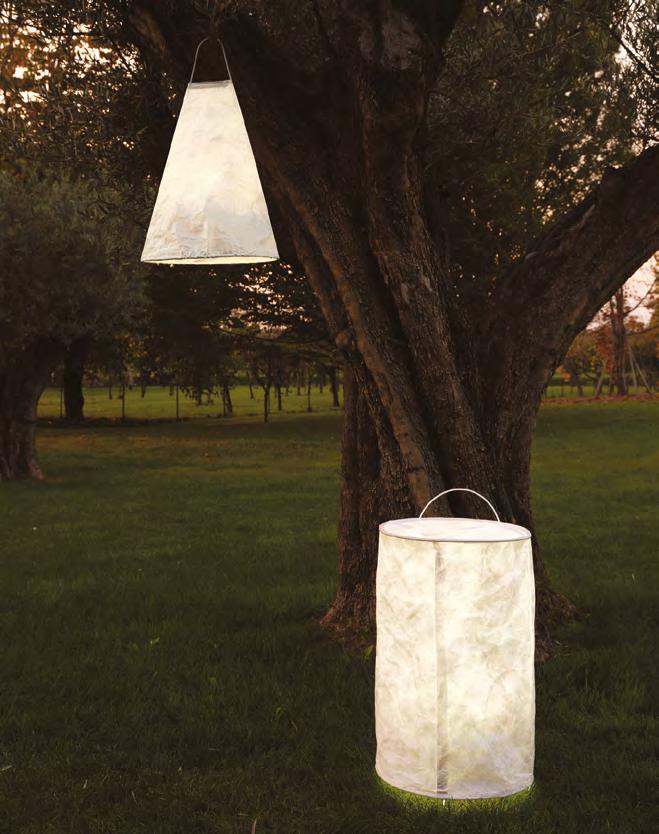
A classic way to keep mosquitoes away? Citronella candles, like Garden Rosa, Rustic Jade, and Rustic Yellow Citronella by Notino. They release a pleasant citrus scent and, thanks to their vegetable wax and cotton wick, offer long-lasting burn time.
